Paul van Yperen's Blog, page 119
July 6, 2022
Sleepy Hollow (1999)
Sleepy Hollow (1999) is an American Gothic Horror film directed by Tim Burton. The film is based on the short story 'The Legend of Sleepy Hollow' by Washington Irving, published in 1819, which gets a few new twists. The film stars Johnny Depp and Christina Ricci, with Miranda Richardson, Michael Gambon, Casper Van Dien, Christopher Lee and Jeffrey Jones in supporting roles. Memory Card made a series of postcards of lobby cards of the film.
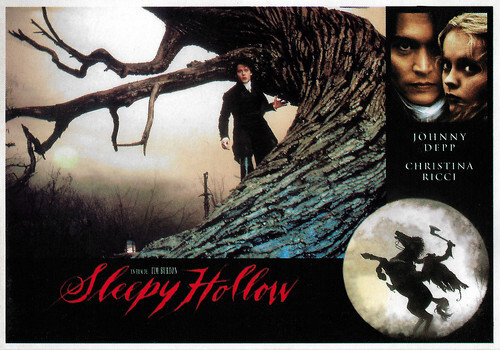
British postcard by Memory Card, no. 612 (Lobby card). Johnny Depp in Sleepy Hollow (Tim Burton, 1999).
People are mysteriously beheaded
The story of Sleepy Hollow (1999) begins when scientist Ichabod Crane ( Johnny Depp ) tries to convince the court of justice in 1799 New York of his new, forensic methods of solving crimes. A method that meets with a lot of resistance, at a time when, even in the court of law, methods based on superstition and the supernatural are still highly valued.
To prove himself right, Crane goes to Sleepy Hollow, a settlement of Dutch colonists in the state of New York, where mysterious things seem to happen and people are mysteriously beheaded. After a long journey by carriage, Crane arrives in the village. There he is informed of the existence of the "rider without a head" who haunts the woods and occasionally comes to crush a villager.
Initially, Crane does not believe the story and sets out to find the real killer, until he discovers that the apparition does exist. The headless horseman (Christopher Walken) was once a Hes, a cruel Germanic mercenary in the American War of Independence who entered the war not for money but for pleasure. To look even more fearsome, he had sharpened his teeth to a point.
One day, however, he was chased into the woods of Sleepy Hollow and finally decapitated by his own sword. For some months now, the horseman has been resurrected, beheading people from the village and taking their heads with him. After some time, Crane begins to suspect that the horseman does not kill at random, but that he does so at the behest of someone, a person who owns his head and therefore has power over the horseman.
Eventually, he manages to eliminate this person and give the rider his head back. Finally, with the beautiful Katherine van Tassel (Christina Ricci), whom he has met in the village and with whom villager Abraham van Brunt (Caspar Van Dien) initially has a crush, he returns to New York.
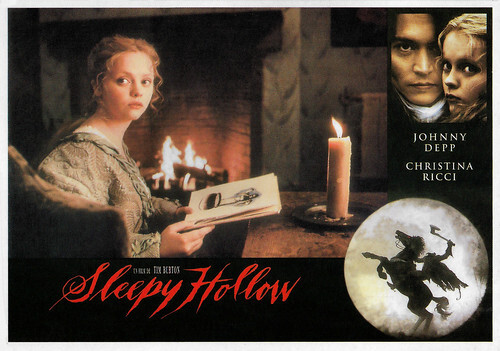
British postcard by Memory Card, no. 605 (Lobby card). Christina Ricci in Sleepy Hollow (Tim Burton, 1999).
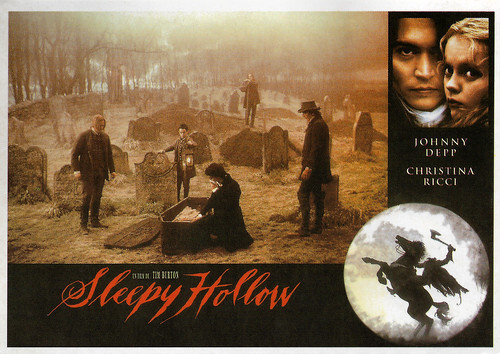
British postcard by Memory Card, no. 606 (Lobby card). Johnny Depp in Sleepy Hollow (Tim Burton, 1999).
A homage to various Hammer Film Productions
Development of Sleepy Hollow began in 1993 at Paramount Pictures. Kevin Yagher, a make-up effects designer who had turned to direct with the horror anthology television series Tales from the Crypt (1989-1996), was originally set to direct Andrew Kevin Walker's script as a low-budget slasher film.
Through his agent, Yagher was introduced to Andrew Kevin Walker. They spent a few months working on a film treatment that transformed Ichabod Crane from a schoolmaster from Connecticut to a banished New York City detective. Disagreements with Paramount resulted in Yagher being demoted to prosthetic makeup designer, and Tim Burton was hired to direct in June 1998.
Burton made Sleepy Hollow a homage to various Hammer Film Productions, including Dr. Jekyll and Sister Hyde, and other films such as Frankenstein, Bride of Frankenstein, various Roger Corman horror films, Jason and the Argonauts, and Scream Blacula Scream.
Johnny Depp was cast in July 1998 for his third collaboration with Burton. He did not wish to portray the character of Ichabod as a typical action star would have and instead took inspiration from Angela Lansbury 's performance in Death on the Nile. Depp modelled Ichabod's detective personality from Basil Rathbone in the 1939 Sherlock Holmes film series. He also studied Roddy McDowall's acting for additional influence.
Sleepy Hollow also reunited Burton with Jeffrey Jones (from Beetlejuice and Ed Wood) as Reverend Steenwyck, Christopher Walken (Max Shreck in Batman Returns) as the Hessian Horseman, Martin Landau (Ed Wood) in a cameo role, and Hammer veteran Michael Gough (Alfred in Burton's Batman films), whom Burton tempted out of retirement. The Hammer influence was further confirmed by the casting of Christopher Lee in a small role as the Burgomaster who sends Crane to Sleepy Hollow.
Filming took place from November 1998 to May 1999. The film had its world premiere at Mann's Chinese Theatre and was released in the United States on 19 November 1999, by Paramount Pictures. It received generally positive reviews from critics, with many praising the performances, direction, screenplay and musical score, as well as its dark humour, visual effects and atmosphere.
Roger Ebert: "This is the best-looking horror film since Coppola's Bram Stoker's Dracula. It is not, however, titled "Washington Irving's Sleepy Hollow," perhaps because the story has been altered out of all recognition from the Irving classic. Perhaps not. No power on earth could persuade me to reread the original and find out. What it depends upon is Burton's gift for bizarre and eccentric special effects, and a superb performance by Johnny Depp , who discards everything we may ever have learned or thought about Ichabod Crane and starts from scratch."
Jason Buchanan at AllMovie adds: "Often cited as a homage to the infamous films of Hammer Studios, upon deeper investigation into the influences of director Tim Burton, it becomes increasingly clear that, while the film does indeed have much in common with the British horror classics, the majority of visual influence is instead derived from the lush, gothic films of Mario Bava. Bearing a striking resemblance to 1960s Black Sunday in particular, Burton's muted color palate, vividly splashed with abundant amounts of blood so unnaturally red it seems to drip from the screen, represents a masterful command of color scheme rarely seen since Bava's color-era heyday." The film grossed approximately $207 million worldwide. Sleepy Hollow won the Academy Award for Best Art Direction.
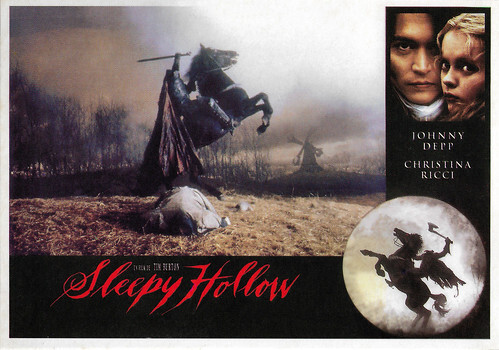
British postcard by Memory Card, no. 607 (Lobby card). Publicity still for Sleepy Hollow (Tim Burton, 1999).
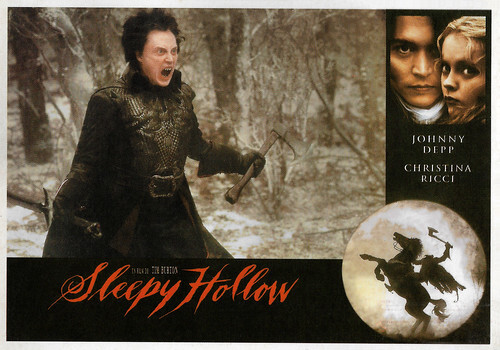
British postcard by Memory Card, no. 610 (Lobby card). Christopher Walken in Sleepy Hollow (Tim Burton, 1999).
Sources: Roger Ebert (RogerEbert.com), Jason Buchanan (AllMovie), Wikipedia (Dutch and English), and IMDb.

British postcard by Memory Card, no. 612 (Lobby card). Johnny Depp in Sleepy Hollow (Tim Burton, 1999).
People are mysteriously beheaded
The story of Sleepy Hollow (1999) begins when scientist Ichabod Crane ( Johnny Depp ) tries to convince the court of justice in 1799 New York of his new, forensic methods of solving crimes. A method that meets with a lot of resistance, at a time when, even in the court of law, methods based on superstition and the supernatural are still highly valued.
To prove himself right, Crane goes to Sleepy Hollow, a settlement of Dutch colonists in the state of New York, where mysterious things seem to happen and people are mysteriously beheaded. After a long journey by carriage, Crane arrives in the village. There he is informed of the existence of the "rider without a head" who haunts the woods and occasionally comes to crush a villager.
Initially, Crane does not believe the story and sets out to find the real killer, until he discovers that the apparition does exist. The headless horseman (Christopher Walken) was once a Hes, a cruel Germanic mercenary in the American War of Independence who entered the war not for money but for pleasure. To look even more fearsome, he had sharpened his teeth to a point.
One day, however, he was chased into the woods of Sleepy Hollow and finally decapitated by his own sword. For some months now, the horseman has been resurrected, beheading people from the village and taking their heads with him. After some time, Crane begins to suspect that the horseman does not kill at random, but that he does so at the behest of someone, a person who owns his head and therefore has power over the horseman.
Eventually, he manages to eliminate this person and give the rider his head back. Finally, with the beautiful Katherine van Tassel (Christina Ricci), whom he has met in the village and with whom villager Abraham van Brunt (Caspar Van Dien) initially has a crush, he returns to New York.

British postcard by Memory Card, no. 605 (Lobby card). Christina Ricci in Sleepy Hollow (Tim Burton, 1999).

British postcard by Memory Card, no. 606 (Lobby card). Johnny Depp in Sleepy Hollow (Tim Burton, 1999).
A homage to various Hammer Film Productions
Development of Sleepy Hollow began in 1993 at Paramount Pictures. Kevin Yagher, a make-up effects designer who had turned to direct with the horror anthology television series Tales from the Crypt (1989-1996), was originally set to direct Andrew Kevin Walker's script as a low-budget slasher film.
Through his agent, Yagher was introduced to Andrew Kevin Walker. They spent a few months working on a film treatment that transformed Ichabod Crane from a schoolmaster from Connecticut to a banished New York City detective. Disagreements with Paramount resulted in Yagher being demoted to prosthetic makeup designer, and Tim Burton was hired to direct in June 1998.
Burton made Sleepy Hollow a homage to various Hammer Film Productions, including Dr. Jekyll and Sister Hyde, and other films such as Frankenstein, Bride of Frankenstein, various Roger Corman horror films, Jason and the Argonauts, and Scream Blacula Scream.
Johnny Depp was cast in July 1998 for his third collaboration with Burton. He did not wish to portray the character of Ichabod as a typical action star would have and instead took inspiration from Angela Lansbury 's performance in Death on the Nile. Depp modelled Ichabod's detective personality from Basil Rathbone in the 1939 Sherlock Holmes film series. He also studied Roddy McDowall's acting for additional influence.
Sleepy Hollow also reunited Burton with Jeffrey Jones (from Beetlejuice and Ed Wood) as Reverend Steenwyck, Christopher Walken (Max Shreck in Batman Returns) as the Hessian Horseman, Martin Landau (Ed Wood) in a cameo role, and Hammer veteran Michael Gough (Alfred in Burton's Batman films), whom Burton tempted out of retirement. The Hammer influence was further confirmed by the casting of Christopher Lee in a small role as the Burgomaster who sends Crane to Sleepy Hollow.
Filming took place from November 1998 to May 1999. The film had its world premiere at Mann's Chinese Theatre and was released in the United States on 19 November 1999, by Paramount Pictures. It received generally positive reviews from critics, with many praising the performances, direction, screenplay and musical score, as well as its dark humour, visual effects and atmosphere.
Roger Ebert: "This is the best-looking horror film since Coppola's Bram Stoker's Dracula. It is not, however, titled "Washington Irving's Sleepy Hollow," perhaps because the story has been altered out of all recognition from the Irving classic. Perhaps not. No power on earth could persuade me to reread the original and find out. What it depends upon is Burton's gift for bizarre and eccentric special effects, and a superb performance by Johnny Depp , who discards everything we may ever have learned or thought about Ichabod Crane and starts from scratch."
Jason Buchanan at AllMovie adds: "Often cited as a homage to the infamous films of Hammer Studios, upon deeper investigation into the influences of director Tim Burton, it becomes increasingly clear that, while the film does indeed have much in common with the British horror classics, the majority of visual influence is instead derived from the lush, gothic films of Mario Bava. Bearing a striking resemblance to 1960s Black Sunday in particular, Burton's muted color palate, vividly splashed with abundant amounts of blood so unnaturally red it seems to drip from the screen, represents a masterful command of color scheme rarely seen since Bava's color-era heyday." The film grossed approximately $207 million worldwide. Sleepy Hollow won the Academy Award for Best Art Direction.

British postcard by Memory Card, no. 607 (Lobby card). Publicity still for Sleepy Hollow (Tim Burton, 1999).

British postcard by Memory Card, no. 610 (Lobby card). Christopher Walken in Sleepy Hollow (Tim Burton, 1999).
Sources: Roger Ebert (RogerEbert.com), Jason Buchanan (AllMovie), Wikipedia (Dutch and English), and IMDb.
Published on July 06, 2022 22:00
July 5, 2022
Basil Rathbone
English actor Basil Rathbone (1892-1967) appeared both in British and Hollywood films. He rose to prominence in the United Kingdom as a Shakespearean stage actor and went on to appear in more than 70 films. He played suave villains in such classic Swashbucklers as Captain Blood (1935) and The Adventures of Robin Hood (1938). He also became well-known for his roles in Horror films and for playing Sherlock Holmes in a total of 14 detective films between 1939 and 1946. Rathbone was a Tony Award winner. and was nominated for an Oscar twice.
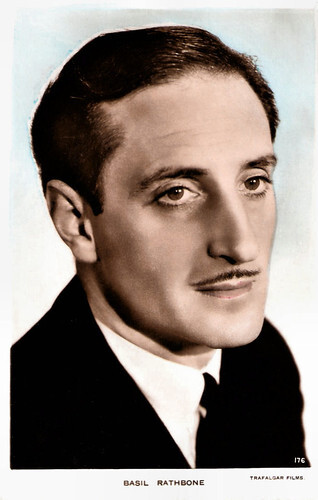
British Real Photograph postcard, no. 176. Photo: Trafalgar Films.
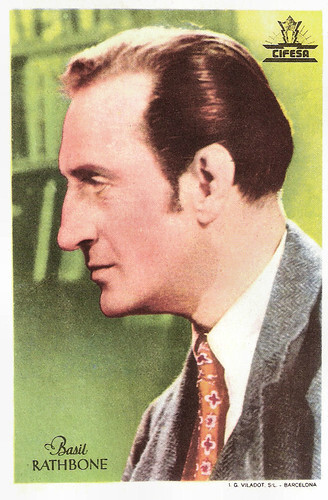
Spanish collectors card by I.G. Viladot, Barcelona. Image: Cifesa.
Hoping he would forget about acting
Philip St. John Basil Rathbone was born in Johannesburg, South Africa, in 1892 to British parents. His mother Anna Babera George was a violinist, and his father Edgar Philip Rathbone a mining engineer. Three years later his family was forced to flee the country because his father was accused by the Boers of being a British spy at a time when Dutch-British conflicts were leading to the Boer War.
The Rathbones escaped to England, where Basil and his two younger siblings, Beatrice and John, were raised. From 1906 to 1910 Rathbone attended Repton School, where he was more interested in sports - especially fencing, at which he excelled - than studies, but where he also discovered his interest in the theatre.
After graduation, he planned to pursue acting as a profession, but his father disapproved and suggested that his son try working in the business for a year, hoping he would forget about acting. Rathbone accepted his father's suggestion and worked as a clerk for an insurance company - for exactly one year.
Then he contacted his cousin Frank Benson, an actor managing a Shakespearean troupe in Stratford-on-Avon. Rathbone was hired as an actor on the condition that he work his way through the ranks, which he did quite rapidly. Starting in bit parts in 1911, he was playing juvenile leads within two years.
In 1915 his career was interrupted by the First World War. During his military service, as a second lieutenant in the Liverpool Scottish 2nd Battalion, he worked in intelligence and received the Military Cross for bravery. In 1919, released from military service, he returned to Stratford-on-Avon and continued with Shakespeare but after a year moved onto the London stage. The year after that he made his first appearance on Broadway and his cinema debut in the silent film Innocent (Maurice Elvey, 1921).
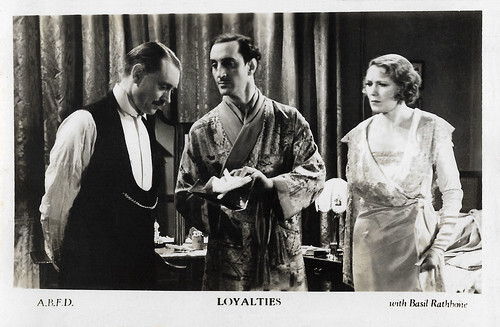
British postcard in the Film Shots Series by Film Weekly. Photo: A.B.F.D. Miles Mander, Basil Rathbone and Cecily Byrne in Loyalties (Basil Dean, 1933).
He abandoned his first love for a film career
For the remainder of the decade, Basil Rathbone alternated between the London and New York stages and occasional appearances in films. In 1929 he co-wrote and starred as the title character in a short-running Broadway play called 'Judas'. Soon afterwards he abandoned his first love, the theatre, for a film career.
During the 1920s, his roles had evolved from the romantic lead to the suave lady-killer to the sinister villain (usually wielding a sword), and Hollywood put him to good use during the 1930s in numerous costume romps, including Captain Blood (Michael Curtiz, 1935) starring Errol Flynn , The Personal History, Adventures, Experience, & Observation of David Copperfield the Younger (George Cukor, 1935), and A Tale of Two Cities (Jack Conway, 1935) with Ronald Colman .
He also appeared in Anna Karenina (Clarence Brown, 1935) starring Greta Garbo , The Last Days of Pompeii (Ernest B. Schoedsack, Merian C. Cooper, 1935), The Adventures of Robin Hood (Michael Curtiz, 1938), and The Mark of Zorro (Rouben Mamoulian, 1940) starring Tyrone Power .
Rathbone earned two Oscar nominations for Best Supporting Actor as Tybalt in Romeo and Juliet (George Cukor, 1936) and as King Louis XI in If I Were King (Frank Lloyd, 1938).
He also appeared in several early horror films: Tower of London (Rowland V. Lee, 1939), as Richard III, and Son of Frankenstein (Rowland V. Lee, 1939), portraying the dedicated surgeon Baron Wolf von Frankenstein, son of the monster's creator.
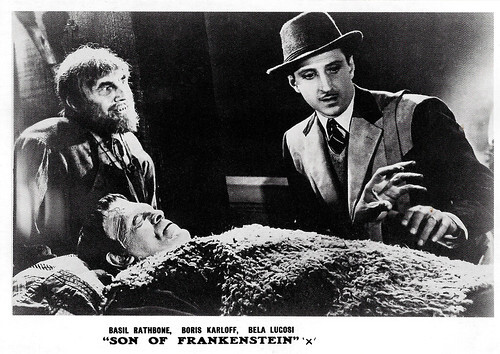
English postcard by Moviedrome, no. M7. Boris Karloff , Basil Rathbone and Bela Lugosi (left) in Son of Frankenstein (Rowland V. Lee, 1939).
His best-known and most popular character
However, it was in 1939 that Basil Rathbone played his best-known and most popular character, Sherlock Holmes, with Nigel Bruce as Dr. Watson, first in The Hound of the Baskervilles (Sidney Lanfield, 1939) and then in The Adventures of Sherlock Holmes (Alfred L. Werker, 1939).
These were followed by 12 more films and numerous radio broadcasts over the next seven years. Feeling that his identification with the character was killing his film career, Rathbone went back to New York and the stage in 1946.
The next year he won a Tony Award for his portrayal of Dr. Sloper in the Broadway play 'The Heiress', but afterwards, he found little rewarding stage work. Nevertheless, during the last two decades of his life, Rathbone was a very busy actor, appearing on numerous television shows, primarily drama, variety and game shows.
He played in occasional films, such as Casanova's Big Night (Norman Z. McLeod, 1954), The Court Jester (Melvin Frank, Norman Panama,1955) with Danny Kaye , Tales of Terror (Roger Corman, 1962) and The Comedy of Terrors (Jacques Tourneur, 1963). He also appeared in his own one-man show, 'An Evening with Basil Rathbone', with which he toured the U.S.
In 1967, Basil Rathbone died of a heart attack in New York City at the age of 75. He was married twice. His first wife was Ethel Marion Foreman (1914-1926). After their divorce, he married actress, playwright and screenwriter Ouida Bergère in 1926. They adopted a child, Cynthia Rathbone. He also had a son with Ethel Marion Foreman: John Rodion. Rathbone remained married to Ouida for over 41 years until his death, and the marriage was considered one of the most exemplary in Hollywood. The couple hosted glamorous parties at their estate in California, which had also once been occupied by Jack Dempsey.
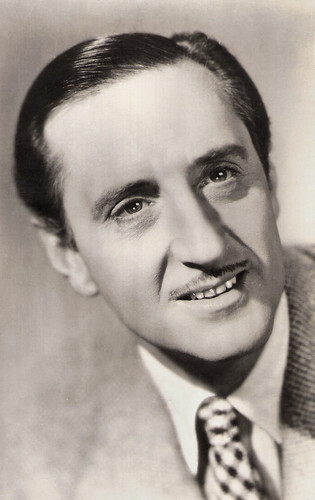
Spanish postcard, no. 773.
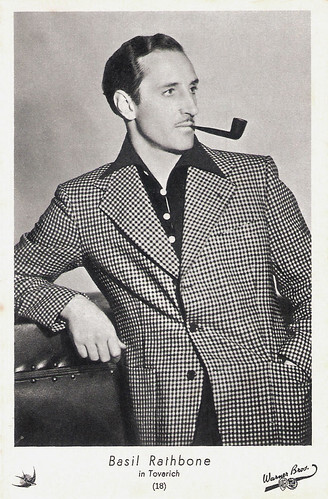
Italian postcard in the series '100 Artisti del Cinema' by Edizione ELAH 'La casa delle caramelle', no. 18. Photo: Warner Bros. Basil Rathbone in Tovarich (Anatole Litvak, 1937).
Sources: (IMDb), Wikipedia (Dutch and German) and .

British Real Photograph postcard, no. 176. Photo: Trafalgar Films.

Spanish collectors card by I.G. Viladot, Barcelona. Image: Cifesa.
Hoping he would forget about acting
Philip St. John Basil Rathbone was born in Johannesburg, South Africa, in 1892 to British parents. His mother Anna Babera George was a violinist, and his father Edgar Philip Rathbone a mining engineer. Three years later his family was forced to flee the country because his father was accused by the Boers of being a British spy at a time when Dutch-British conflicts were leading to the Boer War.
The Rathbones escaped to England, where Basil and his two younger siblings, Beatrice and John, were raised. From 1906 to 1910 Rathbone attended Repton School, where he was more interested in sports - especially fencing, at which he excelled - than studies, but where he also discovered his interest in the theatre.
After graduation, he planned to pursue acting as a profession, but his father disapproved and suggested that his son try working in the business for a year, hoping he would forget about acting. Rathbone accepted his father's suggestion and worked as a clerk for an insurance company - for exactly one year.
Then he contacted his cousin Frank Benson, an actor managing a Shakespearean troupe in Stratford-on-Avon. Rathbone was hired as an actor on the condition that he work his way through the ranks, which he did quite rapidly. Starting in bit parts in 1911, he was playing juvenile leads within two years.
In 1915 his career was interrupted by the First World War. During his military service, as a second lieutenant in the Liverpool Scottish 2nd Battalion, he worked in intelligence and received the Military Cross for bravery. In 1919, released from military service, he returned to Stratford-on-Avon and continued with Shakespeare but after a year moved onto the London stage. The year after that he made his first appearance on Broadway and his cinema debut in the silent film Innocent (Maurice Elvey, 1921).

British postcard in the Film Shots Series by Film Weekly. Photo: A.B.F.D. Miles Mander, Basil Rathbone and Cecily Byrne in Loyalties (Basil Dean, 1933).
He abandoned his first love for a film career
For the remainder of the decade, Basil Rathbone alternated between the London and New York stages and occasional appearances in films. In 1929 he co-wrote and starred as the title character in a short-running Broadway play called 'Judas'. Soon afterwards he abandoned his first love, the theatre, for a film career.
During the 1920s, his roles had evolved from the romantic lead to the suave lady-killer to the sinister villain (usually wielding a sword), and Hollywood put him to good use during the 1930s in numerous costume romps, including Captain Blood (Michael Curtiz, 1935) starring Errol Flynn , The Personal History, Adventures, Experience, & Observation of David Copperfield the Younger (George Cukor, 1935), and A Tale of Two Cities (Jack Conway, 1935) with Ronald Colman .
He also appeared in Anna Karenina (Clarence Brown, 1935) starring Greta Garbo , The Last Days of Pompeii (Ernest B. Schoedsack, Merian C. Cooper, 1935), The Adventures of Robin Hood (Michael Curtiz, 1938), and The Mark of Zorro (Rouben Mamoulian, 1940) starring Tyrone Power .
Rathbone earned two Oscar nominations for Best Supporting Actor as Tybalt in Romeo and Juliet (George Cukor, 1936) and as King Louis XI in If I Were King (Frank Lloyd, 1938).
He also appeared in several early horror films: Tower of London (Rowland V. Lee, 1939), as Richard III, and Son of Frankenstein (Rowland V. Lee, 1939), portraying the dedicated surgeon Baron Wolf von Frankenstein, son of the monster's creator.

English postcard by Moviedrome, no. M7. Boris Karloff , Basil Rathbone and Bela Lugosi (left) in Son of Frankenstein (Rowland V. Lee, 1939).
His best-known and most popular character
However, it was in 1939 that Basil Rathbone played his best-known and most popular character, Sherlock Holmes, with Nigel Bruce as Dr. Watson, first in The Hound of the Baskervilles (Sidney Lanfield, 1939) and then in The Adventures of Sherlock Holmes (Alfred L. Werker, 1939).
These were followed by 12 more films and numerous radio broadcasts over the next seven years. Feeling that his identification with the character was killing his film career, Rathbone went back to New York and the stage in 1946.
The next year he won a Tony Award for his portrayal of Dr. Sloper in the Broadway play 'The Heiress', but afterwards, he found little rewarding stage work. Nevertheless, during the last two decades of his life, Rathbone was a very busy actor, appearing on numerous television shows, primarily drama, variety and game shows.
He played in occasional films, such as Casanova's Big Night (Norman Z. McLeod, 1954), The Court Jester (Melvin Frank, Norman Panama,1955) with Danny Kaye , Tales of Terror (Roger Corman, 1962) and The Comedy of Terrors (Jacques Tourneur, 1963). He also appeared in his own one-man show, 'An Evening with Basil Rathbone', with which he toured the U.S.
In 1967, Basil Rathbone died of a heart attack in New York City at the age of 75. He was married twice. His first wife was Ethel Marion Foreman (1914-1926). After their divorce, he married actress, playwright and screenwriter Ouida Bergère in 1926. They adopted a child, Cynthia Rathbone. He also had a son with Ethel Marion Foreman: John Rodion. Rathbone remained married to Ouida for over 41 years until his death, and the marriage was considered one of the most exemplary in Hollywood. The couple hosted glamorous parties at their estate in California, which had also once been occupied by Jack Dempsey.

Spanish postcard, no. 773.

Italian postcard in the series '100 Artisti del Cinema' by Edizione ELAH 'La casa delle caramelle', no. 18. Photo: Warner Bros. Basil Rathbone in Tovarich (Anatole Litvak, 1937).
Sources: (IMDb), Wikipedia (Dutch and German) and .
Published on July 05, 2022 22:00
July 4, 2022
Regimantas Adomaitis (1937-2022)
Lithuanian film and stage actor Regimantas Adomaitis (1937) passed away on 20 June 2022. He was particularly active in Soviet and East German cinema, for example in Korol Lir/King Lear (1970) and Jeto sladkoje slovo - svoboda!/That Sweet Word: Liberty! (1972).
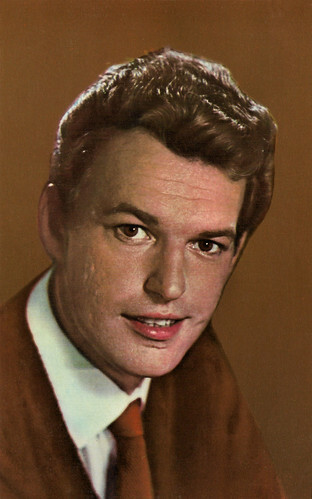
Soviet-Russian postcard by Izdanije Byuro Propogandy Sovietskogo Kinoiskusstva, no. A 093467, 1968. This postcard was printed in an edition of 200,000 cards. Retail price: 8 Kop.
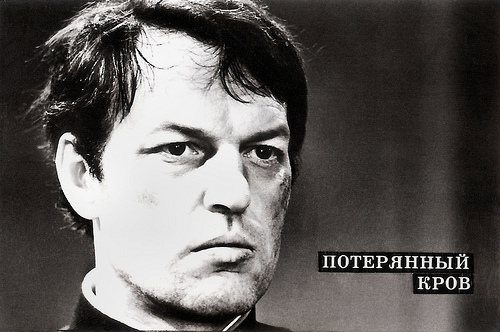
Soviet collectors card. Photo: publicity still for Poterjannyj krov. We could not identify the film.
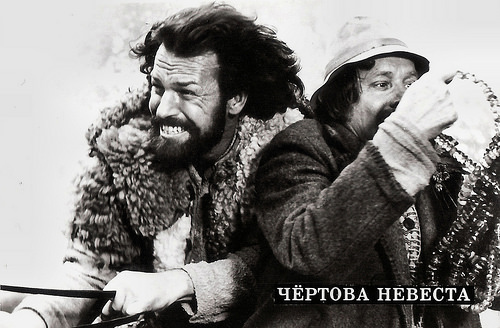
Soviet collectors card. Photo: publicity still for Velnio nuotaka/Cërtova nevesta/Devil's Bride (Arunas Zebriunas, 1973).
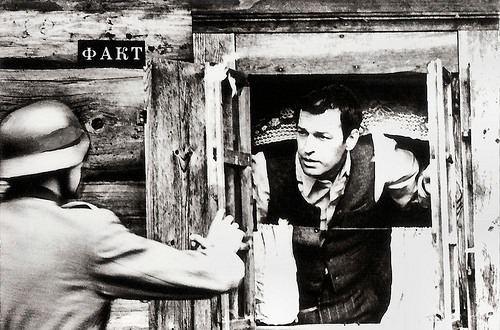
Soviet collectors card. Photo: publicity still for Faktas/Facts (Almantas Grikevicius, 1981).
A Lithuanian Jesus Christ Superstar rock opera
Regimantas Vaiksutovitch Adomaitis was born in Šiauliai, Lithuania in 1937. He graduated from the Faculty of Physics and Mathematics at Vilnius University. Later he studied acting at the acting department of the Vilnius Conservatory.
He made a debut in the theatre and had engagements in Vilnius, Kaunas and Kapsukas. His film debut was Vienos dienos kronika/The Chronicle of one Day (Vytautas Zalakevicius, 1963) with Donatas Banionis .
In 1966 he had his breakthrough with Niekas nenorėjo mirti/Nobody Wanted to Die (Vytautas Žalakevičius, 1966). This action drama is set in a small Lithuanian farming community after the Second World War. The village is divided as the communists battle those in favour of national independence. When the leader of the community is killed, the man's four sons, including Adomaitis, set out to avenge his death. Adomaitis, director Vytautas Žalakevičius and cinematographer Jonas Gricius were awarded the USSR State Prize for the film in 1967.
That year, he also acted in the a-typical Soviet war film Vostochny koridor/Eastern Corridor (Valentin Vinogradov, 1966) with Lyudmila Abramova. In the historical drama Sergey Lazo (Aleksandr Gordon, 1968), he played the title role of the Communist leader Lazo.
Adomaitis appeared as Edmund in the Soviet Shakespeare adaptation Korol Lir/King Lear (Grigori Kozintsev, Iosif Shapiro, 1971), starring Juri Jarvet. The Russian composer Dmitri Shostakovich composed the score. Jugu Abraham at IMDb : “Kozintsev is one of least sung masters of Russian cinema. His cinema is very close to that of Tarkovsky and Sergei Paradjanov. Kozintsev's Lear is not a Lear that mourns his past and his daughters - his Lear is close to the soil, the plants, and all elements of nature. That's what makes Kozintsev's Shakespearean works outstanding.”
In 1973, Adomaitis appeared in the Soviet drama Eto sladkoe slovo - svoboda!/That Sweet Word: Liberty! (Vytautas Žalakevičius, 1973). The film was shot in Chile shortly before the 1973 Chilean coup d'état. The basis for the plot is a real story: the escape from San Carlos prison in Venezuela of three political prisoners. The film was entered into the 8th Moscow International Film Festival where it won the Golden Prize.
Velnio nuotaka/Cërtova nevesta/Devil's Bride (Arūnas Žebriūnas, 1974) is the first Lithuanian musical about the victory of love over the trickery of the Devil based on the book Baltaragio malūnas (Whitehorn Mill) by Kazys Boruta. Due to its popularity, it is sometimes called a Lithuanian Jesus Christ Superstar rock opera.
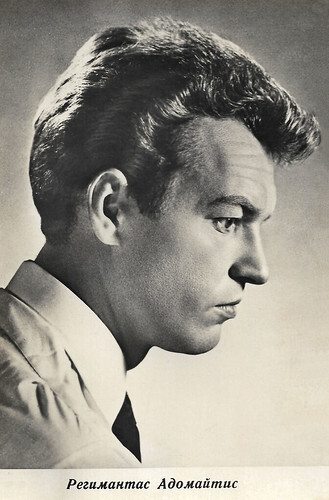
Soviet-Russian postcard by Izdanije Byuro Propogandy Sovietskogo Kinoiskusstva, no. M-31293 9/IV-68. This postcard was printed in an edition of 150,000 cards. The retail price was 8 kop.
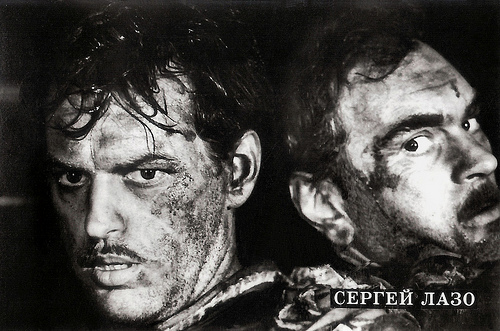
Soviet collectors card. Photo: publicity still for Sergey Lazo (Aleksandr Gordon, 1968).
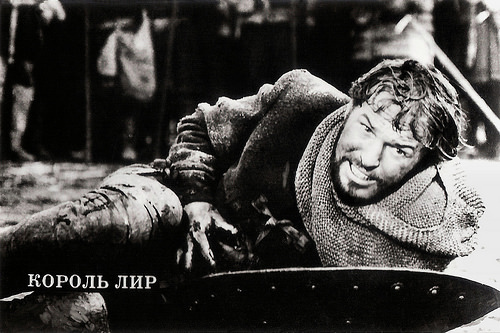
Soviet collectors card. Photo: publicity still for Korol Lir/King Lear (Grigori Kozintsev, Iosif Shapiro, 1971).
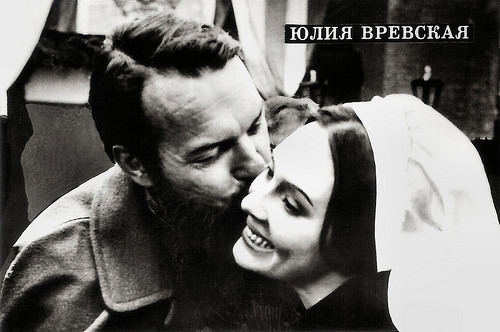
Soviet collectors card. Photo: publicity still for Yuliya Vrevskaya (Nikola Korabov, 1978) with Lyudmila Saveleva .
Power House
In East-Germany, Regimantas Adomaitis starred in Wolz - Leben und Verklärung eines deutschen Anarchisten/Wolz - Life and Illusion of a German Anarchist (Günter Reisch, 1974) with Heidemarie Wenzel. Tom Dooley at IMDb : “Part comedy at one point, part political statement and a definite swipe at National Socialism, it is very ambitious and it pulls it all off. It has a great musical score too and the music adds to the moods tenfold. The acting is superb and Regimantas Adomaitis as Wolz is a powerhouse.”
For the DEFA, he also starred in Mann gegen Mann/Man Against Man (Kurt Maetzig, 1976). In the historical drama Yuliya Vrevskaya/Between the Tsar’s Court and the Battlefield (Nikola Korabov, 1978), Adomaitas played opposite Lyudmila Saveleva and Stefan Danailov.
Other films were the Maxim Gorky adaptation Vrag/Enemies (Rodion Nahapetov, 1978) with Innokentiy Smoktunovskiy, the Soviet-Italian drama La vita è bella/Life Is Beautiful (Grigoriy Chukhray, 1979) with Giancarlo Giannini and Ornella Muti , and Poloska neskoshennych dikikh tsvetov/A strip of unclosed wildflowers (Yuri Ilyenko, 1980).
He returned to East-Germany for the drama Die Verlobte/The Fiancee (Günter Reisch, Günther Rücker, 1980) with Jutta Wachowiak as a woman sentenced in 1934 to ten years in prison for antifascist activities. The love between her and her fiancée enables her to survive it.
He co-starred again with Donatas Banionis in the Soviet Lithuanian-language war film Gruppa krovi nol/Faktas/Facts (Almantas Grikevicius, 1981). At the 1981 Cannes Film Festival, actress Yelena Solovey won the award for Best Supporting Actress for her role in the film.
Other films include Iz zhizni otdykhayushchikh/Life on Holidays (Nikolay Gubenko, 1981), Skrydis per Atlanta/The Flight Across the Atlantic Ocean (Raimondas Vabalas, 1984), Es ist nicht leicht ein Gott zu sein/It’s Hard to Be a God (Peter Fleischmann, 1989), the war drama Angely smerti/Angels of Death (Yuriy Ozerov, 1993), with Fedor Bondarchuk and Powers Boothe, and the French-Russian drama Tu es.../You are… (Vladimir Makeranets, 1995).
On TV, he appeared in the Soviet musical miniseries Trest, kotoryy lopnul/The Trust That Went Bust (Aleksandr Pavlovsky 1983) based on short stories by O. Henry. In 1985, Regimantas Adomaitis was a member of the jury at the 35th Berlin International Film Festival. Adomaitis has received many awards of recognition.
In 1988 he and 34 other prominent people, created the Sąjūdis Reform Movement, which eventually led to the declaration of independence of Lithuania on 11 March 1990. From then on, Adomaitis lived in Vilnius, the capital of Lithuania, where he worked as an actor at the Lithuanian National Drama Theatre and regularly appeared in TV series. Among his later films were the Norwegian drama Iskyss/The Ice Kiss (Knut Erik Jensen, 2008) with Ellen Dorrit Petersen, and the drama Anton (Zaza Urushadze, 2019).
Regimantas Adomaitis died in 2022 in Vilnius, Lithuania. He had been married to singer Eugenia Baerite, who died in 2011. They had three children, including actor Gediminas Adomaitis.
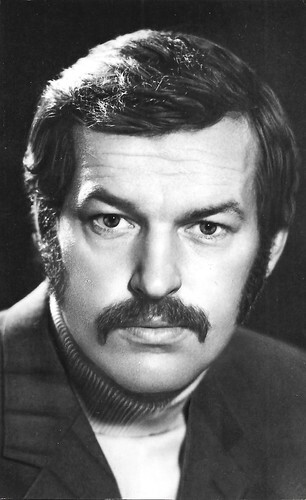
Former Sovietunion postcard by Ykrreklamfilm YRF, Kiev, 3-1-1978.
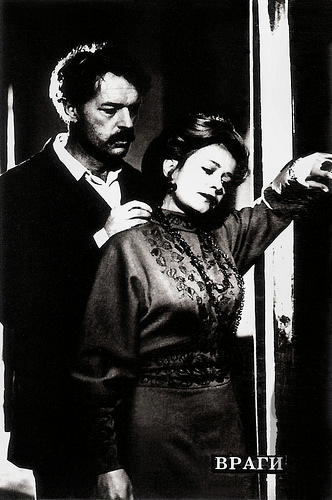
Soviet collectors card. Photo: publicity still for Vragi/Enemies (Rodion Nahapetov, 1979) with Elena Solovey.
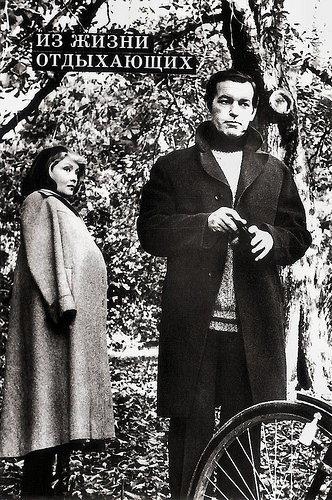
Soviet collectors card. Photo: publicity still for Iz zhizni otdykhayushchikh/Life on Holidays (Nikolay Gubenko, 1981) with Zhanna Bolotova.
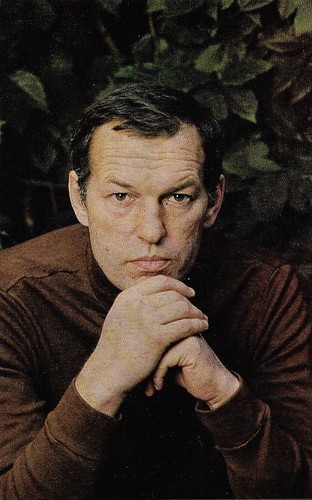
Soviet-Russian postcard. Photo B. Plotnikova.
Sources: Jugu Abraham (IMDb), Tom Dooley (IMDb), (IMDb), Mubi, AllMovie, Wikipedia and .

Soviet-Russian postcard by Izdanije Byuro Propogandy Sovietskogo Kinoiskusstva, no. A 093467, 1968. This postcard was printed in an edition of 200,000 cards. Retail price: 8 Kop.

Soviet collectors card. Photo: publicity still for Poterjannyj krov. We could not identify the film.

Soviet collectors card. Photo: publicity still for Velnio nuotaka/Cërtova nevesta/Devil's Bride (Arunas Zebriunas, 1973).

Soviet collectors card. Photo: publicity still for Faktas/Facts (Almantas Grikevicius, 1981).
A Lithuanian Jesus Christ Superstar rock opera
Regimantas Vaiksutovitch Adomaitis was born in Šiauliai, Lithuania in 1937. He graduated from the Faculty of Physics and Mathematics at Vilnius University. Later he studied acting at the acting department of the Vilnius Conservatory.
He made a debut in the theatre and had engagements in Vilnius, Kaunas and Kapsukas. His film debut was Vienos dienos kronika/The Chronicle of one Day (Vytautas Zalakevicius, 1963) with Donatas Banionis .
In 1966 he had his breakthrough with Niekas nenorėjo mirti/Nobody Wanted to Die (Vytautas Žalakevičius, 1966). This action drama is set in a small Lithuanian farming community after the Second World War. The village is divided as the communists battle those in favour of national independence. When the leader of the community is killed, the man's four sons, including Adomaitis, set out to avenge his death. Adomaitis, director Vytautas Žalakevičius and cinematographer Jonas Gricius were awarded the USSR State Prize for the film in 1967.
That year, he also acted in the a-typical Soviet war film Vostochny koridor/Eastern Corridor (Valentin Vinogradov, 1966) with Lyudmila Abramova. In the historical drama Sergey Lazo (Aleksandr Gordon, 1968), he played the title role of the Communist leader Lazo.
Adomaitis appeared as Edmund in the Soviet Shakespeare adaptation Korol Lir/King Lear (Grigori Kozintsev, Iosif Shapiro, 1971), starring Juri Jarvet. The Russian composer Dmitri Shostakovich composed the score. Jugu Abraham at IMDb : “Kozintsev is one of least sung masters of Russian cinema. His cinema is very close to that of Tarkovsky and Sergei Paradjanov. Kozintsev's Lear is not a Lear that mourns his past and his daughters - his Lear is close to the soil, the plants, and all elements of nature. That's what makes Kozintsev's Shakespearean works outstanding.”
In 1973, Adomaitis appeared in the Soviet drama Eto sladkoe slovo - svoboda!/That Sweet Word: Liberty! (Vytautas Žalakevičius, 1973). The film was shot in Chile shortly before the 1973 Chilean coup d'état. The basis for the plot is a real story: the escape from San Carlos prison in Venezuela of three political prisoners. The film was entered into the 8th Moscow International Film Festival where it won the Golden Prize.
Velnio nuotaka/Cërtova nevesta/Devil's Bride (Arūnas Žebriūnas, 1974) is the first Lithuanian musical about the victory of love over the trickery of the Devil based on the book Baltaragio malūnas (Whitehorn Mill) by Kazys Boruta. Due to its popularity, it is sometimes called a Lithuanian Jesus Christ Superstar rock opera.

Soviet-Russian postcard by Izdanije Byuro Propogandy Sovietskogo Kinoiskusstva, no. M-31293 9/IV-68. This postcard was printed in an edition of 150,000 cards. The retail price was 8 kop.

Soviet collectors card. Photo: publicity still for Sergey Lazo (Aleksandr Gordon, 1968).

Soviet collectors card. Photo: publicity still for Korol Lir/King Lear (Grigori Kozintsev, Iosif Shapiro, 1971).

Soviet collectors card. Photo: publicity still for Yuliya Vrevskaya (Nikola Korabov, 1978) with Lyudmila Saveleva .
Power House
In East-Germany, Regimantas Adomaitis starred in Wolz - Leben und Verklärung eines deutschen Anarchisten/Wolz - Life and Illusion of a German Anarchist (Günter Reisch, 1974) with Heidemarie Wenzel. Tom Dooley at IMDb : “Part comedy at one point, part political statement and a definite swipe at National Socialism, it is very ambitious and it pulls it all off. It has a great musical score too and the music adds to the moods tenfold. The acting is superb and Regimantas Adomaitis as Wolz is a powerhouse.”
For the DEFA, he also starred in Mann gegen Mann/Man Against Man (Kurt Maetzig, 1976). In the historical drama Yuliya Vrevskaya/Between the Tsar’s Court and the Battlefield (Nikola Korabov, 1978), Adomaitas played opposite Lyudmila Saveleva and Stefan Danailov.
Other films were the Maxim Gorky adaptation Vrag/Enemies (Rodion Nahapetov, 1978) with Innokentiy Smoktunovskiy, the Soviet-Italian drama La vita è bella/Life Is Beautiful (Grigoriy Chukhray, 1979) with Giancarlo Giannini and Ornella Muti , and Poloska neskoshennych dikikh tsvetov/A strip of unclosed wildflowers (Yuri Ilyenko, 1980).
He returned to East-Germany for the drama Die Verlobte/The Fiancee (Günter Reisch, Günther Rücker, 1980) with Jutta Wachowiak as a woman sentenced in 1934 to ten years in prison for antifascist activities. The love between her and her fiancée enables her to survive it.
He co-starred again with Donatas Banionis in the Soviet Lithuanian-language war film Gruppa krovi nol/Faktas/Facts (Almantas Grikevicius, 1981). At the 1981 Cannes Film Festival, actress Yelena Solovey won the award for Best Supporting Actress for her role in the film.
Other films include Iz zhizni otdykhayushchikh/Life on Holidays (Nikolay Gubenko, 1981), Skrydis per Atlanta/The Flight Across the Atlantic Ocean (Raimondas Vabalas, 1984), Es ist nicht leicht ein Gott zu sein/It’s Hard to Be a God (Peter Fleischmann, 1989), the war drama Angely smerti/Angels of Death (Yuriy Ozerov, 1993), with Fedor Bondarchuk and Powers Boothe, and the French-Russian drama Tu es.../You are… (Vladimir Makeranets, 1995).
On TV, he appeared in the Soviet musical miniseries Trest, kotoryy lopnul/The Trust That Went Bust (Aleksandr Pavlovsky 1983) based on short stories by O. Henry. In 1985, Regimantas Adomaitis was a member of the jury at the 35th Berlin International Film Festival. Adomaitis has received many awards of recognition.
In 1988 he and 34 other prominent people, created the Sąjūdis Reform Movement, which eventually led to the declaration of independence of Lithuania on 11 March 1990. From then on, Adomaitis lived in Vilnius, the capital of Lithuania, where he worked as an actor at the Lithuanian National Drama Theatre and regularly appeared in TV series. Among his later films were the Norwegian drama Iskyss/The Ice Kiss (Knut Erik Jensen, 2008) with Ellen Dorrit Petersen, and the drama Anton (Zaza Urushadze, 2019).
Regimantas Adomaitis died in 2022 in Vilnius, Lithuania. He had been married to singer Eugenia Baerite, who died in 2011. They had three children, including actor Gediminas Adomaitis.

Former Sovietunion postcard by Ykrreklamfilm YRF, Kiev, 3-1-1978.

Soviet collectors card. Photo: publicity still for Vragi/Enemies (Rodion Nahapetov, 1979) with Elena Solovey.

Soviet collectors card. Photo: publicity still for Iz zhizni otdykhayushchikh/Life on Holidays (Nikolay Gubenko, 1981) with Zhanna Bolotova.

Soviet-Russian postcard. Photo B. Plotnikova.
Sources: Jugu Abraham (IMDb), Tom Dooley (IMDb), (IMDb), Mubi, AllMovie, Wikipedia and .
Published on July 04, 2022 22:00
July 3, 2022
Marieluise Claudius
Marie Luise Claudius (1912-1941) was a beautiful German stage and film actress who passed away when she was only 29.
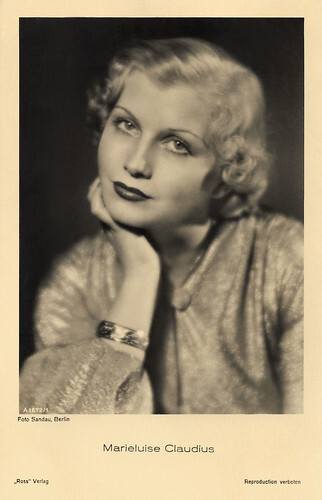
German postcard by Ross Verlag, no. A 1572/1, 1937-1938. Photo: Sandau, Berlin.
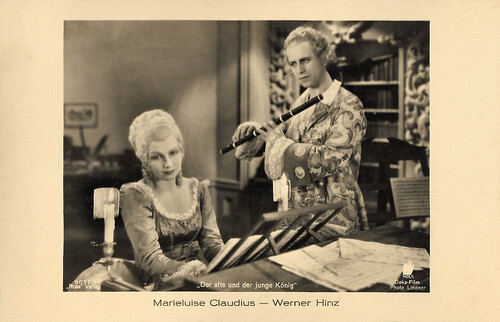
German postcard by Ross Verlag, no. 9052/1, 1935-1936. Photo: Lindner / Deka-Film / NDLS. Marieluise Claudius and Werner Hinz in Der alte und der junge König/The Making of a King (Hans Steinhoff, 1935).
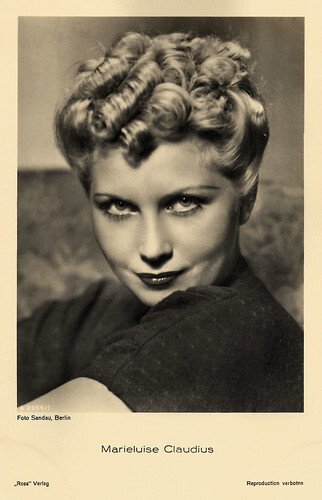
German postcard by Ross Verlag, no. A 2054/1, 1939-1940. Photo: Sandau, Berlin.
Ripening youth
Marie Luise Claudius born in 1912 in Meiningen, Saxe-Meiningen (now Thuringia), Germany. She was the daughter of the court actor and writer Erich Claudius and the actress Lisbeth Reschke.
During her childhood, she appeared several times on the stage of the Meininger Theater. Her first engagement was in 1932 in Düsseldorf.
She made her film debut as Christa von Borck, a high schooler, in Reifende Jugend/Ripening youth (Carl Froelich, 1933) with Heinrich George and Hertha Thiele .
It was well-received by the Nazi press on its release, and drew inspiration from the earlier Mädchen in Uniform/Girls in Uniform (Leontine Sagan, Carl Froelich, 1931), also starring Thiele, which was admired by film journalists of the Third Reich.
Her next films included the Operetta film Die Stimme der Liebe/The Voice of Love (Victor Janson, 1934), and the Henrik Ibsen adaptation Peer Gynt (Fritz Wendhausen, 1934) starring Hans Albers . The latter was one of the most expensive productions made by Bavaria Film and involved location shooting in Norway.

German collectors card in the series 'Vom Werden deutscher Filmkunst - Der Tonfilm', album no. 11, picture no. 175. Photo: Bavaria-Tofa / Ross Verlag. Marieluise Claudius and Hans Albers in Peer Gynt (Fritz Wendhausen, 1934).
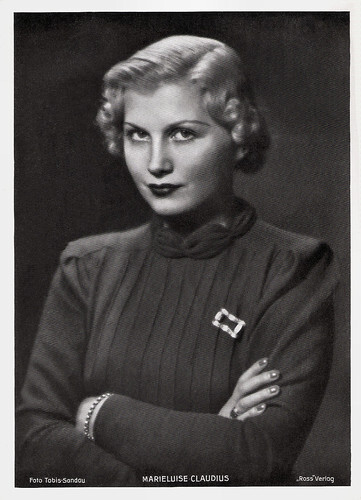
Big German card by Ross Verlag. Photo: Tobis / Sandau.
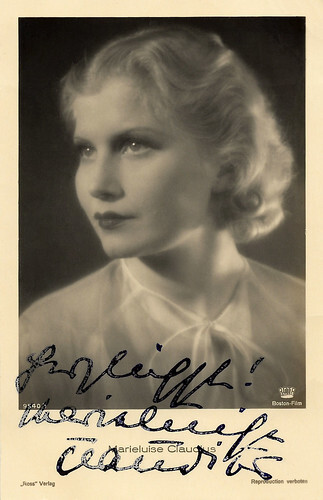
German postcard by Ross Verlag, no. 9540/1, 1935-1936. Photo: Rota / Boston-Film. Marieluise Claudius in Die Entführung/Abduction (Géza von Bolváry, 1936).
The man who was Sherlock Holmes
Marie Luise Claudius played supporting parts in such films as the drama Der rote Reiter/The Red Rider (Rolf Randolf, 1935) starring Iván Petrovich and Camilla Horn , and the historical drama Der alte und der junge König/The Old and the Young King (Hans Steinhoff, 1935) starring Emil Jannings and Werner Hinz.
Another historical drama was the German-Polish biographical film August der Starke/Augustus the Strong (Paul Wegener, 1936) starring Michael Bohnen and Lil Dagover . The film depicts the life of Augustus the Strong, the Eighteenth Century ruler of Saxony and Poland.
She played the female lead in the German mystery comedy Der Mann, der Sherlock Holmes war/The Man Who Was Sherlock Holmes (Karl Hartl, 1937) starring Hans Albers and Heinz Rühmann .
Her final film was the drama Ein Robinson/A German Robinson Crusoe (Arnold Fanck, 1940), a modern-day Robinson Crusoe story about a man (Herbert A.E. Böhme) so angry about the post-World War I conditions in Weimar Germany that he voluntarily goes to live on a desert island. The film was shot partly on location in South America.
At the age of 29 years, Marie Luise Claudius died of heart failure in 1941 in Berlin and was buried in the New Cemetery Wannsee in Berlin. Her grave has since been lost.
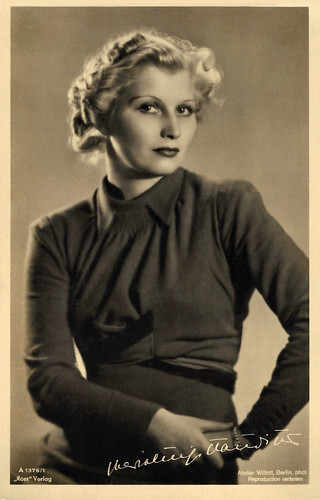
German postcard by Ross Verlag, no. A 1376/1, 1937-1938. Photo: Atelier Willott, Berlin.
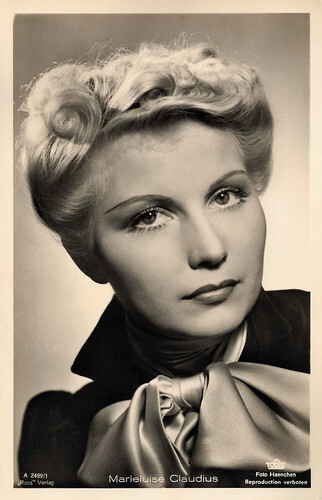
German postcard by Ross Verlag, no. A 2499/1, 1939-1940. Photo: Haenchen / Tobis.
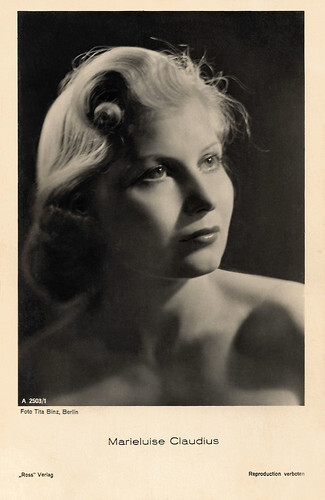
German postcard by Ross Verlag, no. A 2503/1, 1939-1940. Photo: Tita Binz, Berlin.
Sources: Wikipedia (English and German), and .

German postcard by Ross Verlag, no. A 1572/1, 1937-1938. Photo: Sandau, Berlin.

German postcard by Ross Verlag, no. 9052/1, 1935-1936. Photo: Lindner / Deka-Film / NDLS. Marieluise Claudius and Werner Hinz in Der alte und der junge König/The Making of a King (Hans Steinhoff, 1935).

German postcard by Ross Verlag, no. A 2054/1, 1939-1940. Photo: Sandau, Berlin.
Ripening youth
Marie Luise Claudius born in 1912 in Meiningen, Saxe-Meiningen (now Thuringia), Germany. She was the daughter of the court actor and writer Erich Claudius and the actress Lisbeth Reschke.
During her childhood, she appeared several times on the stage of the Meininger Theater. Her first engagement was in 1932 in Düsseldorf.
She made her film debut as Christa von Borck, a high schooler, in Reifende Jugend/Ripening youth (Carl Froelich, 1933) with Heinrich George and Hertha Thiele .
It was well-received by the Nazi press on its release, and drew inspiration from the earlier Mädchen in Uniform/Girls in Uniform (Leontine Sagan, Carl Froelich, 1931), also starring Thiele, which was admired by film journalists of the Third Reich.
Her next films included the Operetta film Die Stimme der Liebe/The Voice of Love (Victor Janson, 1934), and the Henrik Ibsen adaptation Peer Gynt (Fritz Wendhausen, 1934) starring Hans Albers . The latter was one of the most expensive productions made by Bavaria Film and involved location shooting in Norway.

German collectors card in the series 'Vom Werden deutscher Filmkunst - Der Tonfilm', album no. 11, picture no. 175. Photo: Bavaria-Tofa / Ross Verlag. Marieluise Claudius and Hans Albers in Peer Gynt (Fritz Wendhausen, 1934).

Big German card by Ross Verlag. Photo: Tobis / Sandau.

German postcard by Ross Verlag, no. 9540/1, 1935-1936. Photo: Rota / Boston-Film. Marieluise Claudius in Die Entführung/Abduction (Géza von Bolváry, 1936).
The man who was Sherlock Holmes
Marie Luise Claudius played supporting parts in such films as the drama Der rote Reiter/The Red Rider (Rolf Randolf, 1935) starring Iván Petrovich and Camilla Horn , and the historical drama Der alte und der junge König/The Old and the Young King (Hans Steinhoff, 1935) starring Emil Jannings and Werner Hinz.
Another historical drama was the German-Polish biographical film August der Starke/Augustus the Strong (Paul Wegener, 1936) starring Michael Bohnen and Lil Dagover . The film depicts the life of Augustus the Strong, the Eighteenth Century ruler of Saxony and Poland.
She played the female lead in the German mystery comedy Der Mann, der Sherlock Holmes war/The Man Who Was Sherlock Holmes (Karl Hartl, 1937) starring Hans Albers and Heinz Rühmann .
Her final film was the drama Ein Robinson/A German Robinson Crusoe (Arnold Fanck, 1940), a modern-day Robinson Crusoe story about a man (Herbert A.E. Böhme) so angry about the post-World War I conditions in Weimar Germany that he voluntarily goes to live on a desert island. The film was shot partly on location in South America.
At the age of 29 years, Marie Luise Claudius died of heart failure in 1941 in Berlin and was buried in the New Cemetery Wannsee in Berlin. Her grave has since been lost.

German postcard by Ross Verlag, no. A 1376/1, 1937-1938. Photo: Atelier Willott, Berlin.

German postcard by Ross Verlag, no. A 2499/1, 1939-1940. Photo: Haenchen / Tobis.

German postcard by Ross Verlag, no. A 2503/1, 1939-1940. Photo: Tita Binz, Berlin.
Sources: Wikipedia (English and German), and .
Published on July 03, 2022 22:00
July 2, 2022
John Belushi
Tonight, John Landis will be at the Il Cinema Ritrovato festival. At the Piazza Maggiore, the American director will take the stage on the occasion of the festival's spectacular final evening with a screening of his cult classic The Blues Brothers (1980) starring Dan Aykroyd and John Belushi. Aykroyd and Belushi first appeared as Joliet Jake and Elwood Blues, a pair of white soul men dressed in black, as a warm-up act before the telecasts of the TV show Saturday Night Live (1975). Building on the success of their acts, they starred in The Blues Brothers (John Landis, 1980), with their musical heroes including Ray Charles, James Brown and Aretha Franklin. This post is a tribute to the forever young John Belushi (1949-1982).
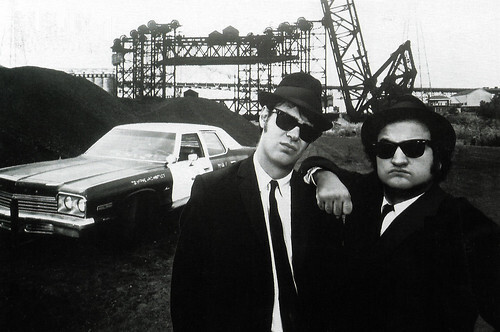
Italian postcard by Emilio Modric Editore, Ancona, no MX 018. Photo: Antony Baker. Dan Aykroyd and John Belushi in The Blues Brothers (John Landis, 1980).
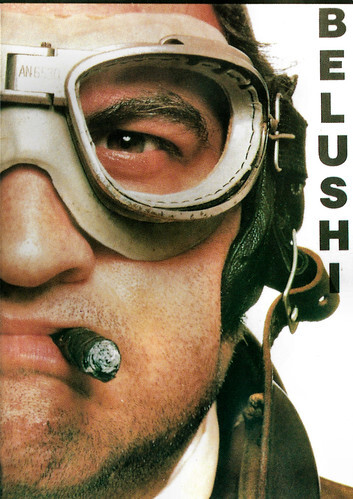
British postcard by Box Office, no. BOPC 3034. Photo: John Belushi in 1941 (Steven Spielberg, 1979).
The perfect all-American boy
John Belushi was born in Chicago, Illinois, in 1949, to Agnes Demetri (Samaras) and Adam Anastos Belushi, a restaurant owner. His father was an Albanian immigrant, from Qytezë, and his mother was also of Albanian descent. He grew up in Wheaton, where the family moved when he was six.
Though a young hellion in grade school, John became the perfect all-American boy during his high school years where he was co-captain of the Wheaton Central High School football team and was elected homecoming king his senior year. He also developed an interest in acting and appeared in the high school variety show. Encouraged by his drama teacher, John decided to put aside his plans to become a football coach to pursue a career in acting.
After graduation in 1967, John performed in summer stock in rural Indiana in a variety of roles from Cardinal Wolsey in 'Anne of a Thousand Days' to a comic detective in 'Ten Little Indians'. In the fall of his freshman year at the University of Wisconsin at Whitewater, John changed his image into a bad-boy appearance by growing his hair long and began to have problems with discipline and the structure of attending classes.
In 1965, Belushi formed a band, the Ravens, together with four fellow high school students (Dick Blasucci, Michael Blasucci, Tony Pavilonis, and Phil Special). They recorded one single, 'Listen to Me Now/Jolly Green Giant'. Belushi played the drums and sang vocals. The record was not successful, and the band broke up when he dropped out of Wisconsin.
John spent the next two years at the College of DuPage, a junior college a few miles from his parents' Wheaton home, where his father began persuading him to become a partner in his restaurant, but John still preferred acting. He also attended the University of Wisconsin–Whitewater for a year, which inspired the famous Animal House scene of D-Day driving a motorcycle up the stairs.
Belushi started his own comedy troupe in Chicago, the West Compass Trio (named after the improvisational cabaret revue Compass Players active from 1955 to 1958 in Chicago), with Tino Insana and Steve Beshekas. Their success piqued the interest of Bernard Sahlins, the founder of The Second City improvised comedy enterprise, who went to see them performing in 1971 and asked Belushi to join the cast.
At Second City he performed in various on-stage comic performances with others, who included Harold Ramis and Joe Flaherty. John loved his life at Second City where he performed six nights a week, perfecting the physical 'gonzo' style of comedy he later made famous. A year later, John and his live-in girlfriend from his high school years, Judy Jacklin, moved to New York because John had joined the cast of 'Lemmings', a parody of Woodstock and a production of the humorous magazine National Lampoon. Besides Belushi, the young comedians Chevy Chase and Christopher Guest were also part of the cast. The off-Broadway rock musical revue was originally booked for a six-week run but played to full crowds for nearly 10 months.
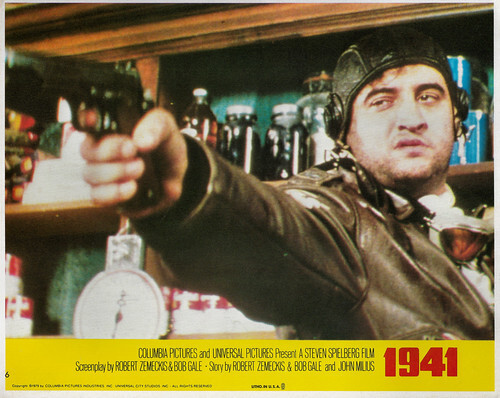
American lobby card, no. 6. Photo: Columbia / Universal. John Belushi in 1941 (Steven Spielberg, 1979).
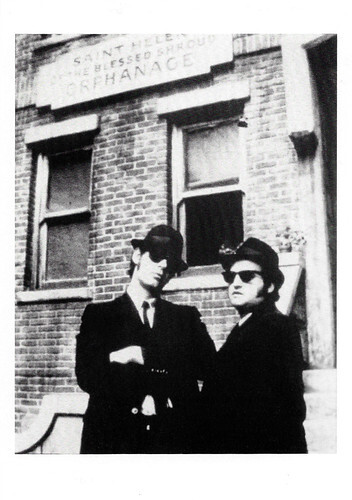
British postcard by Palm Pictures, no. C 26. Photo: Universal. Dan Aykroyd and John Belushi in The Blues Brothers (John Landis, 1980). Caption: Blues Brothers "Saint Helen".
The notorious, beer-swilling Bluto
In 1973, National Lampoon began broadcasting the comedy radio show The National Lampoon Radio Hour and John Belushi made regular appearances, along with Chevy Chase, Gilda Radner, Bill Murray and his brother Brian. Judy Jacklin, who also became the producer of the programme, married Belushi in 1976.
During a trip to Toronto to check out the local Second City cast in 1974, John met Dan Aykroyd. In 1975, Chevy Chase and writer Michael O'Donoghue recommended Belushi to Lorne Michaels as a potential member for a television show Michaels was about to produce for NBC called NBC's Saturday Night, later Saturday Night Live (SNL).
Michaels was initially undecided, as he was not sure if Belushi's physical humour would fit with what he was envisioning, but he changed his mind after giving Belushi an audition. Many employees of The National Lampoon Radio Hour moved to Saturday Night Live. Belushi, Radner, Chase, Dan Aykroyd, George Coe and others made up the cast of the sketch programme's first season.
The ground-breaking TV variety series made Belushi a star. His unpredictable, aggressively physical style of humour flowered on SNL. Two years later, Bill Murray also made his SNL debut. Over his four-year tenure at SNL, Belushi became one of the programme's best-loved comedians, thanks in part to his character Futaba, a samurai. With Aykroyd, Belushi created Jake and Elwood, the Blues Brothers. Originally intended to warm up the studio audience before broadcasts of SNL, the Blues Brothers were eventually featured as musical guests.
In 1978, while still working on Saturday Night Live (1975), John appeared in the films Old Boyfriends (Joan Tewkesbury, 1978) and Goin' South (1978) which starred and was directed by Jack Nicholson .
Director John Landis cast him in National Lampoon's Animal House (John Landis, 1978) as the notorious, beer-swilling "Bluto" and he stole the movie which portrays college fraternity shenanigans at a small college set in the year 1962. Upon its initial release, Animal House received generally mixed reviews from critics, but Time magazine and Roger Ebert proclaimed it one of the year's best movies. Filmed for $2.8 million, it is one of the most profitable movies of all time, garnering an estimated gross of more than $141 million.
In 1979, John Belushi along with fellow SNL regular Dan Aykroyd quit the series to pursue film projects. They appeared together in Steven Spielberg's financially unsuccessful comic war film 1941 (1979) and the next year, they co-starred in the massive hit The Blues Brothers (John Landis, 1980).
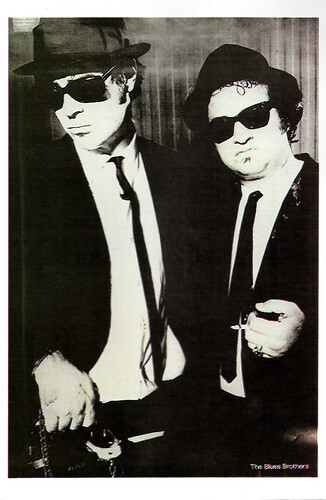
English postcard, no. REF 1009. Dan Aykroyd and John Belushi in The Blues Brothers (John Landis, 1980).
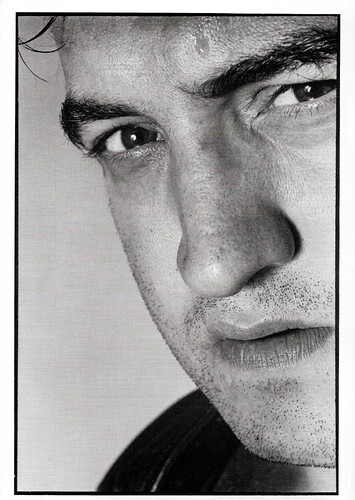
American postcard by Fotofolio, N.Y., N.Y, no. RE17. Photo: Marcia Resnick, 1981.
A pair of white soul men dressed in black suits, fedora hats and Rayban sunglasses
Around this time, John Belushi's drug use began escalating. Cocaine, which was ubiquitous in show-business circles in the 1970s, became his drug of choice. After he first experimented with cocaine in the mid-1970s, John almost immediately became addicted to it. His frequent cocaine sniffing binges became a source of friction between him and Judy, whom he married in 1976.
John's love for blues and soul music inspired the Blues Brothers. He and Aykroyd first appeared as Joliet Jake and Elwood Blues, a pair of white soul men dressed in black suits, skinny ties, fedora hats and Rayban sunglasses, as a warm-up act before the telecasts of Saturday Night Live (1975). Building on the success of their acts and the release of their album 'A Briefcase Full of Blues', John and Dan Aykroyd starred in the film, which gave John a chance to act with his favourite musical heroes including Ray Charles, James Brown and Aretha Franklin.
The Blues Brothers (John Landis, 1980) became his best-known film. Using some of his money, John Belushi bought his father a ranch outside San Diego for him to live. John helped set up some of his Chicago friends with their own businesses and even financially helped his younger brother, Jim Belushi, who followed his older brother's path to both Second City and Saturday Night Live.
In 1981, John appeared in the film Continental Divide (Michael Apted, 1981), playing a hard-nosed Chicago newspaperman who finds romance in Colorado with eagle expert Blair Brown. That same year, John and Dan Aykroyd appeared again in the comedy Neighbors (John G. Avildsen, 1981), which gave them a chance to reverse roles, with John playing a straight-arrow family man whose life is turned upside down when a wild family man (Aykroyd) moves in next door. However, neither film could repeat the success of The Blues Brothers.
In 1982, John checked into a bungalow at the Chateau Marmont, a popular celebrity hotel in Los Angeles. John's drug use had been steadily increasing for over a year now, which alarmed his wife and friends, but he continued to promise Judy that he would quit someday. On 5 March 1982, John Belushi was found dead of a drug overdose in his hotel room. He was 33. The local coroner gave the cause of death as a lethal injection of cocaine and heroin.
Several years later, John's drug dealing/drug user companion during his final weeks, Cathy Evelyn Smith, was tried and sentenced to three years in prison for supplying John with the drugs. Close friend James Taylor sang 'That Lonesome Road' at a memorial service at Martha's Vineyard cemetery where John was buried. Dan Aykroyd wrote the screenplays for Ghostbusters and Spies Like Us. In both films, he had foreseen a role for Belushi. The role in Ghostbusters was eventually played by Bill Murray, and in Spies Like Us by Chevy Chase. Belushi was posthumously honoured with a star on the Hollywood Walk of Fame in 2004.
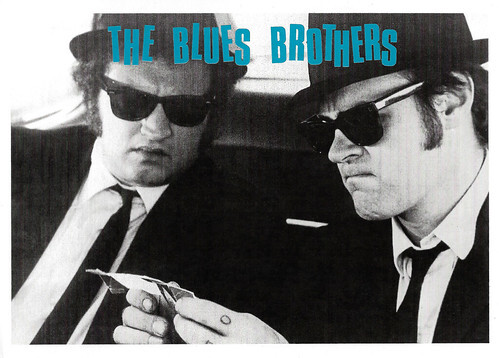
British postcard by Heroes, London, no. SPC 2172. Dan Aykroyd and John Belushi in The Blues Brothers (John Landis, 1980).
Sources: Wikipedia (Dutch and English) and .

Italian postcard by Emilio Modric Editore, Ancona, no MX 018. Photo: Antony Baker. Dan Aykroyd and John Belushi in The Blues Brothers (John Landis, 1980).

British postcard by Box Office, no. BOPC 3034. Photo: John Belushi in 1941 (Steven Spielberg, 1979).
The perfect all-American boy
John Belushi was born in Chicago, Illinois, in 1949, to Agnes Demetri (Samaras) and Adam Anastos Belushi, a restaurant owner. His father was an Albanian immigrant, from Qytezë, and his mother was also of Albanian descent. He grew up in Wheaton, where the family moved when he was six.
Though a young hellion in grade school, John became the perfect all-American boy during his high school years where he was co-captain of the Wheaton Central High School football team and was elected homecoming king his senior year. He also developed an interest in acting and appeared in the high school variety show. Encouraged by his drama teacher, John decided to put aside his plans to become a football coach to pursue a career in acting.
After graduation in 1967, John performed in summer stock in rural Indiana in a variety of roles from Cardinal Wolsey in 'Anne of a Thousand Days' to a comic detective in 'Ten Little Indians'. In the fall of his freshman year at the University of Wisconsin at Whitewater, John changed his image into a bad-boy appearance by growing his hair long and began to have problems with discipline and the structure of attending classes.
In 1965, Belushi formed a band, the Ravens, together with four fellow high school students (Dick Blasucci, Michael Blasucci, Tony Pavilonis, and Phil Special). They recorded one single, 'Listen to Me Now/Jolly Green Giant'. Belushi played the drums and sang vocals. The record was not successful, and the band broke up when he dropped out of Wisconsin.
John spent the next two years at the College of DuPage, a junior college a few miles from his parents' Wheaton home, where his father began persuading him to become a partner in his restaurant, but John still preferred acting. He also attended the University of Wisconsin–Whitewater for a year, which inspired the famous Animal House scene of D-Day driving a motorcycle up the stairs.
Belushi started his own comedy troupe in Chicago, the West Compass Trio (named after the improvisational cabaret revue Compass Players active from 1955 to 1958 in Chicago), with Tino Insana and Steve Beshekas. Their success piqued the interest of Bernard Sahlins, the founder of The Second City improvised comedy enterprise, who went to see them performing in 1971 and asked Belushi to join the cast.
At Second City he performed in various on-stage comic performances with others, who included Harold Ramis and Joe Flaherty. John loved his life at Second City where he performed six nights a week, perfecting the physical 'gonzo' style of comedy he later made famous. A year later, John and his live-in girlfriend from his high school years, Judy Jacklin, moved to New York because John had joined the cast of 'Lemmings', a parody of Woodstock and a production of the humorous magazine National Lampoon. Besides Belushi, the young comedians Chevy Chase and Christopher Guest were also part of the cast. The off-Broadway rock musical revue was originally booked for a six-week run but played to full crowds for nearly 10 months.

American lobby card, no. 6. Photo: Columbia / Universal. John Belushi in 1941 (Steven Spielberg, 1979).

British postcard by Palm Pictures, no. C 26. Photo: Universal. Dan Aykroyd and John Belushi in The Blues Brothers (John Landis, 1980). Caption: Blues Brothers "Saint Helen".
The notorious, beer-swilling Bluto
In 1973, National Lampoon began broadcasting the comedy radio show The National Lampoon Radio Hour and John Belushi made regular appearances, along with Chevy Chase, Gilda Radner, Bill Murray and his brother Brian. Judy Jacklin, who also became the producer of the programme, married Belushi in 1976.
During a trip to Toronto to check out the local Second City cast in 1974, John met Dan Aykroyd. In 1975, Chevy Chase and writer Michael O'Donoghue recommended Belushi to Lorne Michaels as a potential member for a television show Michaels was about to produce for NBC called NBC's Saturday Night, later Saturday Night Live (SNL).
Michaels was initially undecided, as he was not sure if Belushi's physical humour would fit with what he was envisioning, but he changed his mind after giving Belushi an audition. Many employees of The National Lampoon Radio Hour moved to Saturday Night Live. Belushi, Radner, Chase, Dan Aykroyd, George Coe and others made up the cast of the sketch programme's first season.
The ground-breaking TV variety series made Belushi a star. His unpredictable, aggressively physical style of humour flowered on SNL. Two years later, Bill Murray also made his SNL debut. Over his four-year tenure at SNL, Belushi became one of the programme's best-loved comedians, thanks in part to his character Futaba, a samurai. With Aykroyd, Belushi created Jake and Elwood, the Blues Brothers. Originally intended to warm up the studio audience before broadcasts of SNL, the Blues Brothers were eventually featured as musical guests.
In 1978, while still working on Saturday Night Live (1975), John appeared in the films Old Boyfriends (Joan Tewkesbury, 1978) and Goin' South (1978) which starred and was directed by Jack Nicholson .
Director John Landis cast him in National Lampoon's Animal House (John Landis, 1978) as the notorious, beer-swilling "Bluto" and he stole the movie which portrays college fraternity shenanigans at a small college set in the year 1962. Upon its initial release, Animal House received generally mixed reviews from critics, but Time magazine and Roger Ebert proclaimed it one of the year's best movies. Filmed for $2.8 million, it is one of the most profitable movies of all time, garnering an estimated gross of more than $141 million.
In 1979, John Belushi along with fellow SNL regular Dan Aykroyd quit the series to pursue film projects. They appeared together in Steven Spielberg's financially unsuccessful comic war film 1941 (1979) and the next year, they co-starred in the massive hit The Blues Brothers (John Landis, 1980).

English postcard, no. REF 1009. Dan Aykroyd and John Belushi in The Blues Brothers (John Landis, 1980).

American postcard by Fotofolio, N.Y., N.Y, no. RE17. Photo: Marcia Resnick, 1981.
A pair of white soul men dressed in black suits, fedora hats and Rayban sunglasses
Around this time, John Belushi's drug use began escalating. Cocaine, which was ubiquitous in show-business circles in the 1970s, became his drug of choice. After he first experimented with cocaine in the mid-1970s, John almost immediately became addicted to it. His frequent cocaine sniffing binges became a source of friction between him and Judy, whom he married in 1976.
John's love for blues and soul music inspired the Blues Brothers. He and Aykroyd first appeared as Joliet Jake and Elwood Blues, a pair of white soul men dressed in black suits, skinny ties, fedora hats and Rayban sunglasses, as a warm-up act before the telecasts of Saturday Night Live (1975). Building on the success of their acts and the release of their album 'A Briefcase Full of Blues', John and Dan Aykroyd starred in the film, which gave John a chance to act with his favourite musical heroes including Ray Charles, James Brown and Aretha Franklin.
The Blues Brothers (John Landis, 1980) became his best-known film. Using some of his money, John Belushi bought his father a ranch outside San Diego for him to live. John helped set up some of his Chicago friends with their own businesses and even financially helped his younger brother, Jim Belushi, who followed his older brother's path to both Second City and Saturday Night Live.
In 1981, John appeared in the film Continental Divide (Michael Apted, 1981), playing a hard-nosed Chicago newspaperman who finds romance in Colorado with eagle expert Blair Brown. That same year, John and Dan Aykroyd appeared again in the comedy Neighbors (John G. Avildsen, 1981), which gave them a chance to reverse roles, with John playing a straight-arrow family man whose life is turned upside down when a wild family man (Aykroyd) moves in next door. However, neither film could repeat the success of The Blues Brothers.
In 1982, John checked into a bungalow at the Chateau Marmont, a popular celebrity hotel in Los Angeles. John's drug use had been steadily increasing for over a year now, which alarmed his wife and friends, but he continued to promise Judy that he would quit someday. On 5 March 1982, John Belushi was found dead of a drug overdose in his hotel room. He was 33. The local coroner gave the cause of death as a lethal injection of cocaine and heroin.
Several years later, John's drug dealing/drug user companion during his final weeks, Cathy Evelyn Smith, was tried and sentenced to three years in prison for supplying John with the drugs. Close friend James Taylor sang 'That Lonesome Road' at a memorial service at Martha's Vineyard cemetery where John was buried. Dan Aykroyd wrote the screenplays for Ghostbusters and Spies Like Us. In both films, he had foreseen a role for Belushi. The role in Ghostbusters was eventually played by Bill Murray, and in Spies Like Us by Chevy Chase. Belushi was posthumously honoured with a star on the Hollywood Walk of Fame in 2004.

British postcard by Heroes, London, no. SPC 2172. Dan Aykroyd and John Belushi in The Blues Brothers (John Landis, 1980).
Sources: Wikipedia (Dutch and English) and .
Published on July 02, 2022 22:00
July 1, 2022
Directed by F.W. Murnau
Tonight, Il Cinema Ritrovato 2022 ends with one of the first horror films, Nosferatu (1922) by Friedrich Wilhelm Murnau. The Bologna Opera House Orchestra, conducted by Timothy Brock, will accompany this masterpiece turning 100. Nosferatu is one of the cornerstones of horror and expressionist cinema, and will likely hypnotise the Piazza Maggiore audience. EFSP presents a post on the films directed by F.W. Murnau.
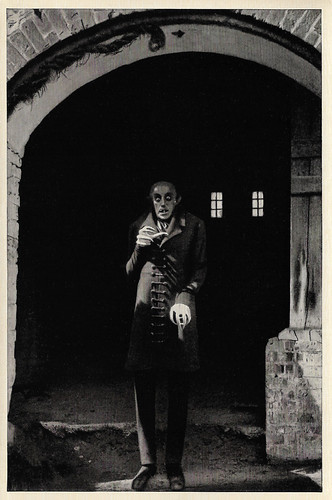
German collectors card by Ross Verlag in the series Vom Werden Deutscher Filmkunst - Der Stumme Film, no. 134. Photo: Ufa. Max Schreck in the first German horror film, Nosferatu – Eine Symphonie des Grauens/Nosferatu (Friedrich Wilhelm Murnau, 1922).
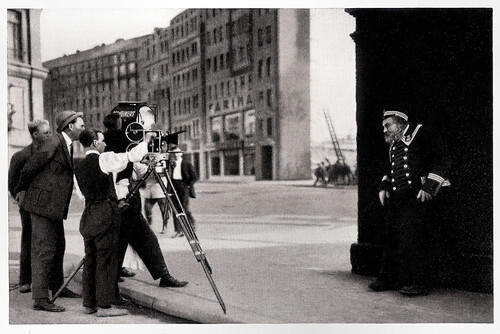
German collectors card by Ross Verlag in the series Vom Werden Deutscher Filmkunst - Der Stumme Film, picture, no, 160, Group 43. Photo: Ufa. Friedrich Wilhelm Murnau (left with hat) and Emil Jannings (right) at the set of Der letzte Mann/The Last Laugh (Friedrich Wilhelm Murnau, 1924). Caption: Der letzte Mann wird gefilmt, mit feststehendem Kamerastativ. (The Last Laugh is filmed, with a fixed camera).
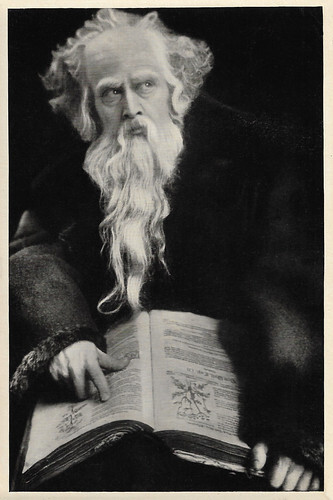
German collectors card by Ross Verlag in the series Vom Werden Deutscher Filmkunst - Der Stumme Film, no. 171. Photo: Ufa. Gösta Ekman as the old Faust in Faust, Eine deutsche Volkssage/Faust (Friedrich Wilhelm Murnau, 1926).
Der brennende Acker (1922)
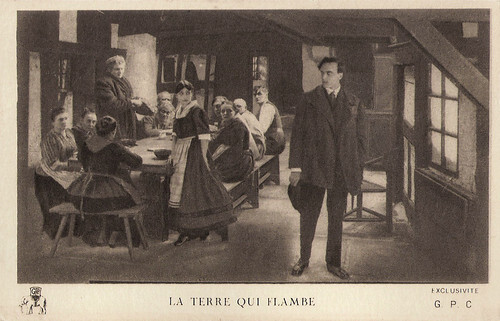
French postcard by Edition de la Cinématographie Française, Paris. Photo: G.P.C. Publicity still for Der brennende Acker/Burning Soil/La terre qui flambe (Friedrich Wilhelm Murnau, 1922). At the farm of the Rog family. The housemaid Maria (Grete Diercks) eyes Johannes Rog ( Vladimir Gajdarov ), but he is only interested in money.

French postcard by Edition de la Cinématographie Française, Paris. Photo: G.P.C. Publicity still for Der brennende Acker/Burning Soil/La terre qui flambe (Friedrich Wilhelm Murnau, 1922) with Eugen Klöpfer. Maria works in the household of Peter Rog (Eugen Klopfer) and his father. Peter is in love with her and wants to marry her, but she instead loves his younger brother Johannes.
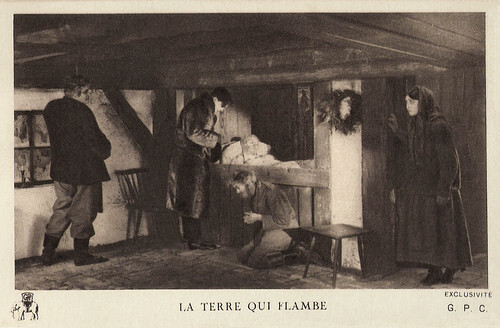
French postcard by Edition de la Cinématographie Française, Paris. Photo: G.P.C. Publicity still for Der brennende Acker/Burning Soil/La terre qui flambe (Friedrich Wilhelm Murnau, 1922). Johannes Rog ( Vladimir Gajdarov ) arrives too late at the deathbed of his father ( Werner Krauss ), while, left, his brother Peter (Eugen Klöpfer), and right, the maid Maria (Grete Diercks), look on.
In 1919, Friedrich Wilhelm Murnau began working in film. His first feature film, Der Knabe in Blau/The Boy in Blue (1919), based on motifs from the painting 'The Blue Boy' by Thomas Gainsborough, is lost, as are some of his later films. The film Der Bucklige und die Tänzerin/The Hunchback and the Dancer (1920) marked the beginning of a highly fruitful collaboration with screenwriter Carl Mayer, who subsequently wrote the scripts for six more of Murnau's films.
Until 1978, the drama Der brennende Acker/Burning Soil (1922) was also believed to be a lost film. Then an almost complete copy was found in the collection of an Italian priest. The priest had regularly screened old films in psychiatric clinics.
When the old farmer Rog ( Werner Krauss ) dies, his son Johannes ( Vladimir Gajdarov ), coming from the city, does not make it to his deathbed in time. After Rog's death, his other son Peter (Eugen Klöpfer) takes over the farm.
Johannes, who does not consider himself suitable for work in the countryside, becomes a secretary to Count Rudenburg. Johannes is interested in the latter's daughter Gerda, who had arranged the job for him, but when he learns that a source of petroleum is suspected under the "Teufelsacker" (The Devil's acre) - a barren piece of land that Rudenburg had bequeathed to his second wife Helga in his will - he turns his attention to it.
Murnau's most famous film from this period is Nosferatu – Eine Symphonie des Grauens (1922) with Max Schreck in the title role, a film adaptation of Bram Stoker's 'Dracula', but which had to be renamed due to licensing problems.
Die Finanzen des Großherzogs (1924)
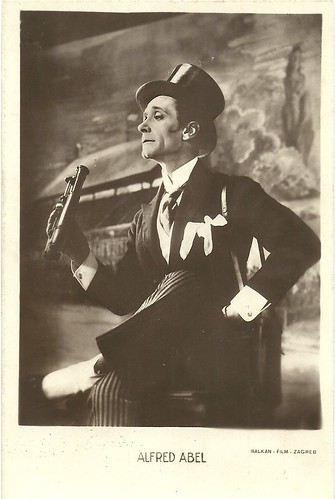
Yugoslavian postcard by Jos. Caklovic, Zagreb, no. 37. Photo: Balkan Film, Zagreb. Alfred Abel in Die Finanzen des Großherzogs (F. W. Murnau, 1924). Collection: Didier Hanson.
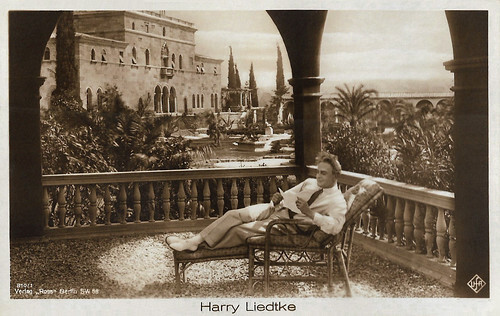
German postcard by Ross Verlag, no. 810/1. Ufa. Harry Liedtke in Die Finanzen des Großherzogs/The Grand Duke's Finances (F. W. Murnau, 1924).
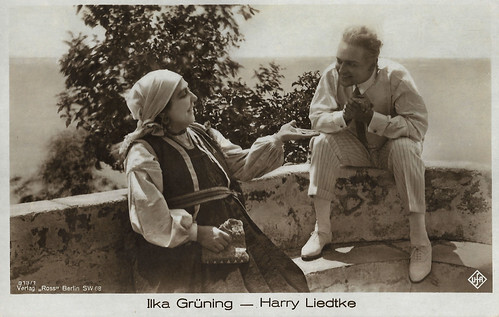
German postcard by Ross Verlag, Berlin, no. 813/1. Photo: Ufa. Ilka Grüning and Harry Liedtke in Die Finanzen des Großherzogs/The Grand Duke's Finances (F. W. Murnau, 1924).
Murnau followed with another masterpiece, the romantic fantasy Phantom (1922) starring Alfred Abel , Grete Diercks and Lil Dagover . Phantom is an example of German Expressionist film and has a surreal, dreamlike quality.
Then followed a little gem, Die Finanzen des Großherzogs/The Grand Duke's Finances (1924). It is one of the rare comedies directed by F. W. Murnau. Harry Liedtke is the Grand Duke of Abacco who is heir to a small and heavily indebted Mediterranean island.
The Grand Duke is trying to hide from usurer Marcowitz who demands debt repayment. One hope to improve the situation would be a wedding with the Russian Grand Duchess Olga ( Mady Christians ) who sent him a letter saying she is determined to marry him despite not knowing him and against the opposition of her brother the Crown Prince of Russia.
Die Finanzen des Großherzogs/The Grand Duke's Finances is based on the eponymous novel by Swedish author Frank Heller adapted by Thea von Harbou. It was shot from May to August 1923 at UFA's Tempelhof Studios in Berlin, on the sets built by Rochus Gliese and Erich Czerwonski. The on-location scenes were shot on the Adriatic coast in Split, Kotor, Zadar and Rab.
Der Letzte Mann (1924)
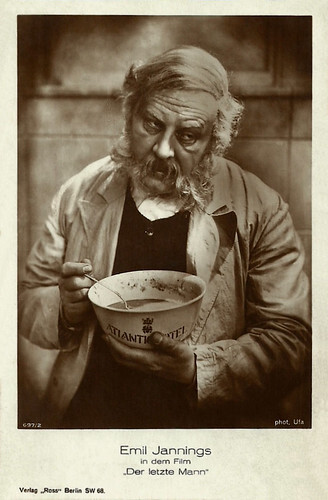
German postcard by Ross Verlag, no. 697/2. Photo: Ufa. Emil Jannings in Der Letzte Mann/The Last Laugh (1924).
F.W. Murnau was now at the height of his film career in Germany and had high ambitions for his first film with UFA. He stated that "All our efforts must be directed towards abstracting everything that isn't the true domain of the cinema. Everything that is trivial and acquired from other sources, all the tricks, devices and cliches inherited from the stage and from books."
His film, Der letzte Mann/The Last Laugh (1924) was based on a screenplay written by Carl Mayer and stars the great Emil Jannings and Maly Delschaft . Jannings plays a proud hotel doorman who loses his self-esteem and that of others when he is reduced to a toilet man, working in the basement of the hotel.
Der Letzte Mann/The Last Laugh is a cinematic example of the Kammerspielfilm or "chamber-drama" genre, which follows the style of short, sparse plays of lower middle-class life that emphasized the psychology of the characters rather than the sets and action. The film famously uses no intertitles that characterize most silent films, in the belief that the visuals themselves should carry most of the meaning.
Cinematographer Karl Freund used elaborate camera movements for the film, a technique later called "entfesselte Kamera" (unchained camera). In one scene a camera was strapped to Freund's chest as he rode a bicycle into an elevator and onto the street below. In another scene a camera is sent down a wire from a window to the street below, and later reversed in editing.
The moving of the location of the camera, blurring of a part of the screen, focusing and defocusing, combined with using different angles, contributed to creating new perspectives and impressions of the viewers. The montage that was used in putting the scenes together was also pioneering: Murnau's technique was to use a smooth and rapid cutting in the initial scenes followed by jarred cutting in the scenes where the doorman becomes humiliated. A combination of distortion and overlapping of images was used in the scenes illustrating private vision of the drunk doorman. The cameramen provided enhancements to Jannings's creative use of body language by using close ups and camera angles that encouraged the viewer to see the events from the doorman's perspective.
Tartüff (1925)
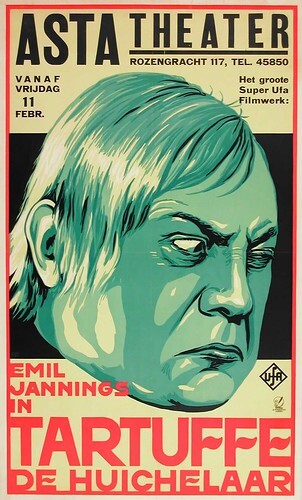
Dutch poster by Frans Bosen for Tartüff/Tartuffe (F.W. Murnau, 1925) starring Emil Jannings .
Friedrich Wilhelm Murnau based his drama Tartüff (1925) on the 1664 social comedy 'Tartuffe ou L'Imposteur' by Molière, but set in the present day.
A wealthy old man (Hermann Picha) is cared for by his housekeeper (Rosa Valetti). Since she is after his fortune, she persistently tries to convince him to include her in the will instead of his grandson. Through intrigue, she succeeds. In order to get her hands on the inheritance, she then begins to slowly poison the old man.
The grandson ( André Mattoni ) becomes suspicious, but does not approach his grandfather to warn him at first. Now it turns out that his choice of profession as an actor is an advantage. He disguises himself as the operator of a travelling cinema and drives up in front of his grandfather's house. At first the housekeeper wants to turn him away, but then she lets herself be persuaded by his charm to let him perform a film in the house.
The film shown is Tartüff, a film whose story is about a hypocrite ( Emil Jannings ) and the all-too-casual belief in him. The hypocrite in the film is exposed and so is the housekeeper after the screening: she is thrown out and grandfather and grandson are in each other's arms. According to the film, hypocrites can therefore also be called tartuffees.
In retrospective reviews, critics commented on the film's mise-en-scene and praised the performances. Several critics noted the rarity of a comedy directed by Murnau, who was famous for the expressionist dramas. Its humorous storyline and happy ending has rendered it a minor work in Murnau's filmography and has led film critic Jonathan Rosenbaum to call it "underrated".
Faust (1926)
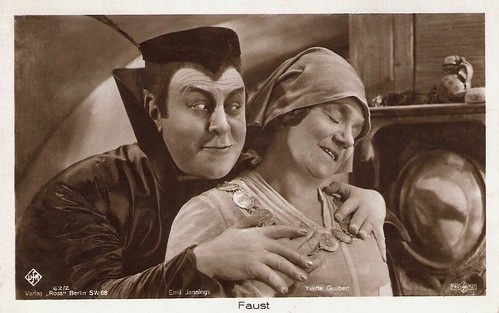
German postcard by Ross Verlag, no. 62/2. Photo: Parufamet / Ufa. Emil Jannings as Mephisto and Yvette Guilbert as Marthe in Faust (F.W. Murnau, 1926).
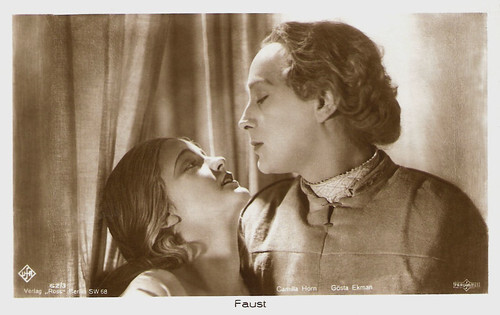
German postcard by Ross Verlag, no. 62/3. Photo: Parufamet. Gösta Ekman and Camilla Horn in Faust (1926).
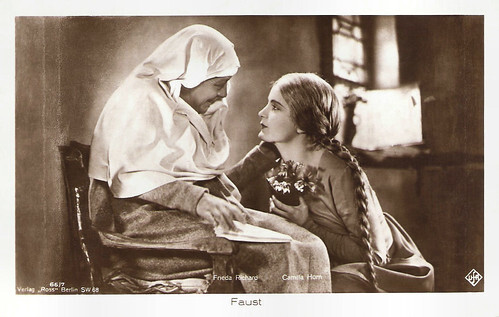
German postcard by Ross Verlag, no. 66/7. Photo: Ufa. Camilla Horn and Frieda Richard in Faust (Friedrich Wilhelm Murnau, 1926).
Faust – Eine deutsche Volkssage/Faust – A German Folktale (1926) was Murnau's final German film, produced by Ufa, and starring Gösta Ekman as Faust, Emil Jannings as Mephisto, Camilla Horn as Gretchen/Marguerite, Frida Richard as her mother, Wilhelm Dieterle as her brother and Yvette Guilbert as Marthe Schwerdtlein, her aunt.
The demon Mephisto has a bet with an Archangel that he can corrupt a righteous man's soul and destroy in him what is divine. If he succeeds, the Devil will win dominion over earth. The Devil delivers a plague to the village where Faust, an elderly alchemist, lives. Though he prays to stop the death and starvation, nothing happens. Disheartened, Faust throws his alchemy books in the fire, and then the Bible too. One book opens, showing how to have power and glory by making a pact with the Devil. Faust then makes a deal with Mephisto, who gives Faust back his youth and offers him earthly pleasures and a kingdom, in return for his immortal soul.
Murnau's film draws on older traditions of the legendary tale of Faust as well as on Goethe's classic 1808 version. Ufa wanted Ludwig Berger to direct Faust, as Murnau was engaged with Variété/Variety. Murnau pressured producer Erich Pommer and, backed by Emil Jannings , eventually persuaded Pommer to let him direct the film.
Directly afterward Friedrich Wilhelm Murnau moved to the US under contract to William Fox. When Faust – Eine deutsche Volkssage/Faust – A German Folktale premiered in the Ufa-Palast am Zoo in Berlin, Murnau was already shooting in Hollywood. Faust seriously affected studio shooting and special effects techniques. Murnau uses two cameras, both filming multiple shots; many scenes were filmed time and again. As an example, a short sequence of the contract being written on parchment in fire took an entire day to film.
Faust – Eine deutsche Volkssage/Faust – A German Folktale has been praised for its special effects and is regarded as an example of German Expressionist film. Murnau's Faust was the most technically elaborate and expensive production undertaken by Ufa until it was surpassed by Metropolis the following year. Filming took six months, at a cost of 2 million marks (only half was recovered at the box office). A 2006 review in The New York Times called it "one of the most astonishing visual experiences the silent cinema has to offer."
Sunrise (1927)
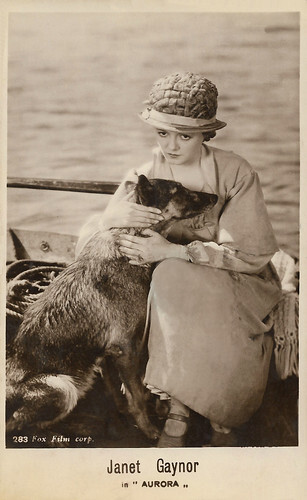
Italian postcard by G. B. Falci Editore, Milano, no. 283. Photo: Fox Film. Janet Gaynor in Sunrise (F.W. Murnau, 1927).
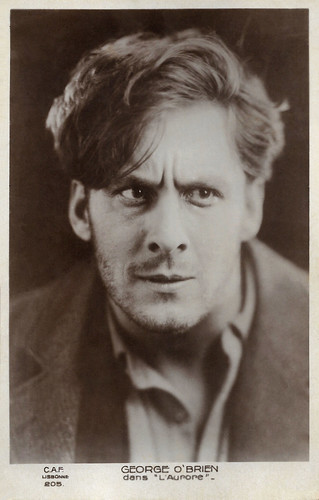
French postcard by CAF, Lisonne, no. 205. George O'Brien in Sunrise (F.W. Murnau, 1927).
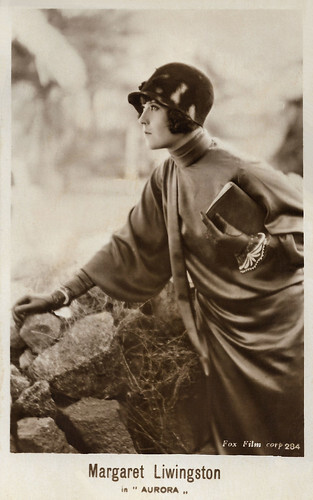
Italian postcard by G. B. Falci Editore, Milano, no. 284. Photo: Fox Film. Margaret Livingston in Sunrise (F.W. Murnau, 1927). The last name is misspelled as Liwingston.
Friedrich Wilhelm Murnau's first film in the United State was the romantic drama Sunrise/Sunrise: A Song of Two Humans (1927) starring George O'Brien and Janet Gaynor . The plot is based on Hermann Sudermann's story 'Die Reise nach Tilsit' (The Journey to Tilsit).
A vacationing Woman from the City ( Margaret Livingston ) lingers in a lakeside town for weeks. After dark, she goes to a farmhouse where the Man ( George O'Brien ) and the Wife ( Janet Gaynor ) live with their child. She whistles from the fence outside. The Man is torn, but finally departs, leaving his wife with the memories of better times when they were deeply in love.
The man and woman meet in the moonlight and kiss passionately. She wants him to sell his farm—which has not done well recently—to join her in the city. When she suggests that he solve the problem of his wife by drowning her, he throttles her violently, but even that dissolves in a passionate embrace. The Woman gathers bundles of reeds so that when the boat is overturned, the Man can stay afloat.
The Wife suspects nothing when her husband suggests going on an outing, but when they set off across the lake, she soon grows suspicious. He prepares to throw her overboard, but when she pleads for his mercy, he realizes he cannot do it. He rows frantically for shore, and when the boat reaches land, the Wife flees...
Murnau chose to use the then new Fox Movietone sound-on-film system, making Sunrise one of the first feature films with a synchronized musical score and sound effects soundtrack. The film incorporated Charles Gounod's 1872 composition 'Funeral March of a Marionette', which was later used as the theme for the television series Alfred Hitchcock Presents (1955–1965). Frédéric Chopin's 'A minor prelude' also features prominently in orchestral arrangement.
Upon its release, the film received excellent reviews and won three Oscars. Sunrise won the Academy Award for Unique and Artistic Picture at the 1st Academy Awards in 1929. Janet Gaynor won the first Academy Award for Best Actress in a Leading Role for her performance in the film and also for her performances in 7th Heaven (1927) and Street Angel (1928). But Sunrise became a flop at the box office.
Sunrise's legacy has endured, and it is now widely considered a masterpiece and one of the greatest films ever made. In 2012, Sunrise was ranked fifth among the best films of all time in a poll of film critics by Sight & Sound magazine. The French film magazine Cahiers du cinéma listed it in fourth place in 2008.
4 Devils (1928)
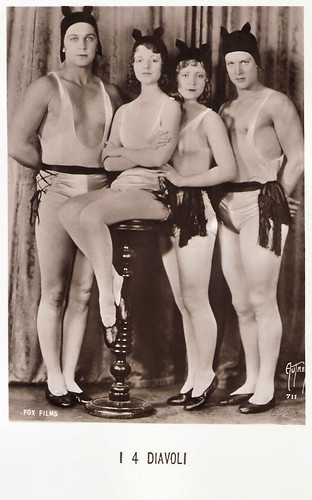
Italian postcard by G.B. Falci Editore, Milano, no. 711 Photo: Charles Munn Autrey / Fox. Charles Morton , Janet Gaynor , Nancy Drexel, and Barry Norton in 4 Devils (Friedrich Wilhelm Murnau, 1928). 4 Devils is one of the most famous 'lost' films.
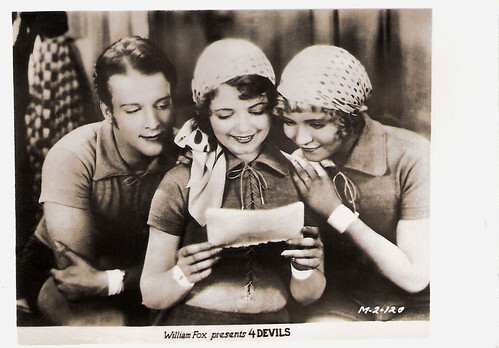
Dutch postcard. Photo: Fox. Publicity still for 4 Devils (F.W. Murnau, 1928) with Barry Norton, Janet Gaynor and Nancy Drexel.
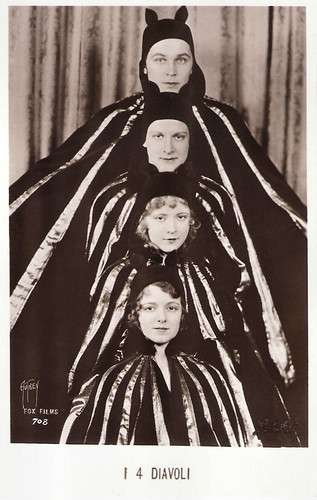
Italian postcard by G.B. Falci Editore, Milano, no. 708. Photo: Max Munn Autrey / Fox. Janet Gaynor , Nancy Drexel, Barry Norton and Charles Morton in 4 Devils (Friedrich Wilhelm Murnau, 1928).
When Sunrise did not quite meet commercial expectations, and because of the increasingly difficult economic situation of the Fox company and the situation in Hollywood on the threshold of the talkies, Friedrich Wilhelm Murnau had to accept increasing interference in his artistic concept in his following films; in the case of the film City Girl, he was even replaced as director and a sound version was subsequently produced without his influence.
4 Devils/Four Devils (1928), the film Murnau made in between Sunrise and City Girl was based on the story 'De Fire Djævle' by Danish writer Herman Bang. An old clown takes in the four children Charles, Adolf, Marion and Louise to protect them from the brutal circus owner who is their guardian. He raises them and trains them to be acrobats. The years pass and they become successful trapeze artists who call themselves the "Four Devils". Charles and Marion are now a couple. But when they perform at the Cirque Olympia in Paris, Charles gets involved with a beautiful stranger.
Mordaunt Hall of the New York Times praised Murnau's work for keeping the interest in the film from the first shot to the last. Not only are the actors directed with unmatched skill, but the camerawork is smooth and seductive. Today, the film is considered lost. The original negative was destroyed in a fire and Fox apparently did nothing to secure the film material that remained intact. In 1948, the last 35 mm print was handed over to actress Mary Duncan. Nothing is known about the whereabouts of the print.
Disappointed by the constraints of Hollywood, F.W. Murnau terminated his contract with Fox in 1929. After an unsuccessful attempt to do business with UFA again in Berlin, he bought a sailing yacht, determined to make his next film on his own according to his own ideas, and went to Tahiti to shoot the film Tabu/Taboo with the director and documentary filmmaker Robert J. Flaherty.
During the shooting there were considerable difficulties with the film company financing the shooting costs. Eventually, Murnau parted ways with Flaherty, who had stronger documentary ambitions, and produced the film at his own expense. Shot on the island of Bora Bora exclusively with local amateur actors, the film became a stylistic mixture of documentary and melodrama. The distribution of the film, financed by Murnau himself, for which he had spent his entire fortune and incurred heavy debts, was taken over by the company Paramount, which was so impressed by the film that it offered Murnau a ten-year contract.
Murnau did not live to see the premiere of Tabu/Taboo. On 11 March 1931, shortly before a planned promotional tour through Europe, Murnau let his servant, the 14-year-old Filipino Garcia Stevenson, take the wheel of his rental car on the coastal road southeast of Santa Barbara (California). As a result of excessive speed, the servant lost control of the vehicle, which plunged down a ten-metre embankment, hitting the back of Murnau's head against a utility pole. While the other occupants of the vehicle - in addition to Stevenson, the actual chauffeur and Murnau's sheepdog - remained almost uninjured, Murnau died in hospital the following night. Only eleven people attended his funeral on 19 March, including Greta Garbo .
Sources: Wikipedia (German and English), and .

German collectors card by Ross Verlag in the series Vom Werden Deutscher Filmkunst - Der Stumme Film, no. 134. Photo: Ufa. Max Schreck in the first German horror film, Nosferatu – Eine Symphonie des Grauens/Nosferatu (Friedrich Wilhelm Murnau, 1922).

German collectors card by Ross Verlag in the series Vom Werden Deutscher Filmkunst - Der Stumme Film, picture, no, 160, Group 43. Photo: Ufa. Friedrich Wilhelm Murnau (left with hat) and Emil Jannings (right) at the set of Der letzte Mann/The Last Laugh (Friedrich Wilhelm Murnau, 1924). Caption: Der letzte Mann wird gefilmt, mit feststehendem Kamerastativ. (The Last Laugh is filmed, with a fixed camera).

German collectors card by Ross Verlag in the series Vom Werden Deutscher Filmkunst - Der Stumme Film, no. 171. Photo: Ufa. Gösta Ekman as the old Faust in Faust, Eine deutsche Volkssage/Faust (Friedrich Wilhelm Murnau, 1926).
Der brennende Acker (1922)

French postcard by Edition de la Cinématographie Française, Paris. Photo: G.P.C. Publicity still for Der brennende Acker/Burning Soil/La terre qui flambe (Friedrich Wilhelm Murnau, 1922). At the farm of the Rog family. The housemaid Maria (Grete Diercks) eyes Johannes Rog ( Vladimir Gajdarov ), but he is only interested in money.

French postcard by Edition de la Cinématographie Française, Paris. Photo: G.P.C. Publicity still for Der brennende Acker/Burning Soil/La terre qui flambe (Friedrich Wilhelm Murnau, 1922) with Eugen Klöpfer. Maria works in the household of Peter Rog (Eugen Klopfer) and his father. Peter is in love with her and wants to marry her, but she instead loves his younger brother Johannes.

French postcard by Edition de la Cinématographie Française, Paris. Photo: G.P.C. Publicity still for Der brennende Acker/Burning Soil/La terre qui flambe (Friedrich Wilhelm Murnau, 1922). Johannes Rog ( Vladimir Gajdarov ) arrives too late at the deathbed of his father ( Werner Krauss ), while, left, his brother Peter (Eugen Klöpfer), and right, the maid Maria (Grete Diercks), look on.
In 1919, Friedrich Wilhelm Murnau began working in film. His first feature film, Der Knabe in Blau/The Boy in Blue (1919), based on motifs from the painting 'The Blue Boy' by Thomas Gainsborough, is lost, as are some of his later films. The film Der Bucklige und die Tänzerin/The Hunchback and the Dancer (1920) marked the beginning of a highly fruitful collaboration with screenwriter Carl Mayer, who subsequently wrote the scripts for six more of Murnau's films.
Until 1978, the drama Der brennende Acker/Burning Soil (1922) was also believed to be a lost film. Then an almost complete copy was found in the collection of an Italian priest. The priest had regularly screened old films in psychiatric clinics.
When the old farmer Rog ( Werner Krauss ) dies, his son Johannes ( Vladimir Gajdarov ), coming from the city, does not make it to his deathbed in time. After Rog's death, his other son Peter (Eugen Klöpfer) takes over the farm.
Johannes, who does not consider himself suitable for work in the countryside, becomes a secretary to Count Rudenburg. Johannes is interested in the latter's daughter Gerda, who had arranged the job for him, but when he learns that a source of petroleum is suspected under the "Teufelsacker" (The Devil's acre) - a barren piece of land that Rudenburg had bequeathed to his second wife Helga in his will - he turns his attention to it.
Murnau's most famous film from this period is Nosferatu – Eine Symphonie des Grauens (1922) with Max Schreck in the title role, a film adaptation of Bram Stoker's 'Dracula', but which had to be renamed due to licensing problems.
Die Finanzen des Großherzogs (1924)

Yugoslavian postcard by Jos. Caklovic, Zagreb, no. 37. Photo: Balkan Film, Zagreb. Alfred Abel in Die Finanzen des Großherzogs (F. W. Murnau, 1924). Collection: Didier Hanson.

German postcard by Ross Verlag, no. 810/1. Ufa. Harry Liedtke in Die Finanzen des Großherzogs/The Grand Duke's Finances (F. W. Murnau, 1924).

German postcard by Ross Verlag, Berlin, no. 813/1. Photo: Ufa. Ilka Grüning and Harry Liedtke in Die Finanzen des Großherzogs/The Grand Duke's Finances (F. W. Murnau, 1924).
Murnau followed with another masterpiece, the romantic fantasy Phantom (1922) starring Alfred Abel , Grete Diercks and Lil Dagover . Phantom is an example of German Expressionist film and has a surreal, dreamlike quality.
Then followed a little gem, Die Finanzen des Großherzogs/The Grand Duke's Finances (1924). It is one of the rare comedies directed by F. W. Murnau. Harry Liedtke is the Grand Duke of Abacco who is heir to a small and heavily indebted Mediterranean island.
The Grand Duke is trying to hide from usurer Marcowitz who demands debt repayment. One hope to improve the situation would be a wedding with the Russian Grand Duchess Olga ( Mady Christians ) who sent him a letter saying she is determined to marry him despite not knowing him and against the opposition of her brother the Crown Prince of Russia.
Die Finanzen des Großherzogs/The Grand Duke's Finances is based on the eponymous novel by Swedish author Frank Heller adapted by Thea von Harbou. It was shot from May to August 1923 at UFA's Tempelhof Studios in Berlin, on the sets built by Rochus Gliese and Erich Czerwonski. The on-location scenes were shot on the Adriatic coast in Split, Kotor, Zadar and Rab.
Der Letzte Mann (1924)

German postcard by Ross Verlag, no. 697/2. Photo: Ufa. Emil Jannings in Der Letzte Mann/The Last Laugh (1924).
F.W. Murnau was now at the height of his film career in Germany and had high ambitions for his first film with UFA. He stated that "All our efforts must be directed towards abstracting everything that isn't the true domain of the cinema. Everything that is trivial and acquired from other sources, all the tricks, devices and cliches inherited from the stage and from books."
His film, Der letzte Mann/The Last Laugh (1924) was based on a screenplay written by Carl Mayer and stars the great Emil Jannings and Maly Delschaft . Jannings plays a proud hotel doorman who loses his self-esteem and that of others when he is reduced to a toilet man, working in the basement of the hotel.
Der Letzte Mann/The Last Laugh is a cinematic example of the Kammerspielfilm or "chamber-drama" genre, which follows the style of short, sparse plays of lower middle-class life that emphasized the psychology of the characters rather than the sets and action. The film famously uses no intertitles that characterize most silent films, in the belief that the visuals themselves should carry most of the meaning.
Cinematographer Karl Freund used elaborate camera movements for the film, a technique later called "entfesselte Kamera" (unchained camera). In one scene a camera was strapped to Freund's chest as he rode a bicycle into an elevator and onto the street below. In another scene a camera is sent down a wire from a window to the street below, and later reversed in editing.
The moving of the location of the camera, blurring of a part of the screen, focusing and defocusing, combined with using different angles, contributed to creating new perspectives and impressions of the viewers. The montage that was used in putting the scenes together was also pioneering: Murnau's technique was to use a smooth and rapid cutting in the initial scenes followed by jarred cutting in the scenes where the doorman becomes humiliated. A combination of distortion and overlapping of images was used in the scenes illustrating private vision of the drunk doorman. The cameramen provided enhancements to Jannings's creative use of body language by using close ups and camera angles that encouraged the viewer to see the events from the doorman's perspective.
Tartüff (1925)

Dutch poster by Frans Bosen for Tartüff/Tartuffe (F.W. Murnau, 1925) starring Emil Jannings .
Friedrich Wilhelm Murnau based his drama Tartüff (1925) on the 1664 social comedy 'Tartuffe ou L'Imposteur' by Molière, but set in the present day.
A wealthy old man (Hermann Picha) is cared for by his housekeeper (Rosa Valetti). Since she is after his fortune, she persistently tries to convince him to include her in the will instead of his grandson. Through intrigue, she succeeds. In order to get her hands on the inheritance, she then begins to slowly poison the old man.
The grandson ( André Mattoni ) becomes suspicious, but does not approach his grandfather to warn him at first. Now it turns out that his choice of profession as an actor is an advantage. He disguises himself as the operator of a travelling cinema and drives up in front of his grandfather's house. At first the housekeeper wants to turn him away, but then she lets herself be persuaded by his charm to let him perform a film in the house.
The film shown is Tartüff, a film whose story is about a hypocrite ( Emil Jannings ) and the all-too-casual belief in him. The hypocrite in the film is exposed and so is the housekeeper after the screening: she is thrown out and grandfather and grandson are in each other's arms. According to the film, hypocrites can therefore also be called tartuffees.
In retrospective reviews, critics commented on the film's mise-en-scene and praised the performances. Several critics noted the rarity of a comedy directed by Murnau, who was famous for the expressionist dramas. Its humorous storyline and happy ending has rendered it a minor work in Murnau's filmography and has led film critic Jonathan Rosenbaum to call it "underrated".
Faust (1926)

German postcard by Ross Verlag, no. 62/2. Photo: Parufamet / Ufa. Emil Jannings as Mephisto and Yvette Guilbert as Marthe in Faust (F.W. Murnau, 1926).

German postcard by Ross Verlag, no. 62/3. Photo: Parufamet. Gösta Ekman and Camilla Horn in Faust (1926).

German postcard by Ross Verlag, no. 66/7. Photo: Ufa. Camilla Horn and Frieda Richard in Faust (Friedrich Wilhelm Murnau, 1926).
Faust – Eine deutsche Volkssage/Faust – A German Folktale (1926) was Murnau's final German film, produced by Ufa, and starring Gösta Ekman as Faust, Emil Jannings as Mephisto, Camilla Horn as Gretchen/Marguerite, Frida Richard as her mother, Wilhelm Dieterle as her brother and Yvette Guilbert as Marthe Schwerdtlein, her aunt.
The demon Mephisto has a bet with an Archangel that he can corrupt a righteous man's soul and destroy in him what is divine. If he succeeds, the Devil will win dominion over earth. The Devil delivers a plague to the village where Faust, an elderly alchemist, lives. Though he prays to stop the death and starvation, nothing happens. Disheartened, Faust throws his alchemy books in the fire, and then the Bible too. One book opens, showing how to have power and glory by making a pact with the Devil. Faust then makes a deal with Mephisto, who gives Faust back his youth and offers him earthly pleasures and a kingdom, in return for his immortal soul.
Murnau's film draws on older traditions of the legendary tale of Faust as well as on Goethe's classic 1808 version. Ufa wanted Ludwig Berger to direct Faust, as Murnau was engaged with Variété/Variety. Murnau pressured producer Erich Pommer and, backed by Emil Jannings , eventually persuaded Pommer to let him direct the film.
Directly afterward Friedrich Wilhelm Murnau moved to the US under contract to William Fox. When Faust – Eine deutsche Volkssage/Faust – A German Folktale premiered in the Ufa-Palast am Zoo in Berlin, Murnau was already shooting in Hollywood. Faust seriously affected studio shooting and special effects techniques. Murnau uses two cameras, both filming multiple shots; many scenes were filmed time and again. As an example, a short sequence of the contract being written on parchment in fire took an entire day to film.
Faust – Eine deutsche Volkssage/Faust – A German Folktale has been praised for its special effects and is regarded as an example of German Expressionist film. Murnau's Faust was the most technically elaborate and expensive production undertaken by Ufa until it was surpassed by Metropolis the following year. Filming took six months, at a cost of 2 million marks (only half was recovered at the box office). A 2006 review in The New York Times called it "one of the most astonishing visual experiences the silent cinema has to offer."
Sunrise (1927)

Italian postcard by G. B. Falci Editore, Milano, no. 283. Photo: Fox Film. Janet Gaynor in Sunrise (F.W. Murnau, 1927).

French postcard by CAF, Lisonne, no. 205. George O'Brien in Sunrise (F.W. Murnau, 1927).

Italian postcard by G. B. Falci Editore, Milano, no. 284. Photo: Fox Film. Margaret Livingston in Sunrise (F.W. Murnau, 1927). The last name is misspelled as Liwingston.
Friedrich Wilhelm Murnau's first film in the United State was the romantic drama Sunrise/Sunrise: A Song of Two Humans (1927) starring George O'Brien and Janet Gaynor . The plot is based on Hermann Sudermann's story 'Die Reise nach Tilsit' (The Journey to Tilsit).
A vacationing Woman from the City ( Margaret Livingston ) lingers in a lakeside town for weeks. After dark, she goes to a farmhouse where the Man ( George O'Brien ) and the Wife ( Janet Gaynor ) live with their child. She whistles from the fence outside. The Man is torn, but finally departs, leaving his wife with the memories of better times when they were deeply in love.
The man and woman meet in the moonlight and kiss passionately. She wants him to sell his farm—which has not done well recently—to join her in the city. When she suggests that he solve the problem of his wife by drowning her, he throttles her violently, but even that dissolves in a passionate embrace. The Woman gathers bundles of reeds so that when the boat is overturned, the Man can stay afloat.
The Wife suspects nothing when her husband suggests going on an outing, but when they set off across the lake, she soon grows suspicious. He prepares to throw her overboard, but when she pleads for his mercy, he realizes he cannot do it. He rows frantically for shore, and when the boat reaches land, the Wife flees...
Murnau chose to use the then new Fox Movietone sound-on-film system, making Sunrise one of the first feature films with a synchronized musical score and sound effects soundtrack. The film incorporated Charles Gounod's 1872 composition 'Funeral March of a Marionette', which was later used as the theme for the television series Alfred Hitchcock Presents (1955–1965). Frédéric Chopin's 'A minor prelude' also features prominently in orchestral arrangement.
Upon its release, the film received excellent reviews and won three Oscars. Sunrise won the Academy Award for Unique and Artistic Picture at the 1st Academy Awards in 1929. Janet Gaynor won the first Academy Award for Best Actress in a Leading Role for her performance in the film and also for her performances in 7th Heaven (1927) and Street Angel (1928). But Sunrise became a flop at the box office.
Sunrise's legacy has endured, and it is now widely considered a masterpiece and one of the greatest films ever made. In 2012, Sunrise was ranked fifth among the best films of all time in a poll of film critics by Sight & Sound magazine. The French film magazine Cahiers du cinéma listed it in fourth place in 2008.
4 Devils (1928)

Italian postcard by G.B. Falci Editore, Milano, no. 711 Photo: Charles Munn Autrey / Fox. Charles Morton , Janet Gaynor , Nancy Drexel, and Barry Norton in 4 Devils (Friedrich Wilhelm Murnau, 1928). 4 Devils is one of the most famous 'lost' films.

Dutch postcard. Photo: Fox. Publicity still for 4 Devils (F.W. Murnau, 1928) with Barry Norton, Janet Gaynor and Nancy Drexel.

Italian postcard by G.B. Falci Editore, Milano, no. 708. Photo: Max Munn Autrey / Fox. Janet Gaynor , Nancy Drexel, Barry Norton and Charles Morton in 4 Devils (Friedrich Wilhelm Murnau, 1928).
When Sunrise did not quite meet commercial expectations, and because of the increasingly difficult economic situation of the Fox company and the situation in Hollywood on the threshold of the talkies, Friedrich Wilhelm Murnau had to accept increasing interference in his artistic concept in his following films; in the case of the film City Girl, he was even replaced as director and a sound version was subsequently produced without his influence.
4 Devils/Four Devils (1928), the film Murnau made in between Sunrise and City Girl was based on the story 'De Fire Djævle' by Danish writer Herman Bang. An old clown takes in the four children Charles, Adolf, Marion and Louise to protect them from the brutal circus owner who is their guardian. He raises them and trains them to be acrobats. The years pass and they become successful trapeze artists who call themselves the "Four Devils". Charles and Marion are now a couple. But when they perform at the Cirque Olympia in Paris, Charles gets involved with a beautiful stranger.
Mordaunt Hall of the New York Times praised Murnau's work for keeping the interest in the film from the first shot to the last. Not only are the actors directed with unmatched skill, but the camerawork is smooth and seductive. Today, the film is considered lost. The original negative was destroyed in a fire and Fox apparently did nothing to secure the film material that remained intact. In 1948, the last 35 mm print was handed over to actress Mary Duncan. Nothing is known about the whereabouts of the print.
Disappointed by the constraints of Hollywood, F.W. Murnau terminated his contract with Fox in 1929. After an unsuccessful attempt to do business with UFA again in Berlin, he bought a sailing yacht, determined to make his next film on his own according to his own ideas, and went to Tahiti to shoot the film Tabu/Taboo with the director and documentary filmmaker Robert J. Flaherty.
During the shooting there were considerable difficulties with the film company financing the shooting costs. Eventually, Murnau parted ways with Flaherty, who had stronger documentary ambitions, and produced the film at his own expense. Shot on the island of Bora Bora exclusively with local amateur actors, the film became a stylistic mixture of documentary and melodrama. The distribution of the film, financed by Murnau himself, for which he had spent his entire fortune and incurred heavy debts, was taken over by the company Paramount, which was so impressed by the film that it offered Murnau a ten-year contract.
Murnau did not live to see the premiere of Tabu/Taboo. On 11 March 1931, shortly before a planned promotional tour through Europe, Murnau let his servant, the 14-year-old Filipino Garcia Stevenson, take the wheel of his rental car on the coastal road southeast of Santa Barbara (California). As a result of excessive speed, the servant lost control of the vehicle, which plunged down a ten-metre embankment, hitting the back of Murnau's head against a utility pole. While the other occupants of the vehicle - in addition to Stevenson, the actual chauffeur and Murnau's sheepdog - remained almost uninjured, Murnau died in hospital the following night. Only eleven people attended his funeral on 19 March, including Greta Garbo .
Sources: Wikipedia (German and English), and .
Published on July 01, 2022 22:00
June 30, 2022
Peter Lorre: Stranger in a strange land
Curated by Alexander Horwath, Il Cinema Ritrovato 2022 presents 'Peter Lorre: Stranger in a strange land'. With his trademark large, popped eyes, his toothy grin, and his raspy voice, Peter Lorre (1904–1964) was an international sensation as the psychopathic child murderer in Fritz Lang’s M (1931). He became an inspiration for literary giants from Bertolt Brecht to Graham Greene to Elfriede Jelinek, but Lorre is also Der Verlorene - The Lost One – a title he chose for his only directorial work.
His voice summons angels and demons, his body and face are those of a child heavy with guilt. All in all, Lorre’s life, his films, his unrealised dreams, and his physical presence constitute one of the most honest representations of 20th-century man, writes Horwath at the festival site. 'Instead of wholeness and triumph, there is the half-full, half-empty result of traversing through Central European modernism and fascism, addiction and exile, the culture of money and fame, the mirror cabinet of faces and masks.
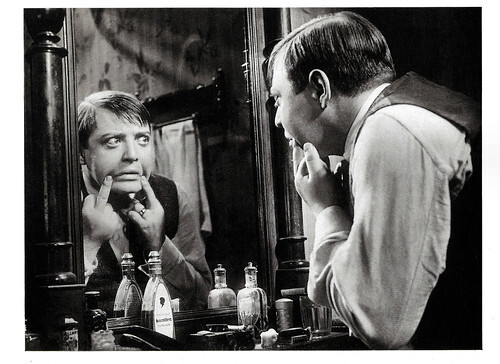
Swiss-British-German postcard by News Productions, Baulmes and Stroud, Filmwelt Berlin, Bakede, no. 56537. Photo: Collection Cinémathèque Suisse / Nero Film. Peter Lorre in M – Eine Stadt sucht einen Mörder/M (Fritz Lang, 1931).
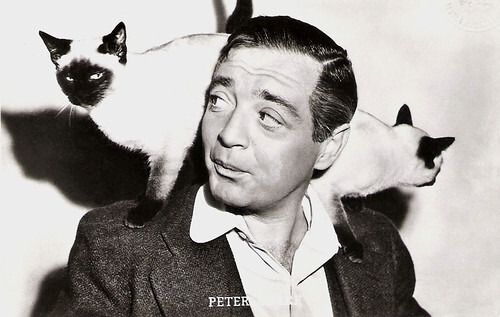
Dutch postcard, no. 850. Photo: Warner Bros.
Bertold Brecht
Peter Lorre was born László Löwenstein in 1904 in the Austro-Hungarian town of Ružomberok in Slovakia, then known by its Hungarian name Rózsahegy. He was the first child of Jewish couple Alajos Löwenstein and Elvira Freischberger. His father was the chief bookkeeper at a local textile mill. Besides working as a bookkeeper, Alajos Löwenstein also served as a lieutenant in the Austrian army reserve, which meant that he was often away on military maneuvers.
When Lorre was four years old, his mother died, probably of food poisoning, leaving Alajos with three very young sons, the youngest only a couple of months old. He soon remarried, to his wife's best friend, Melanie Klein, with whom he had two more children. However, Lorre and his stepmother never got along, and this coloured his childhood memories.
At the outbreak of the Second Balkan War in 1913, Alajos moved the family to Vienna, anticipating that this would lead to a larger conflict and that he would be called up. He was right. In 1914 followed the outbreak of World War I. He served on the Eastern front during the winter of 1914-1915, before being put in charge of a prison camp due to heart trouble.
As a youth, Peter Lorre ran away from home, worked as a bank clerk, and after stage training in Vienna, made his acting debut in Zurich in Switzerland at the age of 17. In Vienna, he worked with the Viennese Art Nouveau artist and puppeteer Richard Teschner. He then moved to the then German town of Breslau, and later to Zürich.
In the late 1920s, Peter Lorre moved to Berlin, where the young and short (165 cm) actor worked with German playwright Bertolt Brecht. He made his film debut in a bit role in the Austrian silent film Die Verschwundene Frau/The vanished woman (Karl Leitner, 1929), followed by another small part in the German drama Der weiße Teufel/The White Devil (Alexandre Volkoff, 1930) starring Ivan Mozzhukhin .
On stage and in the cinema, Lorre played a role in Brecht's Mann ist Mann/A Man's a Man (Bertolt Brecht, Carl Koch, 1930) and as Dr. Nakamura in the stage musical 'Happy End' (music by composer Kurt Weill), alongside Brecht's wife Helene Weigel, Oskar Homolka and Kurt Gerron.
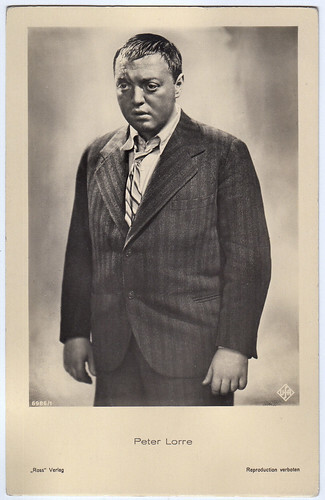
German postcard by Ross Verlag, no. 6989/1, 1931-1932. Photo: Ufa. Publicity still for Schuß im Morgengrauen/A Shot at Dawn (Alfred Zeisler, 1932). Collection: Marlene Pilaete.
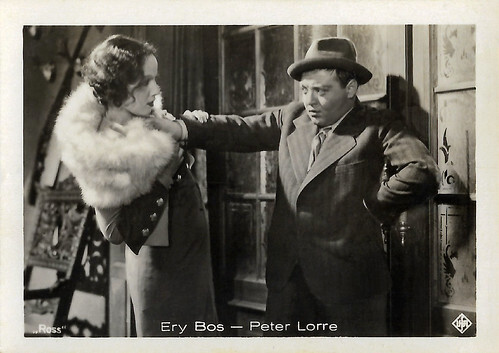
German collectors card by Ross Verlag for Jasmatzi Cigarettenfabrik G.m.b.H., Dresden, in the series 'Hänsom Filmbilder, Serie V, Bild no. 84 (1-147). Photo: Ufa. Ery Bos and Peter Lorre in Schuss im Morgengrauen/A Shot at Dawn (Alfred Zeisler, 1932).
Fritz Lang
Peter Lorre became much better known after director Fritz Lang cast him in the lead role of Hans Beckert, the mentally ill child murderer in the classic thriller M (1931).
Later, the Nazi propaganda film Der ewige Jude/The Eternal Jew (Fritz Hippler, 1940) used an excerpt from the climactic scene in M in which Lorre is trapped by vengeful citizens. His passionate plea that his compulsion is uncontrollable, says the voice-over, makes him sympathetic and is an example of attempts by Jewish artists to corrupt public morals.
M was Lang’s first sound film and he revealed the expressive possibilities of combining sound and visuals. Lorre's character whistles the tune 'In the Hall of the Mountain King' from Edvard Grieg's 'Peer Gynt Suite No. 1'. Lorre himself could not whistle – it is actually Fritz Lang who is heard.
The film was one of the first to use a leitmotif, associating 'In the Hall of the Mountain King' with the Lorre character. Later in the film, the mere sound of the song lets the audience know that he is nearby, off-screen. This association of a musical theme with a particular character or situation, a technique borrowed from opera, is now a film staple.
Lorre’s next role was the German musical comedy Bomben auf Monte Carlo/Monte Carlo Madness (Hanns Schwarz, 1931) starring Hans Albers and Anna Sten . That year he also co-starred in the comedy Die Koffer des Herrn O.F./The Trunks of Mr. O.F. (Alexis Granowsky, 1931) starring Alfred Abel , and Harald Paulsen.
In 1932 Lorre appeared again alongside Hans Albers in the drama Der weiße Dämon/The White Demon (Kurt Gerron, 1932) and the Science Fiction film F.P.1 antwortet nicht/F.P.1 Doesn't Respond (Karl Hartl, 1932) about an air station in the middle of the Atlantic Ocean. Curt Siodmak had written the story after Charles Lindbergh's transatlantic flight. It was the last German film that either Siodmak or Lorre, who played a secondary character, would make in Germany before the war.
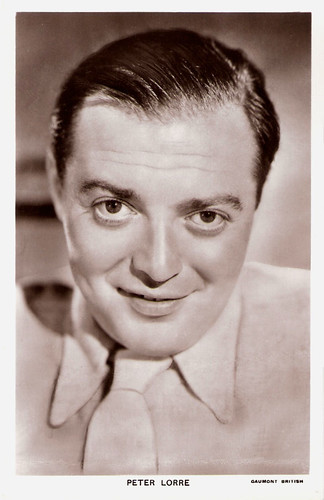
British postcard in the Picturegoer Series, London, no. 1033A. Photo: 20th Century Fox.
Alfred Hitchcock
When the Nazis came to power in Germany in 1933, Peter Lorre took refuge in Paris, where he appeared with Jean Gabin and Michel Simon in the charming comedy Du haut en bas/High and Low (Georg Wilhelm Pabst, 1933).
Then Lorre moved on to London. There Ivor Montagu, Alfred Hitchcock's associate producer for The Man Who Knew Too Much (1934), reminded the director about Lorre's performance in M. They first considered him to play the assassin in the film, but they wanted to use him in a larger role, despite his limited command of English at the time, which Lorre overcame by learning much of his part phonetically.
The Man Who Knew Too Much was one of the most successful and critically acclaimed films of Hitchcock's British period. Lorre also was featured in Hitchcock's Secret Agent (Alfred Hitchcock, 1936), opposite John Gielgud and Madeleine Carroll .
Lorre settled in Hollywood in 1935, where he specialised in playing sinister foreigners, beginning as the love-obsessed surgeon in the horror film Mad Love (Karl Freund, 1935), and as Raskolnikov in the Fyodor Dostoevsky adaptation Crime and Punishment (Josef von Sternberg, 1936).
He starred in a series of eight Mr. Moto movies for Twentieth Century Fox, a parallel to the better-known Charlie Chan series. Lorre played the ever-polite (albeit well versed in karate) Japanese detective Mr. Moto. According to Wikipedia , he did not enjoy these films — and twisted his shoulder during a stunt in Mr. Moto Takes a Vacation (Norman Foster, 1939) — but they were lucrative for the studio.
When the series folded in 1939, Lorre free-lanced in villainous roles at several studios. In 1940, he co-starred with fellow horror actors Bela Lugosi and Boris Karloff in the comedy You'll Find Out (David Butler, 1940), a vehicle for bandleader and radio personality Kay Kyser.
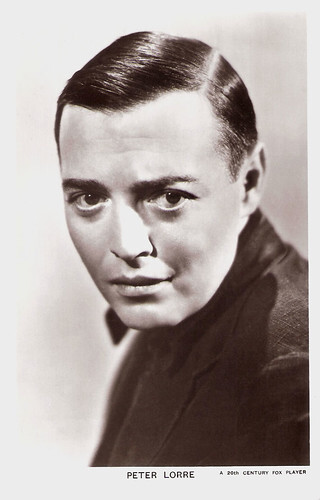
British postcard in the Picturegoer Series, London, no. 1033A. Photo: 20th Century Fox.
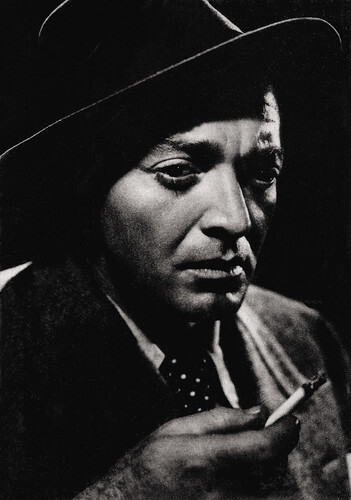
Postcard (ca. 1970s).
Sydney Greenstreet
In 1941, Peter Lorre became a naturalised citizen of the United States. He enjoyed considerable popularity as a featured player in Warner Bros. suspense and adventure films. Lorre played the role of effeminate thief Joel Cairo opposite Humphrey Bogart in The Maltese Falcon (John Huston, 1941), a classic Film Noir based on the novel of the same name by Dashiell Hammett.
The Maltese Falcon was Huston's directorial debut and the film was nominated for three Academy Awards. Then Lorre portrayed the character Ugarte in Casablanca (Michael Curtiz, 1942).
One of his co-stars in both films was Sydney Greenstreet with whom he made 9 films. Most of them were variations on Casablanca, including Background to Danger (Raoul Walsh, 1943), with George Raft, Passage to Marseille (Michael Curtiz, 1944), reuniting them with Humphrey Bogart and Claude Rains , and Three Strangers (Jean Negulesco, 1946).
Three Strangers was a suspense film about three people who are joint partners on a winning lottery ticket starring top-billed Greenstreet, Geraldine Fitzgerald, and third-billed Lorre cast against type by the director as the romantic lead.
Hal Erickson at AllMovie : “As far as director Jean Negulesco was concerned, Lorre was the finest actor in Hollywood; Negulesco fought bitterly with the studio brass for permission to cast Lorre as the sympathetic leading man in The Mask of Dimitrios (1946), in which the diminutive actor gave one of his finest and subtlest performances.”
Greenstreet and Lorre's final film together was the suspense thriller The Verdict (1946), director Don Siegel's first film. Lorre branched out into comedy with the role of Dr. Einstein in Frank Capra's version of Arsenic and Old Lace (1944), starring Cary Grant and Raymond Massey.
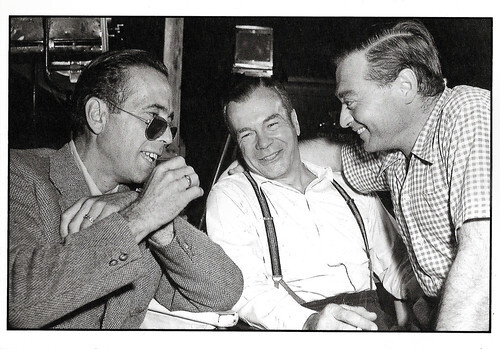
French postcard in the Entr'acte series by Éditions Asphodèle. Mâcon, no. 001/14. Humphrey Bogart , Gordon Carveth, and Peter Lorre at the set of Confidential Agent (Herman Shumlin, 1945). Caption: Humphrey Bogart and Gordon Carveth visit their friend Peter Lorre on the set of Confidential Agent; Lorre is the star.
Trailer M (1931). Source: HD Retro Trailers (YouTube).
James Bond Villain
After World War II, Peter Lorre's acting career in Hollywood experienced a downturn, whereupon he concentrated on radio and stage work. An exception was the horror classic The Beast with Five Fingers (Robert Florey, 1946).
In Germany, Lorre co-wrote, directed, and starred in Der Verlorene/The Lost One (1951), an art film in the Film Noir idiom. Hal Erickson: “In keeping with Lorre's established screen persona, this is a tale of stark terror, disillusionment, and defeatism. The actor stars as Dr. Rothe, a German research scientist who during WW2 discovers that his fiancée has been selling his scientific secrets to the British. In a fit of pique, he murders her but is not punished for the crime, which is passed off by the Nazi authorities as justifiable homicide. (...) Not entirely successful, Der Verlorene is still a fascinating exercise in fatalism from one of the cinema's most distinctive talents.”
Lorre then returned to the United States where he appeared as a character actor in television and feature films, often parodying his 'creepy' image. In 1954, he was the first actor to play a James Bond villain when he portrayed Le Chiffre in a television adaptation of Casino Royale, opposite Barry Nelson as an American James Bond and Linda Christian as the first Bond girl.
Lorre starred alongside Kirk Douglas and James Mason in 20,000 Leagues under the Sea (Richard Fleischer, 1954), and appeared in a supporting role in Voyage to the Bottom of the Sea (Irwin Allen, 1961). He worked with Roger Corman on several low-budget films, including two of the director's Edgar Allan Poe cycle, Tales of Terror (1962) and The Raven (1963).
Peter Lorre was married three times: actress Celia Lovsky (1934–1945); actress Kaaren Verne (1945–1950) and Anne Marie Brenning (1953-1964, his death). In 1953, Brenning bore his only child, Catharine. In later life, Catharine made headlines after serial killer Kenneth Bianchi confessed to police investigators after his arrest that he and his cousin and fellow Hillside Strangler Angelo Buono, disguised as police officers, had stopped her in 1977 with the intent of abducting and murdering her. They let her go upon learning that she was the daughter of Peter Lorre. It was only after Bianchi was arrested that Catharine realised whom she had met. Catharine died in 1985 of complications arising from diabetes.
Lorre had suffered for years from chronic gallbladder troubles, for which doctors had prescribed morphine. Lorre became trapped between the constant pain and addiction to morphine to ease the problem. It was during the period of the Mr. Moto films that Lorre struggled and overcame his addiction. Abruptly gaining a hundred pounds in a very short period and never fully recovering from his addiction to morphine, Lorre suffered many personal and career disappointments in his later years.
His final film was the Jerry Lewis comedy The Patsy (Jerry Lewis, 1964) in which, ironically, the dourly demonic Lorre played a director of comedy films. A few months after completing this film, Peter Lorre died of a stroke in 1964 in Los Angeles. He was 59.
Trailer The Man Who Knew Too Much (1934). Source: Jeff Sabu (YouTube).
Der Verlorene/The Lost One (1951). Source: chpthncook37 (YouTube).
Sources: Hal Erickson (AllMovie), (IMDb), Wikipedia, and .
His voice summons angels and demons, his body and face are those of a child heavy with guilt. All in all, Lorre’s life, his films, his unrealised dreams, and his physical presence constitute one of the most honest representations of 20th-century man, writes Horwath at the festival site. 'Instead of wholeness and triumph, there is the half-full, half-empty result of traversing through Central European modernism and fascism, addiction and exile, the culture of money and fame, the mirror cabinet of faces and masks.

Swiss-British-German postcard by News Productions, Baulmes and Stroud, Filmwelt Berlin, Bakede, no. 56537. Photo: Collection Cinémathèque Suisse / Nero Film. Peter Lorre in M – Eine Stadt sucht einen Mörder/M (Fritz Lang, 1931).

Dutch postcard, no. 850. Photo: Warner Bros.
Bertold Brecht
Peter Lorre was born László Löwenstein in 1904 in the Austro-Hungarian town of Ružomberok in Slovakia, then known by its Hungarian name Rózsahegy. He was the first child of Jewish couple Alajos Löwenstein and Elvira Freischberger. His father was the chief bookkeeper at a local textile mill. Besides working as a bookkeeper, Alajos Löwenstein also served as a lieutenant in the Austrian army reserve, which meant that he was often away on military maneuvers.
When Lorre was four years old, his mother died, probably of food poisoning, leaving Alajos with three very young sons, the youngest only a couple of months old. He soon remarried, to his wife's best friend, Melanie Klein, with whom he had two more children. However, Lorre and his stepmother never got along, and this coloured his childhood memories.
At the outbreak of the Second Balkan War in 1913, Alajos moved the family to Vienna, anticipating that this would lead to a larger conflict and that he would be called up. He was right. In 1914 followed the outbreak of World War I. He served on the Eastern front during the winter of 1914-1915, before being put in charge of a prison camp due to heart trouble.
As a youth, Peter Lorre ran away from home, worked as a bank clerk, and after stage training in Vienna, made his acting debut in Zurich in Switzerland at the age of 17. In Vienna, he worked with the Viennese Art Nouveau artist and puppeteer Richard Teschner. He then moved to the then German town of Breslau, and later to Zürich.
In the late 1920s, Peter Lorre moved to Berlin, where the young and short (165 cm) actor worked with German playwright Bertolt Brecht. He made his film debut in a bit role in the Austrian silent film Die Verschwundene Frau/The vanished woman (Karl Leitner, 1929), followed by another small part in the German drama Der weiße Teufel/The White Devil (Alexandre Volkoff, 1930) starring Ivan Mozzhukhin .
On stage and in the cinema, Lorre played a role in Brecht's Mann ist Mann/A Man's a Man (Bertolt Brecht, Carl Koch, 1930) and as Dr. Nakamura in the stage musical 'Happy End' (music by composer Kurt Weill), alongside Brecht's wife Helene Weigel, Oskar Homolka and Kurt Gerron.

German postcard by Ross Verlag, no. 6989/1, 1931-1932. Photo: Ufa. Publicity still for Schuß im Morgengrauen/A Shot at Dawn (Alfred Zeisler, 1932). Collection: Marlene Pilaete.

German collectors card by Ross Verlag for Jasmatzi Cigarettenfabrik G.m.b.H., Dresden, in the series 'Hänsom Filmbilder, Serie V, Bild no. 84 (1-147). Photo: Ufa. Ery Bos and Peter Lorre in Schuss im Morgengrauen/A Shot at Dawn (Alfred Zeisler, 1932).
Fritz Lang
Peter Lorre became much better known after director Fritz Lang cast him in the lead role of Hans Beckert, the mentally ill child murderer in the classic thriller M (1931).
Later, the Nazi propaganda film Der ewige Jude/The Eternal Jew (Fritz Hippler, 1940) used an excerpt from the climactic scene in M in which Lorre is trapped by vengeful citizens. His passionate plea that his compulsion is uncontrollable, says the voice-over, makes him sympathetic and is an example of attempts by Jewish artists to corrupt public morals.
M was Lang’s first sound film and he revealed the expressive possibilities of combining sound and visuals. Lorre's character whistles the tune 'In the Hall of the Mountain King' from Edvard Grieg's 'Peer Gynt Suite No. 1'. Lorre himself could not whistle – it is actually Fritz Lang who is heard.
The film was one of the first to use a leitmotif, associating 'In the Hall of the Mountain King' with the Lorre character. Later in the film, the mere sound of the song lets the audience know that he is nearby, off-screen. This association of a musical theme with a particular character or situation, a technique borrowed from opera, is now a film staple.
Lorre’s next role was the German musical comedy Bomben auf Monte Carlo/Monte Carlo Madness (Hanns Schwarz, 1931) starring Hans Albers and Anna Sten . That year he also co-starred in the comedy Die Koffer des Herrn O.F./The Trunks of Mr. O.F. (Alexis Granowsky, 1931) starring Alfred Abel , and Harald Paulsen.
In 1932 Lorre appeared again alongside Hans Albers in the drama Der weiße Dämon/The White Demon (Kurt Gerron, 1932) and the Science Fiction film F.P.1 antwortet nicht/F.P.1 Doesn't Respond (Karl Hartl, 1932) about an air station in the middle of the Atlantic Ocean. Curt Siodmak had written the story after Charles Lindbergh's transatlantic flight. It was the last German film that either Siodmak or Lorre, who played a secondary character, would make in Germany before the war.

British postcard in the Picturegoer Series, London, no. 1033A. Photo: 20th Century Fox.
Alfred Hitchcock
When the Nazis came to power in Germany in 1933, Peter Lorre took refuge in Paris, where he appeared with Jean Gabin and Michel Simon in the charming comedy Du haut en bas/High and Low (Georg Wilhelm Pabst, 1933).
Then Lorre moved on to London. There Ivor Montagu, Alfred Hitchcock's associate producer for The Man Who Knew Too Much (1934), reminded the director about Lorre's performance in M. They first considered him to play the assassin in the film, but they wanted to use him in a larger role, despite his limited command of English at the time, which Lorre overcame by learning much of his part phonetically.
The Man Who Knew Too Much was one of the most successful and critically acclaimed films of Hitchcock's British period. Lorre also was featured in Hitchcock's Secret Agent (Alfred Hitchcock, 1936), opposite John Gielgud and Madeleine Carroll .
Lorre settled in Hollywood in 1935, where he specialised in playing sinister foreigners, beginning as the love-obsessed surgeon in the horror film Mad Love (Karl Freund, 1935), and as Raskolnikov in the Fyodor Dostoevsky adaptation Crime and Punishment (Josef von Sternberg, 1936).
He starred in a series of eight Mr. Moto movies for Twentieth Century Fox, a parallel to the better-known Charlie Chan series. Lorre played the ever-polite (albeit well versed in karate) Japanese detective Mr. Moto. According to Wikipedia , he did not enjoy these films — and twisted his shoulder during a stunt in Mr. Moto Takes a Vacation (Norman Foster, 1939) — but they were lucrative for the studio.
When the series folded in 1939, Lorre free-lanced in villainous roles at several studios. In 1940, he co-starred with fellow horror actors Bela Lugosi and Boris Karloff in the comedy You'll Find Out (David Butler, 1940), a vehicle for bandleader and radio personality Kay Kyser.

British postcard in the Picturegoer Series, London, no. 1033A. Photo: 20th Century Fox.

Postcard (ca. 1970s).
Sydney Greenstreet
In 1941, Peter Lorre became a naturalised citizen of the United States. He enjoyed considerable popularity as a featured player in Warner Bros. suspense and adventure films. Lorre played the role of effeminate thief Joel Cairo opposite Humphrey Bogart in The Maltese Falcon (John Huston, 1941), a classic Film Noir based on the novel of the same name by Dashiell Hammett.
The Maltese Falcon was Huston's directorial debut and the film was nominated for three Academy Awards. Then Lorre portrayed the character Ugarte in Casablanca (Michael Curtiz, 1942).
One of his co-stars in both films was Sydney Greenstreet with whom he made 9 films. Most of them were variations on Casablanca, including Background to Danger (Raoul Walsh, 1943), with George Raft, Passage to Marseille (Michael Curtiz, 1944), reuniting them with Humphrey Bogart and Claude Rains , and Three Strangers (Jean Negulesco, 1946).
Three Strangers was a suspense film about three people who are joint partners on a winning lottery ticket starring top-billed Greenstreet, Geraldine Fitzgerald, and third-billed Lorre cast against type by the director as the romantic lead.
Hal Erickson at AllMovie : “As far as director Jean Negulesco was concerned, Lorre was the finest actor in Hollywood; Negulesco fought bitterly with the studio brass for permission to cast Lorre as the sympathetic leading man in The Mask of Dimitrios (1946), in which the diminutive actor gave one of his finest and subtlest performances.”
Greenstreet and Lorre's final film together was the suspense thriller The Verdict (1946), director Don Siegel's first film. Lorre branched out into comedy with the role of Dr. Einstein in Frank Capra's version of Arsenic and Old Lace (1944), starring Cary Grant and Raymond Massey.

French postcard in the Entr'acte series by Éditions Asphodèle. Mâcon, no. 001/14. Humphrey Bogart , Gordon Carveth, and Peter Lorre at the set of Confidential Agent (Herman Shumlin, 1945). Caption: Humphrey Bogart and Gordon Carveth visit their friend Peter Lorre on the set of Confidential Agent; Lorre is the star.
Trailer M (1931). Source: HD Retro Trailers (YouTube).
James Bond Villain
After World War II, Peter Lorre's acting career in Hollywood experienced a downturn, whereupon he concentrated on radio and stage work. An exception was the horror classic The Beast with Five Fingers (Robert Florey, 1946).
In Germany, Lorre co-wrote, directed, and starred in Der Verlorene/The Lost One (1951), an art film in the Film Noir idiom. Hal Erickson: “In keeping with Lorre's established screen persona, this is a tale of stark terror, disillusionment, and defeatism. The actor stars as Dr. Rothe, a German research scientist who during WW2 discovers that his fiancée has been selling his scientific secrets to the British. In a fit of pique, he murders her but is not punished for the crime, which is passed off by the Nazi authorities as justifiable homicide. (...) Not entirely successful, Der Verlorene is still a fascinating exercise in fatalism from one of the cinema's most distinctive talents.”
Lorre then returned to the United States where he appeared as a character actor in television and feature films, often parodying his 'creepy' image. In 1954, he was the first actor to play a James Bond villain when he portrayed Le Chiffre in a television adaptation of Casino Royale, opposite Barry Nelson as an American James Bond and Linda Christian as the first Bond girl.
Lorre starred alongside Kirk Douglas and James Mason in 20,000 Leagues under the Sea (Richard Fleischer, 1954), and appeared in a supporting role in Voyage to the Bottom of the Sea (Irwin Allen, 1961). He worked with Roger Corman on several low-budget films, including two of the director's Edgar Allan Poe cycle, Tales of Terror (1962) and The Raven (1963).
Peter Lorre was married three times: actress Celia Lovsky (1934–1945); actress Kaaren Verne (1945–1950) and Anne Marie Brenning (1953-1964, his death). In 1953, Brenning bore his only child, Catharine. In later life, Catharine made headlines after serial killer Kenneth Bianchi confessed to police investigators after his arrest that he and his cousin and fellow Hillside Strangler Angelo Buono, disguised as police officers, had stopped her in 1977 with the intent of abducting and murdering her. They let her go upon learning that she was the daughter of Peter Lorre. It was only after Bianchi was arrested that Catharine realised whom she had met. Catharine died in 1985 of complications arising from diabetes.
Lorre had suffered for years from chronic gallbladder troubles, for which doctors had prescribed morphine. Lorre became trapped between the constant pain and addiction to morphine to ease the problem. It was during the period of the Mr. Moto films that Lorre struggled and overcame his addiction. Abruptly gaining a hundred pounds in a very short period and never fully recovering from his addiction to morphine, Lorre suffered many personal and career disappointments in his later years.
His final film was the Jerry Lewis comedy The Patsy (Jerry Lewis, 1964) in which, ironically, the dourly demonic Lorre played a director of comedy films. A few months after completing this film, Peter Lorre died of a stroke in 1964 in Los Angeles. He was 59.
Trailer The Man Who Knew Too Much (1934). Source: Jeff Sabu (YouTube).
Der Verlorene/The Lost One (1951). Source: chpthncook37 (YouTube).
Sources: Hal Erickson (AllMovie), (IMDb), Wikipedia, and .
Published on June 30, 2022 22:00
June 29, 2022
Anthony Quinn
'The Drifter's escape: Hugo Fregonese' is one of the programmes of Il Cinema Ritrovato 2022. The Argentine-born Hugo Fregonese (1908-87) was the perfect ‘saddle tramp’ figure. He drifted and made films about drifting and escape. A master of brisk and unsentimental Westerns and crime thrillers, with a career spanning over four decades and numerous bases of production. He worked with Mexican-American actor Anthony Quinn (1915-2001) on Blowing Wild (1953).
Anthony Quinn started as a contract player at Paramount, where he mainly played villains and ethnic types. He moved to Broadway and replaced Marlon Brando in 'A Streetcar Named Desire'. This performance boosted his film career. For his role as Brando's brother in Viva Zapata! (Elia Kazan, 1952), Quinn won the Best Supporting Actor Academy Award. He gave one of his best performances as the circus strongman in Federico Fellini's masterpiece La Strada (1954). Quinn won his second Supporting Actor Oscar in 1957 for his role as Gauguin in Lust for Life (Vincente Minnelli, 1956), opposite Kirk Douglas as Vincent van Gogh. Over the next decades, Quinn alternated between Hollywood and European cinema, a drifter like Hugo Fregonese.
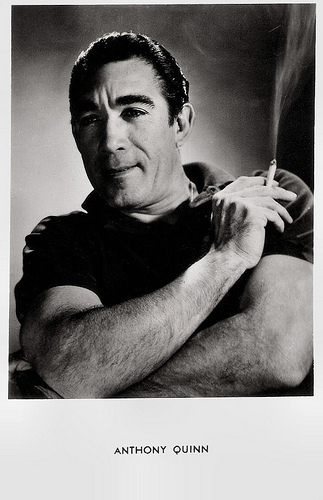
Dutch postcard, no. GR-5082.
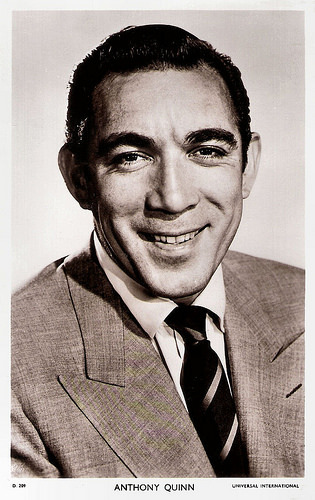
British postcard in the Picturegoer Series, London, no. D. 209. Photo: Universal International.
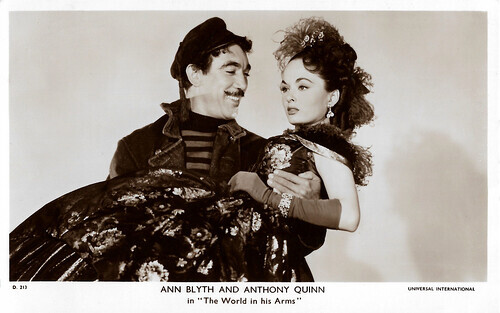
British postcard in the Picturegoer Series, London, no. D. 213. Photo: Universal International. Anthony Quinn and Ann Blyth in The World in his Arms (Raoul Walsh, 1952).
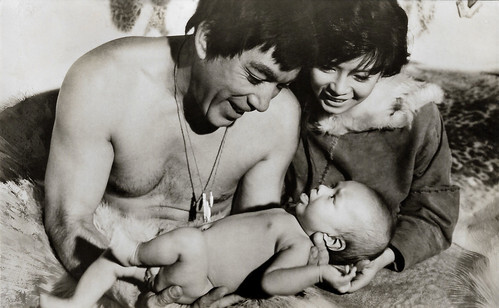
West-German card Photo: Rank Film. Anthony Quinn and Yoko Tani in The Savage Innocents (Nicholas Ray, 1959).
The Son-in-law of Cecil B. DeMille
Antonio Rudolfo Oaxaca Quinn was born in 1915, in Chihuahua, Mexico. His parents were Manuela (Oaxaca) and Francisco Quinn. After starting life in extremely modest circumstances in Mexico, his family moved to Los Angeles, where his father became an assistant cameraman at the Selig Film Studios. Quinn often accompanied his father to work and became acquainted with such stars as Tom Mix and John Barrymore, with whom he kept up the friendship into adulthood.
He attended Polytechnic High School and later Belmont High, but eventually dropped out. The young Quinn boxed which stood him in good stead as a stage actor, when years later, he played Stanley Kowalski in 'A Streetcar Named Desire'. He won a scholarship to study architecture under Frank Lloyd Wright at the great architect's studio, Taliesin, in Arizona. Quinn was close to Wright, who encouraged him when he decided to give acting a try.
After a brief apprenticeship on stage, Quinn hit Hollywood. He made his film debut with a character role in the crime drama Parole! (Lew Landers, 1936). Quinn picked up a variety of small roles in several films at Paramount, including a Cheyenne Indian in The Plainsman (1936), which was directed by his future father-in-law, Cecil B. DeMille . As a contract player at Paramount, Quinn mainly played villains and ethnic types, such as a gangster in the crime drama Dangerous to Know (Robert Florey, 1938), a Chinese gangster in Island of Lost Men (Kurt Neumann, 1939) and an Arab chieftain in the Bing Crosby-Bob Hope vehicle Road to Morocco (David Butler, 1942). He also played the sympathetic Crazy Horse in They Died with Their Boots On (Raoul Walsh, 1941) with Errol Flynn .
As a Mexican national (he did not become an American citizen until 1947), he was exempt from the draft. With many actors in the service fighting World War II, Quinn was able to move up into better supporting roles. He had married DeMille's daughter Katherine DeMille, which afforded him entrance to the top circles of Hollywood society. However, he became disenchanted with playing supporting parts as Chief Yellow Hand in Buffalo Bill (William A. Wellman, 1944) and a Chinese in China Sky (Ray Enright, 1945). His first lead was the Indian farmer Charlie Eagle in Black Gold (Phil Karlson, 1947) opposite his wife, Katherine DeMille.
By 1947, he had appeared in more than fifty films and was still not a major star. He did not renew his Paramount contract despite the advice of others, including his father-in-law whom Quinn felt never accepted him due to his Mexican roots. Instead, he returned to the stage. His portrayal of Stanley Kowalski in 'A Streetcar Named Desire' in Chicago and on Broadway, where he replaced Marlon Brando , made his reputation.
However, IMDb also gives another explanation for his move to the stage: “Became a naturalized United States citizen in 1947, just before he was ‘gray-listed’ for his association with Communists such as screenwriter John Howard Lawson and what were termed ‘fellow travellers’, though he himself was never called before the House of Un-American Activities Committee. When warned of his gray-listing by 20th Century-Fox boss Darryl F. Zanuck (a liberal), Quinn decided to go on the Broadway stage where there was no blacklist rather than go through the process of refuting the suspicions.”
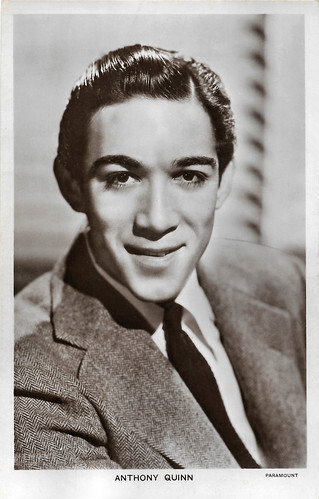
British postcard in the Picturegoer Series, London, no. 1380. Photo: Paramount.
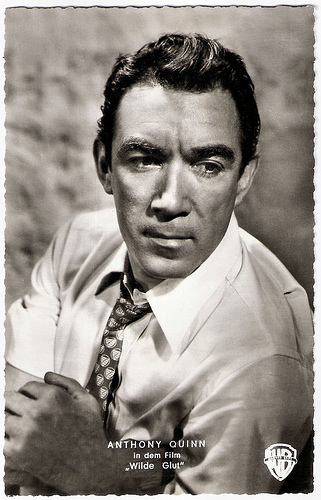
German postcard by Kunst und Bild, no. T 882. Photo: Warner Bros. Publicity still for Blowing Wild (Hugo Fregonese, 1953).
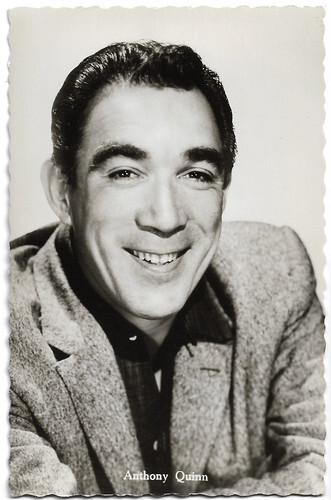
Dutch postcard by N.V. v.h. Weenenk & Snel, Baarn, no. 360. Photo: Paramount. Anthony Quinn in Hot Spell (Daniel Mann, 1958).
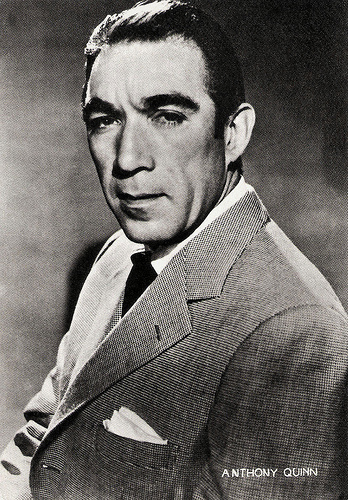
French postcard by Editions P.I. / Humour à la Carte, Paris, no. 3356. Photo: United Artists.
The first Mexican-American Oscar winner
Anthony Quinn’s success on Broadway boosted his film career. He returned to the cinema in The Brave Bulls (Robert Rossen, 1951). Director Elia Kazan then cast him as Marlon Brando 's brother in his biographical film of Mexican revolutionary Emiliano Zapata, Viva Zapata! (1952). Quinn won the Best Supporting Actor Academy Award in 1952, making him the first Mexican-American to win an Oscar.
It was not to be his lone appearance in the winner's circle: he won his second Supporting Actor Oscar five years later for his portrayal of painter Paul Gauguin in Vincente Minnelli's biographical film of Vincent van Gogh, Lust for Life (1956), opposite Kirk Douglas.
Over the next decade, Quinn lived in Italy and became a major figure in world cinema, as many studios shot films in Italy to take advantage of the lower costs. He appeared in several Italian films, giving one of his greatest performances as the dim-witted, thuggish and volatile circus strongman who brutalises the sweet soul played by Giulietta Masina in her husband Federico Fellini's masterpiece La Strada (1954).
Alternating between Europe and Hollywood, Quinn built his reputation and entered the front rank of character actors and character leads. He received his third Oscar nomination (and first for Best Actor) for Wild Is the Wind (George Cukor, 1957). Quinn starred in The Savage Innocents (Nicholas Ray, 1959) as Inuk, an Eskimo who finds himself caught between two clashing cultures. He played a Greek resistance fighter against the Nazi occupation in the box office hit The Guns of Navarone (J. Lee Thompson, 1961) and received praise for his portrayal of a once-great boxer on his way down in Requiem for a Heavyweight (Ralph Nelson, 1962).
Back on Broadway, he was nominated for the 1961 Tony Award as Best Actor (Dramatic) for his part as King Henry II opposite Laurence Olivier as Thomas Becket in 'Becket' (Becket ou l'honneur de Dieu) by Jean Anouilh. He returned to the cinema to play ethnic parts, such as an Arab warlord in David Lean's masterpiece Lawrence of Arabia (1962), and he played the eponymous lead in the Sword-and-sandal blockbuster Barabbas (Richard Fleischer, 1961) opposite Silvana Mangano .
Two years later, he reached the zenith of his career, playing Zorba in Alexis Zorbas/Zorba the Greek (Michael Cacoyannis, 1964), which brought him his fourth, and last, Oscar nomination as Best Actor. The 1960s were kind to him: he played character leads in such major films as The Shoes of the Fisherman (Michael Anderson, 1968) opposite Laurence Olivier , and The Secret of Santa Vittoria (Stanley Kramer, 1969), with Anna Magnani . However, his appearance in the title role in the film adaptation of John Fowles' novel, The Magus (Guy Green, 1968), did nothing to save the film, which was one of that decade's notorious turkeys.
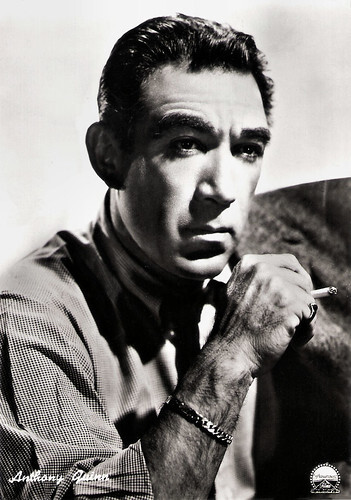
Italian postcard by Bromofoto, Milano, no. 1400. Photo: Paramount Films.
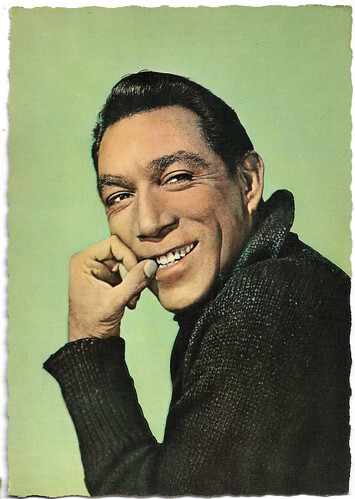
French postcard by E.D.U.G., no. 96.
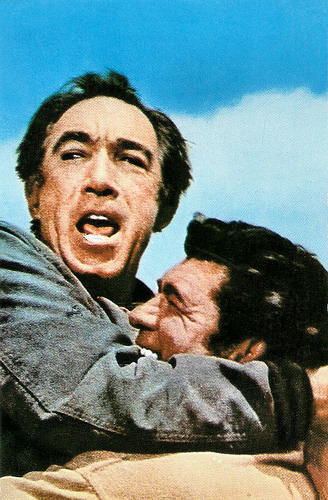
Romanian postcard by Casa Filmului Acin, no. 166. Photo: publicity still for Flap (Carol Reed, 1970).
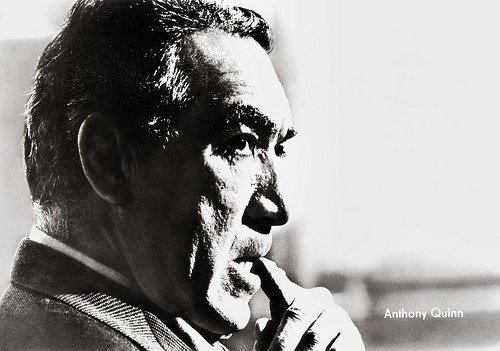
Big East-German collectors card by Progress Film-Verleih, Berlin, no. 15/82.
Not an authentic black hero
The following decade saw Anthony Quinn slip back into playing ethnic types again. He starred as the Hispanic mayor of a rapidly growing city in the Southwest United States in the TV series The Man and the City (1971).
IMDb writes about an interesting incident: “Around 1972, he announced his desire to play Henry Cristophe, the 19th-century emperor of Haiti. Upon this announcement, several prominent black actors, including Ossie Davis and Ellen Holly, stated that they were opposed to a ‘white man’ playing ‘black’. Davis stated, ‘My black children need black heroes on which to model their behaviour. Henry Cristophe is an authentic black hero. Tony, for all my admiration of him as a talent, will do himself and my children a great disservice if he encourages them to believe that only a white man and Tony is white to my children, is capable of playing a black hero.’”
Quinn’s career lost its momentum during the 1970s. Aside from playing a thinly disguised Aristotle Onassis in the cinematic roman-a-clef The Greek Tycoon (J. Lee Thompson, 1978), his other major roles of the decade were as Hamza in the controversial The Message/Mohammad, Messenger of God (Moustapha Akkad, 1976), as the Italian patriarch in L'eredità Ferramonti/The Inheritance (Mauro Bolognini, 1976) opposite Dominique Sanda , yet another Arab in Caravans (James Fargo, 1978) and a Mexican patriarch in The Children of Sanchez (Hall Bartlett, 1978) with Dolores Del Rio .
In 1983 he reprised his most famous role, Zorba the Greek, on Broadway in the revival of the musical Zorba, for 362 performances. Though his film career slowed during the 1990s, he continued to work steadily in films and television, such as in the HBO original crime drama Gotti: The Rise and Fall of a Real Life Mafia Don (Robert Harmon, 1996). Quinn lived out the latter years of his life in Bristol, Rhode Island, where he spent most of his time painting and sculpting. His final film was the Sylvester Stallone vehicle Avenging Angelo (Martyn Burke, 2002).
In 2001, Anthony Quinn died in a hospital in Boston from pneumonia and respiratory failure linked to his battle with lung cancer. Quinn was 86 years old. He was married three times. After divorcing Katherine DeMille in 1965, he married Italian costume designer Jolanda Addolori (1966-1997) and after their divorce his secretary, Kathy Benvin (1997-2001). He had ten children, five with DeMille, three with Addolori, and two with Benvin.
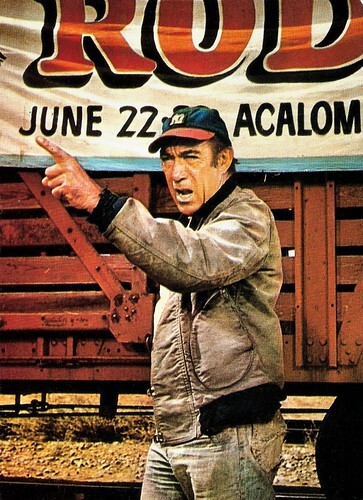
Romanian postcard by Casa Filmului Acin. Photo: publicity still for Flap (Carol Reed, 1970).
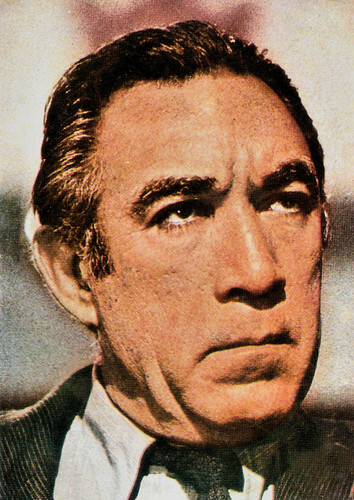
Romanian postcard by Casa Filmului Acin, no. 43078.
Trailer La Strada (1954). Source: Blondinka Inoz (YouTube).
Trailer Alexis Zorbas/Zorba the Greek (1964). Source: Fernando Braz (YouTube).
Trailer The Shoes of the Fisherman (1968). Source: Movieclips Trailer Vault (YouTube).
Sources: (IMDb), (IMDb), Wikipedia, and .
Anthony Quinn started as a contract player at Paramount, where he mainly played villains and ethnic types. He moved to Broadway and replaced Marlon Brando in 'A Streetcar Named Desire'. This performance boosted his film career. For his role as Brando's brother in Viva Zapata! (Elia Kazan, 1952), Quinn won the Best Supporting Actor Academy Award. He gave one of his best performances as the circus strongman in Federico Fellini's masterpiece La Strada (1954). Quinn won his second Supporting Actor Oscar in 1957 for his role as Gauguin in Lust for Life (Vincente Minnelli, 1956), opposite Kirk Douglas as Vincent van Gogh. Over the next decades, Quinn alternated between Hollywood and European cinema, a drifter like Hugo Fregonese.

Dutch postcard, no. GR-5082.

British postcard in the Picturegoer Series, London, no. D. 209. Photo: Universal International.

British postcard in the Picturegoer Series, London, no. D. 213. Photo: Universal International. Anthony Quinn and Ann Blyth in The World in his Arms (Raoul Walsh, 1952).

West-German card Photo: Rank Film. Anthony Quinn and Yoko Tani in The Savage Innocents (Nicholas Ray, 1959).
The Son-in-law of Cecil B. DeMille
Antonio Rudolfo Oaxaca Quinn was born in 1915, in Chihuahua, Mexico. His parents were Manuela (Oaxaca) and Francisco Quinn. After starting life in extremely modest circumstances in Mexico, his family moved to Los Angeles, where his father became an assistant cameraman at the Selig Film Studios. Quinn often accompanied his father to work and became acquainted with such stars as Tom Mix and John Barrymore, with whom he kept up the friendship into adulthood.
He attended Polytechnic High School and later Belmont High, but eventually dropped out. The young Quinn boxed which stood him in good stead as a stage actor, when years later, he played Stanley Kowalski in 'A Streetcar Named Desire'. He won a scholarship to study architecture under Frank Lloyd Wright at the great architect's studio, Taliesin, in Arizona. Quinn was close to Wright, who encouraged him when he decided to give acting a try.
After a brief apprenticeship on stage, Quinn hit Hollywood. He made his film debut with a character role in the crime drama Parole! (Lew Landers, 1936). Quinn picked up a variety of small roles in several films at Paramount, including a Cheyenne Indian in The Plainsman (1936), which was directed by his future father-in-law, Cecil B. DeMille . As a contract player at Paramount, Quinn mainly played villains and ethnic types, such as a gangster in the crime drama Dangerous to Know (Robert Florey, 1938), a Chinese gangster in Island of Lost Men (Kurt Neumann, 1939) and an Arab chieftain in the Bing Crosby-Bob Hope vehicle Road to Morocco (David Butler, 1942). He also played the sympathetic Crazy Horse in They Died with Their Boots On (Raoul Walsh, 1941) with Errol Flynn .
As a Mexican national (he did not become an American citizen until 1947), he was exempt from the draft. With many actors in the service fighting World War II, Quinn was able to move up into better supporting roles. He had married DeMille's daughter Katherine DeMille, which afforded him entrance to the top circles of Hollywood society. However, he became disenchanted with playing supporting parts as Chief Yellow Hand in Buffalo Bill (William A. Wellman, 1944) and a Chinese in China Sky (Ray Enright, 1945). His first lead was the Indian farmer Charlie Eagle in Black Gold (Phil Karlson, 1947) opposite his wife, Katherine DeMille.
By 1947, he had appeared in more than fifty films and was still not a major star. He did not renew his Paramount contract despite the advice of others, including his father-in-law whom Quinn felt never accepted him due to his Mexican roots. Instead, he returned to the stage. His portrayal of Stanley Kowalski in 'A Streetcar Named Desire' in Chicago and on Broadway, where he replaced Marlon Brando , made his reputation.
However, IMDb also gives another explanation for his move to the stage: “Became a naturalized United States citizen in 1947, just before he was ‘gray-listed’ for his association with Communists such as screenwriter John Howard Lawson and what were termed ‘fellow travellers’, though he himself was never called before the House of Un-American Activities Committee. When warned of his gray-listing by 20th Century-Fox boss Darryl F. Zanuck (a liberal), Quinn decided to go on the Broadway stage where there was no blacklist rather than go through the process of refuting the suspicions.”

British postcard in the Picturegoer Series, London, no. 1380. Photo: Paramount.

German postcard by Kunst und Bild, no. T 882. Photo: Warner Bros. Publicity still for Blowing Wild (Hugo Fregonese, 1953).

Dutch postcard by N.V. v.h. Weenenk & Snel, Baarn, no. 360. Photo: Paramount. Anthony Quinn in Hot Spell (Daniel Mann, 1958).

French postcard by Editions P.I. / Humour à la Carte, Paris, no. 3356. Photo: United Artists.
The first Mexican-American Oscar winner
Anthony Quinn’s success on Broadway boosted his film career. He returned to the cinema in The Brave Bulls (Robert Rossen, 1951). Director Elia Kazan then cast him as Marlon Brando 's brother in his biographical film of Mexican revolutionary Emiliano Zapata, Viva Zapata! (1952). Quinn won the Best Supporting Actor Academy Award in 1952, making him the first Mexican-American to win an Oscar.
It was not to be his lone appearance in the winner's circle: he won his second Supporting Actor Oscar five years later for his portrayal of painter Paul Gauguin in Vincente Minnelli's biographical film of Vincent van Gogh, Lust for Life (1956), opposite Kirk Douglas.
Over the next decade, Quinn lived in Italy and became a major figure in world cinema, as many studios shot films in Italy to take advantage of the lower costs. He appeared in several Italian films, giving one of his greatest performances as the dim-witted, thuggish and volatile circus strongman who brutalises the sweet soul played by Giulietta Masina in her husband Federico Fellini's masterpiece La Strada (1954).
Alternating between Europe and Hollywood, Quinn built his reputation and entered the front rank of character actors and character leads. He received his third Oscar nomination (and first for Best Actor) for Wild Is the Wind (George Cukor, 1957). Quinn starred in The Savage Innocents (Nicholas Ray, 1959) as Inuk, an Eskimo who finds himself caught between two clashing cultures. He played a Greek resistance fighter against the Nazi occupation in the box office hit The Guns of Navarone (J. Lee Thompson, 1961) and received praise for his portrayal of a once-great boxer on his way down in Requiem for a Heavyweight (Ralph Nelson, 1962).
Back on Broadway, he was nominated for the 1961 Tony Award as Best Actor (Dramatic) for his part as King Henry II opposite Laurence Olivier as Thomas Becket in 'Becket' (Becket ou l'honneur de Dieu) by Jean Anouilh. He returned to the cinema to play ethnic parts, such as an Arab warlord in David Lean's masterpiece Lawrence of Arabia (1962), and he played the eponymous lead in the Sword-and-sandal blockbuster Barabbas (Richard Fleischer, 1961) opposite Silvana Mangano .
Two years later, he reached the zenith of his career, playing Zorba in Alexis Zorbas/Zorba the Greek (Michael Cacoyannis, 1964), which brought him his fourth, and last, Oscar nomination as Best Actor. The 1960s were kind to him: he played character leads in such major films as The Shoes of the Fisherman (Michael Anderson, 1968) opposite Laurence Olivier , and The Secret of Santa Vittoria (Stanley Kramer, 1969), with Anna Magnani . However, his appearance in the title role in the film adaptation of John Fowles' novel, The Magus (Guy Green, 1968), did nothing to save the film, which was one of that decade's notorious turkeys.

Italian postcard by Bromofoto, Milano, no. 1400. Photo: Paramount Films.

French postcard by E.D.U.G., no. 96.

Romanian postcard by Casa Filmului Acin, no. 166. Photo: publicity still for Flap (Carol Reed, 1970).

Big East-German collectors card by Progress Film-Verleih, Berlin, no. 15/82.
Not an authentic black hero
The following decade saw Anthony Quinn slip back into playing ethnic types again. He starred as the Hispanic mayor of a rapidly growing city in the Southwest United States in the TV series The Man and the City (1971).
IMDb writes about an interesting incident: “Around 1972, he announced his desire to play Henry Cristophe, the 19th-century emperor of Haiti. Upon this announcement, several prominent black actors, including Ossie Davis and Ellen Holly, stated that they were opposed to a ‘white man’ playing ‘black’. Davis stated, ‘My black children need black heroes on which to model their behaviour. Henry Cristophe is an authentic black hero. Tony, for all my admiration of him as a talent, will do himself and my children a great disservice if he encourages them to believe that only a white man and Tony is white to my children, is capable of playing a black hero.’”
Quinn’s career lost its momentum during the 1970s. Aside from playing a thinly disguised Aristotle Onassis in the cinematic roman-a-clef The Greek Tycoon (J. Lee Thompson, 1978), his other major roles of the decade were as Hamza in the controversial The Message/Mohammad, Messenger of God (Moustapha Akkad, 1976), as the Italian patriarch in L'eredità Ferramonti/The Inheritance (Mauro Bolognini, 1976) opposite Dominique Sanda , yet another Arab in Caravans (James Fargo, 1978) and a Mexican patriarch in The Children of Sanchez (Hall Bartlett, 1978) with Dolores Del Rio .
In 1983 he reprised his most famous role, Zorba the Greek, on Broadway in the revival of the musical Zorba, for 362 performances. Though his film career slowed during the 1990s, he continued to work steadily in films and television, such as in the HBO original crime drama Gotti: The Rise and Fall of a Real Life Mafia Don (Robert Harmon, 1996). Quinn lived out the latter years of his life in Bristol, Rhode Island, where he spent most of his time painting and sculpting. His final film was the Sylvester Stallone vehicle Avenging Angelo (Martyn Burke, 2002).
In 2001, Anthony Quinn died in a hospital in Boston from pneumonia and respiratory failure linked to his battle with lung cancer. Quinn was 86 years old. He was married three times. After divorcing Katherine DeMille in 1965, he married Italian costume designer Jolanda Addolori (1966-1997) and after their divorce his secretary, Kathy Benvin (1997-2001). He had ten children, five with DeMille, three with Addolori, and two with Benvin.

Romanian postcard by Casa Filmului Acin. Photo: publicity still for Flap (Carol Reed, 1970).

Romanian postcard by Casa Filmului Acin, no. 43078.
Trailer La Strada (1954). Source: Blondinka Inoz (YouTube).
Trailer Alexis Zorbas/Zorba the Greek (1964). Source: Fernando Braz (YouTube).
Trailer The Shoes of the Fisherman (1968). Source: Movieclips Trailer Vault (YouTube).
Sources: (IMDb), (IMDb), Wikipedia, and .
Published on June 29, 2022 22:00
June 28, 2022
The Last Laugh, Part 2: Paul Morgan
For a few precious years, a decidedly light-hearted, sensual, and frivolous spirit swept through German cinemas. The musical comedies of the late Weimar Republic, produced in a short period between the coming of sound and the Nazi takeover, are some of the hidden gems of that era. Several are presented at this year’s Il Cinema Ritrovato in Bologna in the programme 'The Last Laugh: German musical comedies 1930-1932'. Rooted in the operetta tradition of the 19th century but adapted to contemporary aesthetics and mores, these films introduced popular comedians and singers to the movie audience, while celebrating the urbane, sophisticated, and hedonistic modernity of the Weimar Republic’s cultural scene.
One of these popular comedians was Austrian actor Paul Morgan (1886-1938), one of the great theatre stars of the Weimar republic. He co-founded the illustrious Berlin cabaret Kadeko with Max Hansen and made more than 100 films. In the 1930s Morgan refused to leave his homeland until it was too late. Arrested in March 1938, he died in Buchenwald concentration camp just months later.
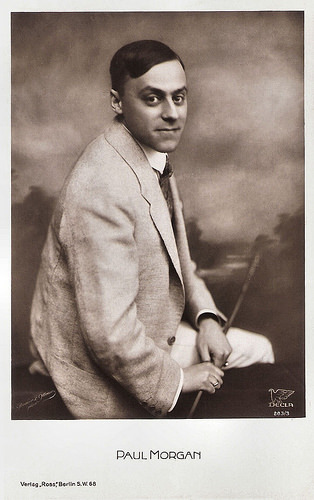
German postcard by Ross Verlag, Berlin, no. 283/3, 1919-1924. Photo: Decla. We could not identify the signature of the photographer. Rischke & Marby maybe?

Dutch postcard by JosPe, Arnhem, no. 54. Photo: Metro Goldwyn Mayer (MGM).
Simplicissimus
Paul Morgan was born as Georg Paul Morgenstern in 1886 in Vienna to an Austrian Jewish lawyer Gustav Morgenstern and his wife Clementine Morgenstern. He had a brother, Ernst Morgan, who would become an actor too. Like his parents, Paul was baptised and raised Catholic.
Since childhood, Paul wanted to pursue a life on the stage. Morgan studied theatre at the k.k. Akademie für Musik und darstellende Kunst, and he made his stage debut at the Theater in der Josefstadt. He performed in small theatres and cabarets.
In 1910 he made his film debut in the short La Miniature/The Miniature (Michel Carré, 1910) with Harry Baur . During the war, he managed to avoid the draft due to his flat feet; and got his first big break at the cabaret Simplicissimus (Simpl) in 1914. He also appeared at Rosa Valetti's Kabarett Größenwahn. In 1917 he got an engagement at the Lessingtheater in Berlin.
After the First World War, he had a successful film career. To his early silent films belong Die Puppe/The Doll (Ernst Lubitsch, 1919) with Ossi Oswalda , Die Reise um die Erde in 80 Tagen/Around the World in 80 Days (Richard Oswald, 1919) as well as Fritz Lang's successful productions Halbblut/The Half-Caste (1919) and Die Spinnen/The Spiders (1919-1920) with Carl de Vogt and Ressel Orla .
By the early 1920s, Morgan had become a star actor, singer, and writer. Along with Kurt Robitschek and Max Hansen , he opened the Kabarett der Komiker (in short Kadeko) in 1924 in Berlin. The cabaret was an innovative combination of variety show and intimate theatre and became one of the central comedy stages of Europe.
In the 1920s he also acted in very successful films, including Kurfürstendamm (Richard Oswald, 1920) with Conrad Veidt and Asta Nielsen , Vier um die Frau/Four Around a Woman (Fritz Lang, 1921), Die Brüder Schellenberg/The Brothers Schellenberg (Karl Grune, 1926) starring Conrad Veidt , and the Arthur Schnitzler adaptation Fräulein Else/Miss Else (Paul Czinner, 1929) with Elisabeth Bergner .
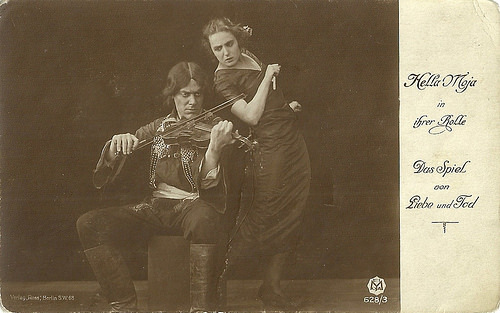
German postcard by Ross Verlag, no 628/3. Photo: Hella Moja-Film. Hella Moja and Paul Morgan in Das Spiel von Liebe und Tod/The Game of Love and Death (Urban Gad, 1919).
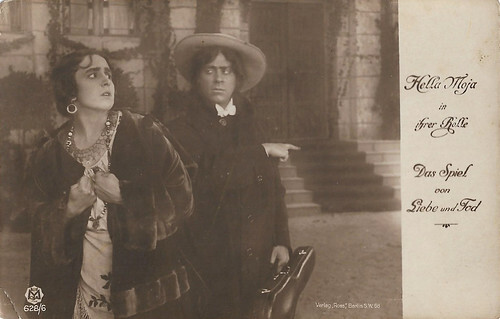
German postcard by Ross Verlag, no. 628/6. Photo: Hella Moja Film. Hella Moja and Paul Morgan in Das Spiel von Liebe und Tod/The Game of Love and Death (Urban Gad, 1919).
Kabarett der Komiker
In the late 1920s, Kadeko moved to a large new theatre in the centre of Berlin and expanded its scope, including guest appearances by famed international stars. The popularity of Paul Morgan increased.
He played in numerous films like Nur Du/Only You (Hermann Feiner, Willi Wolff, 1930), the popular operetta Zwei Herzen im Dreiviertel-Takt/Two Hearts in Waltz Time (Géza von Bolváry, 1930) with Willi Forst , and the comedy Ich und die Kaiserin/Me and the Empress (Friedrich Holländer, 1933) starring Lilian Harvey .
Morgan also made a name as a libretto author for musicals like 'Axel vor des Himmels Tor' (Axel before Heaven's Door), with which Zarah Leander launched her career.
In 1930, the cabaret was blacklisted by several newspapers and the SA physically invaded the theatre during an anti-Hitler satire. Morgan decided to leave Germany and went to Hollywood for nine months to make German language versions of Hollywood films for MGM including Casanova wider Willen/Casanova Against His Will (Edward Brophy, 1931) with Buster Keaton .
He tried out the cabaret scene in Switzerland and appeared shortly at Erika Mann's Pfeffermühle, but ultimately he ended up back in Austria. He found it difficult to support himself in the increasingly reactionary Vienna. Morgan only played a small part in the film Katharina, die Letzte/Catherine the Last (Hermann Kosterlitz/Henry Koster, 1936) starring Franciska Gaal .
He did not want to leave, hoping, like so many, to ride out what was thought to be a temporary right-wing government. Just a few days after the Anschluss of Austria in 1938, Paul Morgan was arrested and deported to the concentration camp Dachau. The Gestapo specified as the motive that Paul Morgan was in possession of a letter from politician Gustav Stresemann but the letter was old. His Jewish roots were the real reason.
Soon thereafter Morgan was transported to Buchenwald, where he died on 10 December 1938 because of pneumonia he got during an inhuman punishment drill in one of the coldest winters in Europe ever. Paul Morgan was 52. He was married to Josefine Lederer.
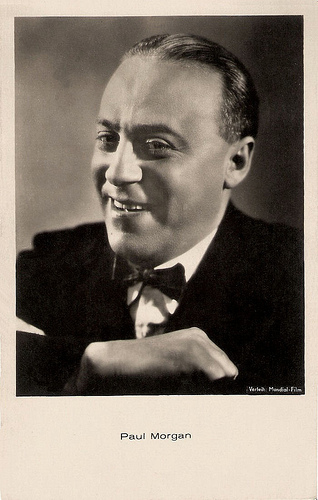
German postcard by Iris Verlag, no. 6387. Photo: Verleih Mondial-Film.
Paul Morgan - Model for the Conferencier (MC) of the Kit Kat Klub. Source: John Hall (YouTube).
Sources: World ORT, Thomas Staedeli (Cyranos), Österreichisches Kabarettarchiv (German), Wikipedia (German) and .
One of these popular comedians was Austrian actor Paul Morgan (1886-1938), one of the great theatre stars of the Weimar republic. He co-founded the illustrious Berlin cabaret Kadeko with Max Hansen and made more than 100 films. In the 1930s Morgan refused to leave his homeland until it was too late. Arrested in March 1938, he died in Buchenwald concentration camp just months later.

German postcard by Ross Verlag, Berlin, no. 283/3, 1919-1924. Photo: Decla. We could not identify the signature of the photographer. Rischke & Marby maybe?

Dutch postcard by JosPe, Arnhem, no. 54. Photo: Metro Goldwyn Mayer (MGM).
Simplicissimus
Paul Morgan was born as Georg Paul Morgenstern in 1886 in Vienna to an Austrian Jewish lawyer Gustav Morgenstern and his wife Clementine Morgenstern. He had a brother, Ernst Morgan, who would become an actor too. Like his parents, Paul was baptised and raised Catholic.
Since childhood, Paul wanted to pursue a life on the stage. Morgan studied theatre at the k.k. Akademie für Musik und darstellende Kunst, and he made his stage debut at the Theater in der Josefstadt. He performed in small theatres and cabarets.
In 1910 he made his film debut in the short La Miniature/The Miniature (Michel Carré, 1910) with Harry Baur . During the war, he managed to avoid the draft due to his flat feet; and got his first big break at the cabaret Simplicissimus (Simpl) in 1914. He also appeared at Rosa Valetti's Kabarett Größenwahn. In 1917 he got an engagement at the Lessingtheater in Berlin.
After the First World War, he had a successful film career. To his early silent films belong Die Puppe/The Doll (Ernst Lubitsch, 1919) with Ossi Oswalda , Die Reise um die Erde in 80 Tagen/Around the World in 80 Days (Richard Oswald, 1919) as well as Fritz Lang's successful productions Halbblut/The Half-Caste (1919) and Die Spinnen/The Spiders (1919-1920) with Carl de Vogt and Ressel Orla .
By the early 1920s, Morgan had become a star actor, singer, and writer. Along with Kurt Robitschek and Max Hansen , he opened the Kabarett der Komiker (in short Kadeko) in 1924 in Berlin. The cabaret was an innovative combination of variety show and intimate theatre and became one of the central comedy stages of Europe.
In the 1920s he also acted in very successful films, including Kurfürstendamm (Richard Oswald, 1920) with Conrad Veidt and Asta Nielsen , Vier um die Frau/Four Around a Woman (Fritz Lang, 1921), Die Brüder Schellenberg/The Brothers Schellenberg (Karl Grune, 1926) starring Conrad Veidt , and the Arthur Schnitzler adaptation Fräulein Else/Miss Else (Paul Czinner, 1929) with Elisabeth Bergner .

German postcard by Ross Verlag, no 628/3. Photo: Hella Moja-Film. Hella Moja and Paul Morgan in Das Spiel von Liebe und Tod/The Game of Love and Death (Urban Gad, 1919).

German postcard by Ross Verlag, no. 628/6. Photo: Hella Moja Film. Hella Moja and Paul Morgan in Das Spiel von Liebe und Tod/The Game of Love and Death (Urban Gad, 1919).
Kabarett der Komiker
In the late 1920s, Kadeko moved to a large new theatre in the centre of Berlin and expanded its scope, including guest appearances by famed international stars. The popularity of Paul Morgan increased.
He played in numerous films like Nur Du/Only You (Hermann Feiner, Willi Wolff, 1930), the popular operetta Zwei Herzen im Dreiviertel-Takt/Two Hearts in Waltz Time (Géza von Bolváry, 1930) with Willi Forst , and the comedy Ich und die Kaiserin/Me and the Empress (Friedrich Holländer, 1933) starring Lilian Harvey .
Morgan also made a name as a libretto author for musicals like 'Axel vor des Himmels Tor' (Axel before Heaven's Door), with which Zarah Leander launched her career.
In 1930, the cabaret was blacklisted by several newspapers and the SA physically invaded the theatre during an anti-Hitler satire. Morgan decided to leave Germany and went to Hollywood for nine months to make German language versions of Hollywood films for MGM including Casanova wider Willen/Casanova Against His Will (Edward Brophy, 1931) with Buster Keaton .
He tried out the cabaret scene in Switzerland and appeared shortly at Erika Mann's Pfeffermühle, but ultimately he ended up back in Austria. He found it difficult to support himself in the increasingly reactionary Vienna. Morgan only played a small part in the film Katharina, die Letzte/Catherine the Last (Hermann Kosterlitz/Henry Koster, 1936) starring Franciska Gaal .
He did not want to leave, hoping, like so many, to ride out what was thought to be a temporary right-wing government. Just a few days after the Anschluss of Austria in 1938, Paul Morgan was arrested and deported to the concentration camp Dachau. The Gestapo specified as the motive that Paul Morgan was in possession of a letter from politician Gustav Stresemann but the letter was old. His Jewish roots were the real reason.
Soon thereafter Morgan was transported to Buchenwald, where he died on 10 December 1938 because of pneumonia he got during an inhuman punishment drill in one of the coldest winters in Europe ever. Paul Morgan was 52. He was married to Josefine Lederer.

German postcard by Iris Verlag, no. 6387. Photo: Verleih Mondial-Film.
Paul Morgan - Model for the Conferencier (MC) of the Kit Kat Klub. Source: John Hall (YouTube).
Sources: World ORT, Thomas Staedeli (Cyranos), Österreichisches Kabarettarchiv (German), Wikipedia (German) and .
Published on June 28, 2022 22:00
June 27, 2022
The last laugh, Part 1: Max Hansen
For a few precious years, a decidedly light-hearted, sensual and frivolous spirit swept through German movie theatres. The musical comedies of the late Weimar Republic, produced in a short period between the coming of sound and before the Nazi takeover are some of the hidden gems of that era, presented at this year’s Il Cinema Ritrovato festival in the programme 'The Last Laugh: German musical comedies 1930-1932'. Rooted in the operetta tradition of the 19th century but adapted to contemporary aesthetics and mores, these films introduced popular comedians and singers to the movie audience, while celebrating the urbane, sophisticated and hedonistic modernity of the Weimar Republic’s cultural scene.
One of the highlights of the programme is Das Kabinett des Dr. Larifari (1930) by Robert Wohlmuth, a parody of the silent expressionist classic, Das Cabinet des Dr. Caligari/The Cabinet of Dr. Caligari (Robert Wiene, 1920). The comedy was written by Max Hansen and Paul Morgan and they were also the stars. Tomorrow EFSP will focus on Morgan, but today's post presents the Danish cabaret artist, actor, comedian and singer Max Hansen (1897-1961), who was known as 'The Little Caruso'. During the 1920s, he was one of the most popular stars in Berlin.
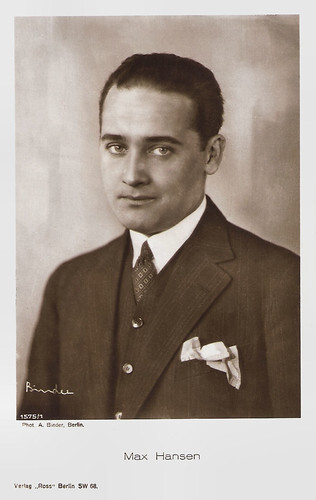
German postcard by Ross Verlag, no. 1575/1, 1927-1928. Photo: Alex Binder, Berlin.
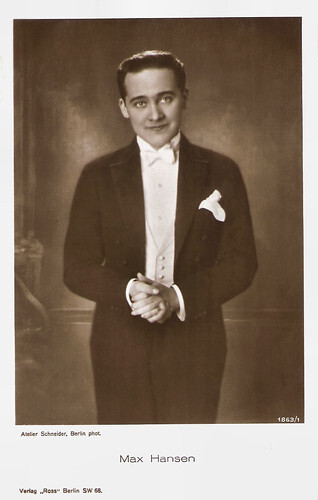
German postcard by Ross Verlag, no. 1863/1, 1927-1928. Photo: Atelier Schneider, Berlin.
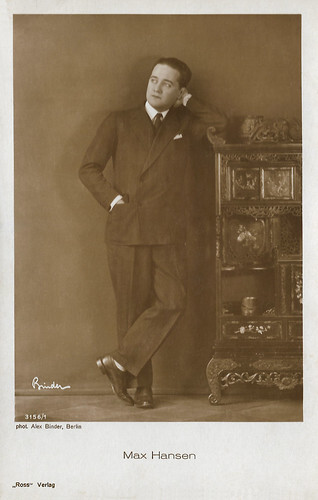
German postcard by Ross Verlag, no. 3156/1, 1928-1929. Photo: Alex Binder, Berlin.
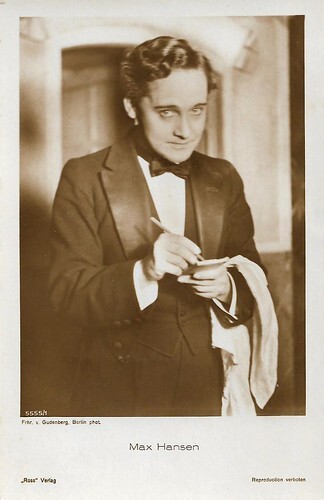
German postcard by Ross Verlag, no. 5555/1, 1930-1931. Photo: Freiherr von Gudenberg, Berlin.
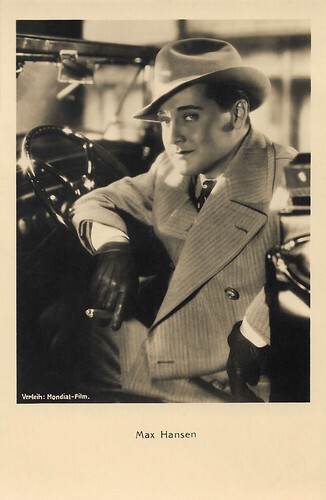
Austrian postcard by Iris Verlag, no. 6307. Photo: Mondial Film.
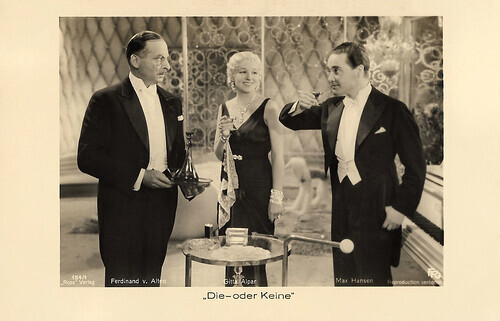
German postcard by Ross Verlag, no. 154/1. Photo: FFG (Carl Froelich Film Produktion). Ferdinand von Alten, Gitta Alpar and Max Hansen in Die - oder keine/She - or Nobody (Carl Froelich, 1932).
Who Takes Love Seriously?
Max Hansen was born Max Josef Haller in Mannheim, Imperial Germany in 1897. He was an illegitimate child to the Danish actress Eva Haller and the Swedish Officer Schürer von Waldheim (according to other sources he had a Jewish father, the Hungarian artist Joseph Walder). Max grew up with foster parents in Munich, where he first appeared at the Cabaret Simplizissimus at the age of 17. In 1914 he moved to Vienna, where he completed his studies as a ballad singer. Filmportal.de : “Thinking that it may perhaps be advantageous to draw attention to his Scandinavian origins, he changes his name to Hansen. Profiting from his powerful, highly modulating voice, he becomes known as the ‘little Caruso’ in cabarets and variety theatres, performing comical couplets, sketches and opera parodies.”
In 1923, Hansen was discovered by Hubert Marischka. He asked him for the tenor role of Baron Kolomán Zsupán in the Emmerich Kálmán operetta 'Gräfin Mariza' (Countess Mariza) at the Theater an der Wien in Vienna. After 900 performances, the popular production moved to the Metropoltheater in Berlin, where Hansen became also very successful. In Berlin, he founded the KadeKo, the Kabarett der Komiker (the Cabaret of Comedians) with Paul Morgan and Kurt Robitschek in 1924. Hansen was engaged by Max Reinhardt for his revival of Jacques Offenbach's 'La belle Hélène', and by Erik Charell for his production of Franz Lehar's 'Die lustige Witwe' (The Merry Widow). Hansen's greatest stage success was playing Leopold the waiter in Ralph Benatzky's operetta-musical 'Im weißen Rößl' (The White Horse Inn) in 1930.
He had already undertaken this part in the silent film Im weißen Rößl/The White Horse Inn (Richard Oswald, 1926) with Liane Haid . A year earlier, he had made his film debut in Husarenfieber/Hussars Fever (Georg Jacoby, 1925) with Georg Alexander . In the following years he appeared in popular silent films like Familie Schimeck/The Schimeck Family (Alfred Halm, Rudolf Dworsky, 1926), and Venus im Frack/Venus in evening dress (Robert Land, 1927) with Carmen Boni . From 1925 on, Hansen also recorded his own hits, which audiences appreciated for their parody and cabaret-like wit.
His real film career began in the sound film era. His first sound film was Wien, du Stadt der Lieder/Vienna, City of Song (Richard Oswald, 1930) with Charlotte Ander and Paul Morgan . The excellent singer was soon pinned down for swinging musicals and comedies. He found an ideal partner in Jenny Jugo in films like Wer nimmt die Liebe ernst.../Who Takes Love Seriously? (Erich Engel, 1931). He also played opposite Gitta Alpár in Die - oder keine/She, or Nobody (Carl Froelich, 1932).
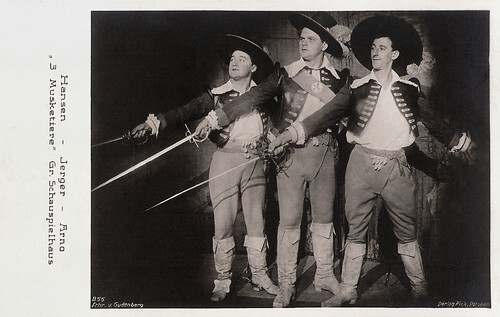
German postcard by Verlag Piek, Postdam, no. 855. Photo: Frhr. von Gudenberg. Max Hansen, Alfred Jerger and Siegfried Arno in the play 'Die drei Musketiere' (The Three Musketeers) (1929) at the Grosse Schauspielhaus.
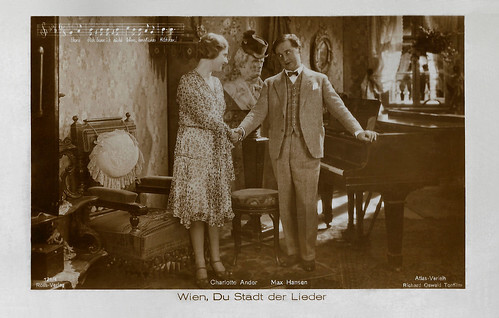
German postcard by Ross Verlag, no. 121/1. Photo: Richard Oswald Tonfilm / Atlas Verleih. Charlotte Ander and Max Hansen in Wien, Du Stadt der Lieder/Vienna, City of Song (Richard Oswald, 1930).
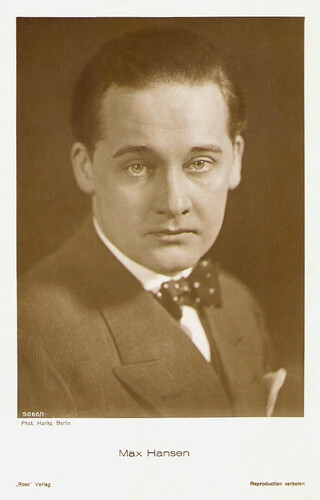
German postcard by Ross Verlag, no. 5060/1, 1930-1931. Photo: Harlip, Berlin.
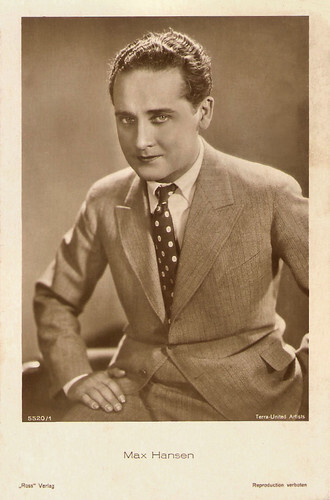
German postcard by Ross Verlag, no. 5520/1, 1930-1931. Photo: Terra / United Artists.
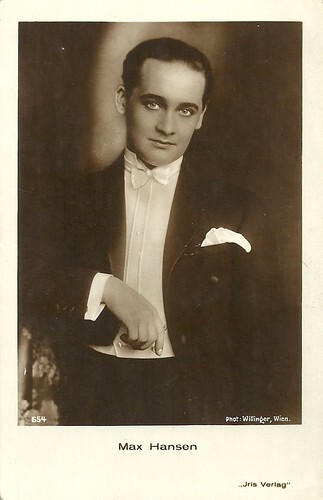
Austrian postcard by Iris Verlag, no. 654. Photo: Willinger, Vienna.
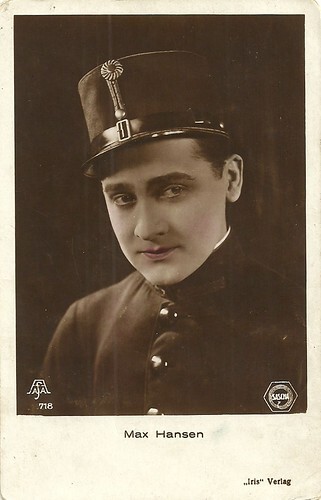
Austrian postcard by Iris Verlag, no. 718. Photo: Sascha Film / Aafa.
Have you ever been in love with me?
Max Hansen satirized Adolf Hitler as a homosexual with his song War'n Sie schon mal in mich verliebt? (Have you ever been in love with me?), which caused the rage of the Nazis. He was thrown with tomatoes at the premiere of the comedy Das häßliche Mädchen/The Ugly Girl (Hermann Kosterlitz, 1933). The film was made in early 1933, during the transition from the Weimar Republic to Nazi Germany, and premièred in September that year. According to Wikipedia , the film's representation of the ‘ugly girl’ as an outsider has been described as a metaphorical way to explore the outsider existence of Jews. Star Dolly Haas and director Hermann Kosterlitz, both Jewish, left Germany and later worked in the United States, where Kosterlitz became well known as Henry Koster.
Hansen returned to Vienna and worked again at the Theater an der Wien. He starred in the film Csardas (Jacob Fleck, Luise Fleck, Walter Kolm-Veltée, 1935) with Irén Zilahy. He also performed in Switzerland, Amsterdam, Oslo and Helsinki. In 1936 he met Zarah Leander on a Scandinavian tour and engaged her as his stage partner in the operetta 'Axel an der Himmels Tür' (Axel at Heaven’s Gate), with music by Ralph Benatzky, produced in Theater an der Wien. It was a hit. After Austria was invaded by Germany in 1938, Hansen emigrated to Denmark, where he founded his own theatre at Copenhagen. He also appeared in Danish films like Tror du jeg er født i går!/Do you think I was born yesterday! (Lau Lauritzen, Jr., Alice O'Fredericks, 1941) and En flicka för mejA girl for me (Börje Larsson, 1943). In addition, he wrote several songs under the pseudonym ‘Sylvester’.
In 1951 he returned to Germany and was successful once again singing the role of Leopold the waiter in 'The White Horse Inn'. In 1953 Hansen moved back to Copenhagen, where he died in 1961. His final film appearance was in the Danish comedy Hvad vil De ha'?/What do you want? (Jens Henriksen, Preben Neergaard, 1956) starring Dirch Passer. Hansen was married to Austrian actress Lizzi Waldmüller till 1938 and since 1940 to Britta Annette Sylvester-Hvid. He had four children. His daughter Ann-Mari Max Hansen (1949) and his son Max Hansen Jr. (1954) are both actors too. In 2004 German director Douglas Wolfsperger portrayed Hansen in his documentary War'n Sie schon mal in mich verliebt?
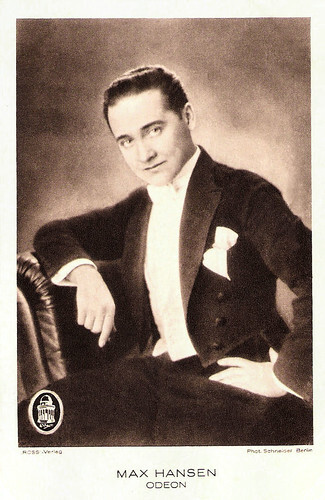
German postcard by Ross Verlag / Odeon. Photo: Schneider, Berlin.
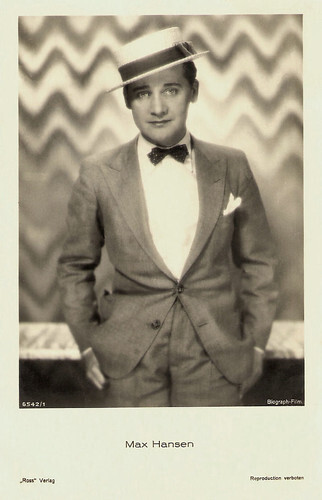
German postcard by Ross Verlag, no. 5542/1, 1930-1931. Photo: Biograph-Film.
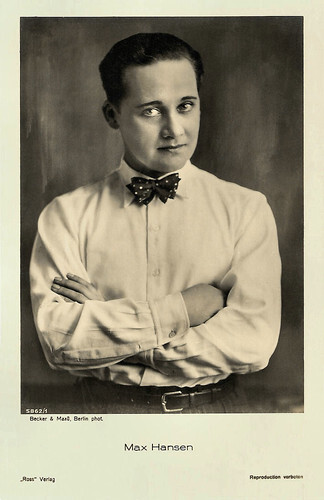
German postcard by Ross Verlag, no. 5862/1, 1930-1931. Photo: Becker & Maass, Berlin.
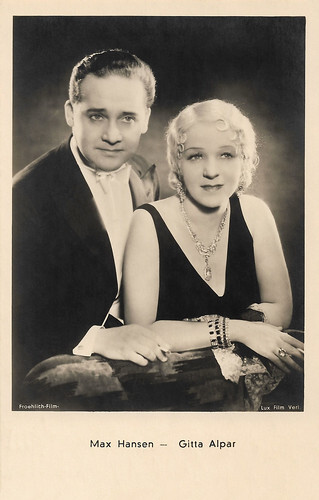
Austrian postcard by Iris Verlag, no. 6608. Photo: Froelich Film / Lux Film Verleih. Max Hansen and Gitta Alpar in Die - oder keine/She - or Nobody (Carl Froelich, 1932).
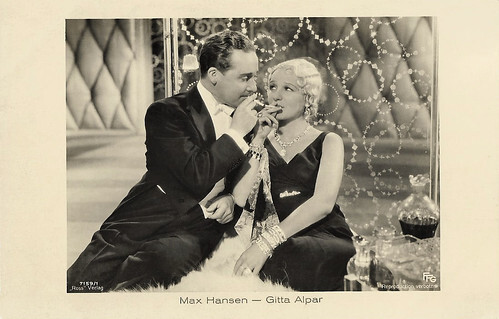
German postcard by Ross Verlag, no. 7159/1, 1932-1933. Photo: FFG. Max Hansen and Gitta Alpar in Die - oder keine/This One or None (Carl Froelich, 1932).
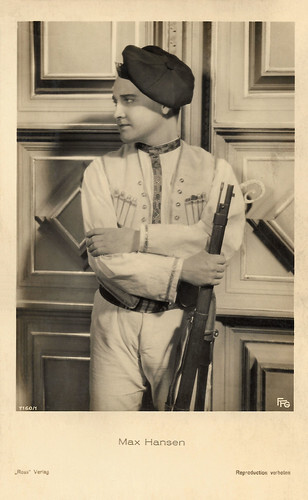
German postcard by Ross Verlag, no. 7160/1, 1932-1933. Photo: FFG. Max Hansen in Die - oder keine/She, or Nobody (Carl Froelich, 1932).
Max Hansen sings War'n Sie schon mal in mich verliebt?. Source: Edmolch (YouTube).
Sources: Thomas Staedeli (Cyranos), Stephanie D’heil (Steffi-line), (IMDb), Filmportal.de, Wikipedia, and .
One of the highlights of the programme is Das Kabinett des Dr. Larifari (1930) by Robert Wohlmuth, a parody of the silent expressionist classic, Das Cabinet des Dr. Caligari/The Cabinet of Dr. Caligari (Robert Wiene, 1920). The comedy was written by Max Hansen and Paul Morgan and they were also the stars. Tomorrow EFSP will focus on Morgan, but today's post presents the Danish cabaret artist, actor, comedian and singer Max Hansen (1897-1961), who was known as 'The Little Caruso'. During the 1920s, he was one of the most popular stars in Berlin.

German postcard by Ross Verlag, no. 1575/1, 1927-1928. Photo: Alex Binder, Berlin.

German postcard by Ross Verlag, no. 1863/1, 1927-1928. Photo: Atelier Schneider, Berlin.

German postcard by Ross Verlag, no. 3156/1, 1928-1929. Photo: Alex Binder, Berlin.

German postcard by Ross Verlag, no. 5555/1, 1930-1931. Photo: Freiherr von Gudenberg, Berlin.

Austrian postcard by Iris Verlag, no. 6307. Photo: Mondial Film.

German postcard by Ross Verlag, no. 154/1. Photo: FFG (Carl Froelich Film Produktion). Ferdinand von Alten, Gitta Alpar and Max Hansen in Die - oder keine/She - or Nobody (Carl Froelich, 1932).
Who Takes Love Seriously?
Max Hansen was born Max Josef Haller in Mannheim, Imperial Germany in 1897. He was an illegitimate child to the Danish actress Eva Haller and the Swedish Officer Schürer von Waldheim (according to other sources he had a Jewish father, the Hungarian artist Joseph Walder). Max grew up with foster parents in Munich, where he first appeared at the Cabaret Simplizissimus at the age of 17. In 1914 he moved to Vienna, where he completed his studies as a ballad singer. Filmportal.de : “Thinking that it may perhaps be advantageous to draw attention to his Scandinavian origins, he changes his name to Hansen. Profiting from his powerful, highly modulating voice, he becomes known as the ‘little Caruso’ in cabarets and variety theatres, performing comical couplets, sketches and opera parodies.”
In 1923, Hansen was discovered by Hubert Marischka. He asked him for the tenor role of Baron Kolomán Zsupán in the Emmerich Kálmán operetta 'Gräfin Mariza' (Countess Mariza) at the Theater an der Wien in Vienna. After 900 performances, the popular production moved to the Metropoltheater in Berlin, where Hansen became also very successful. In Berlin, he founded the KadeKo, the Kabarett der Komiker (the Cabaret of Comedians) with Paul Morgan and Kurt Robitschek in 1924. Hansen was engaged by Max Reinhardt for his revival of Jacques Offenbach's 'La belle Hélène', and by Erik Charell for his production of Franz Lehar's 'Die lustige Witwe' (The Merry Widow). Hansen's greatest stage success was playing Leopold the waiter in Ralph Benatzky's operetta-musical 'Im weißen Rößl' (The White Horse Inn) in 1930.
He had already undertaken this part in the silent film Im weißen Rößl/The White Horse Inn (Richard Oswald, 1926) with Liane Haid . A year earlier, he had made his film debut in Husarenfieber/Hussars Fever (Georg Jacoby, 1925) with Georg Alexander . In the following years he appeared in popular silent films like Familie Schimeck/The Schimeck Family (Alfred Halm, Rudolf Dworsky, 1926), and Venus im Frack/Venus in evening dress (Robert Land, 1927) with Carmen Boni . From 1925 on, Hansen also recorded his own hits, which audiences appreciated for their parody and cabaret-like wit.
His real film career began in the sound film era. His first sound film was Wien, du Stadt der Lieder/Vienna, City of Song (Richard Oswald, 1930) with Charlotte Ander and Paul Morgan . The excellent singer was soon pinned down for swinging musicals and comedies. He found an ideal partner in Jenny Jugo in films like Wer nimmt die Liebe ernst.../Who Takes Love Seriously? (Erich Engel, 1931). He also played opposite Gitta Alpár in Die - oder keine/She, or Nobody (Carl Froelich, 1932).

German postcard by Verlag Piek, Postdam, no. 855. Photo: Frhr. von Gudenberg. Max Hansen, Alfred Jerger and Siegfried Arno in the play 'Die drei Musketiere' (The Three Musketeers) (1929) at the Grosse Schauspielhaus.

German postcard by Ross Verlag, no. 121/1. Photo: Richard Oswald Tonfilm / Atlas Verleih. Charlotte Ander and Max Hansen in Wien, Du Stadt der Lieder/Vienna, City of Song (Richard Oswald, 1930).

German postcard by Ross Verlag, no. 5060/1, 1930-1931. Photo: Harlip, Berlin.

German postcard by Ross Verlag, no. 5520/1, 1930-1931. Photo: Terra / United Artists.

Austrian postcard by Iris Verlag, no. 654. Photo: Willinger, Vienna.

Austrian postcard by Iris Verlag, no. 718. Photo: Sascha Film / Aafa.
Have you ever been in love with me?
Max Hansen satirized Adolf Hitler as a homosexual with his song War'n Sie schon mal in mich verliebt? (Have you ever been in love with me?), which caused the rage of the Nazis. He was thrown with tomatoes at the premiere of the comedy Das häßliche Mädchen/The Ugly Girl (Hermann Kosterlitz, 1933). The film was made in early 1933, during the transition from the Weimar Republic to Nazi Germany, and premièred in September that year. According to Wikipedia , the film's representation of the ‘ugly girl’ as an outsider has been described as a metaphorical way to explore the outsider existence of Jews. Star Dolly Haas and director Hermann Kosterlitz, both Jewish, left Germany and later worked in the United States, where Kosterlitz became well known as Henry Koster.
Hansen returned to Vienna and worked again at the Theater an der Wien. He starred in the film Csardas (Jacob Fleck, Luise Fleck, Walter Kolm-Veltée, 1935) with Irén Zilahy. He also performed in Switzerland, Amsterdam, Oslo and Helsinki. In 1936 he met Zarah Leander on a Scandinavian tour and engaged her as his stage partner in the operetta 'Axel an der Himmels Tür' (Axel at Heaven’s Gate), with music by Ralph Benatzky, produced in Theater an der Wien. It was a hit. After Austria was invaded by Germany in 1938, Hansen emigrated to Denmark, where he founded his own theatre at Copenhagen. He also appeared in Danish films like Tror du jeg er født i går!/Do you think I was born yesterday! (Lau Lauritzen, Jr., Alice O'Fredericks, 1941) and En flicka för mejA girl for me (Börje Larsson, 1943). In addition, he wrote several songs under the pseudonym ‘Sylvester’.
In 1951 he returned to Germany and was successful once again singing the role of Leopold the waiter in 'The White Horse Inn'. In 1953 Hansen moved back to Copenhagen, where he died in 1961. His final film appearance was in the Danish comedy Hvad vil De ha'?/What do you want? (Jens Henriksen, Preben Neergaard, 1956) starring Dirch Passer. Hansen was married to Austrian actress Lizzi Waldmüller till 1938 and since 1940 to Britta Annette Sylvester-Hvid. He had four children. His daughter Ann-Mari Max Hansen (1949) and his son Max Hansen Jr. (1954) are both actors too. In 2004 German director Douglas Wolfsperger portrayed Hansen in his documentary War'n Sie schon mal in mich verliebt?

German postcard by Ross Verlag / Odeon. Photo: Schneider, Berlin.

German postcard by Ross Verlag, no. 5542/1, 1930-1931. Photo: Biograph-Film.

German postcard by Ross Verlag, no. 5862/1, 1930-1931. Photo: Becker & Maass, Berlin.

Austrian postcard by Iris Verlag, no. 6608. Photo: Froelich Film / Lux Film Verleih. Max Hansen and Gitta Alpar in Die - oder keine/She - or Nobody (Carl Froelich, 1932).

German postcard by Ross Verlag, no. 7159/1, 1932-1933. Photo: FFG. Max Hansen and Gitta Alpar in Die - oder keine/This One or None (Carl Froelich, 1932).

German postcard by Ross Verlag, no. 7160/1, 1932-1933. Photo: FFG. Max Hansen in Die - oder keine/She, or Nobody (Carl Froelich, 1932).
Max Hansen sings War'n Sie schon mal in mich verliebt?. Source: Edmolch (YouTube).
Sources: Thomas Staedeli (Cyranos), Stephanie D’heil (Steffi-line), (IMDb), Filmportal.de, Wikipedia, and .
Published on June 27, 2022 22:00
Paul van Yperen's Blog
- Paul van Yperen's profile
- 13 followers
Paul van Yperen isn't a Goodreads Author
(yet),
but they
do have a blog,
so here are some recent posts imported from
their feed.



